Archived Blog Posts
Commercial Sprinkler System
6/10/2022 (Permalink)
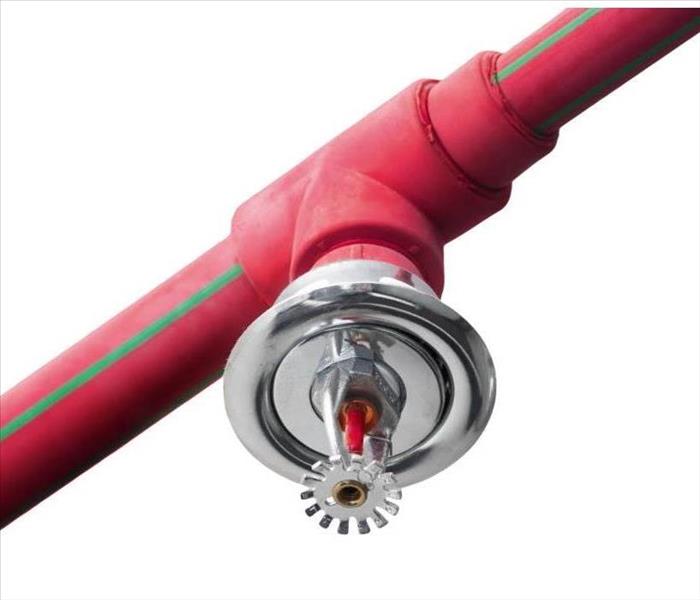 A commercial sprinkler head
A commercial sprinkler head
A commercial sprinkler system is a critical protective system in a variety of buildings. They are in hotels, restaurant, schools, and other facilities. The following are 4 reasons why it is important to have a sprinkler system in a commercial or multiple-dwelling setting.
Sprinklers Save Lives:
Having a sprinkler system can help buy time for people to evacuate from the property safely. The National Fire Protection Services has no more than two deaths per year on record with a building that has a functional sprinkler system.
Reduces Damage:
A functional sprinkler system can not only save lives, but it can save the property as well. There will still be some fire, smoke damage, and the obvious water damage, but the property will still be standing and the damage will be limited.
Reduces Insurance Premiums:
Not only can a sprinkler save lives, and the property, but some insurance companies will offer a discount on the premiums due to reduced risk.
Low Maintenance:
After the system has been installed, the required upkeep is very low. The requirement for a sprinkler system is to do an annual inspection. A qualified profession will make sure all the heads and the rest of the system are in good working order.
If your sprinkler system should go off, it is important to remove the water quickly. SERVPRO of Casper can help you get your facility back in good order.
Flood Watch, Warning, Emergency Definitions
4/1/2022 (Permalink)
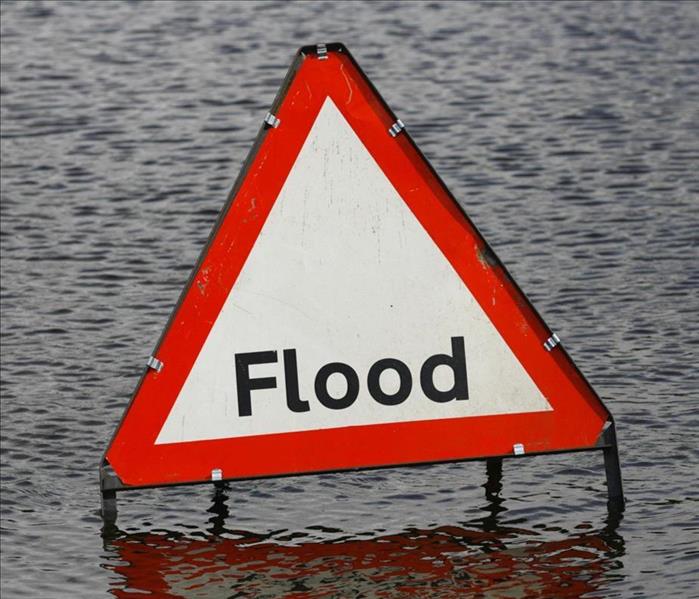 A sign that says flood
A sign that says flood
Spring is here, and so is the rain. There are some years we don’t get a whole lot of rain, and then there are years we deal with intense storms known as microbursts.
A microburst is a localized thunderstorm that is accompanied by significant precipitation. In Wyoming, our soil and drainage systems are not designed to take on a lot of rain at one time, compared to other parts of the country. Because of this, flash flooding may occur. So it is important to understand what a flash flood watch, flash flood warning, and flash flood emergency is. With this knowledge, will better understand how to handle the situation. According to the National Weather Service, this is what they mean.
Flash Flood Watch: When conditions look favorable for flash flooding. A WATCH usually includes several counties. This is the time to start preparing for possible flooding. Consider where you would go if water began to rise.
Flash Flood Warning: When dangerous flash flooding is happening or will happen soon. A WARNING is a smaller, more specific area. It can be issued if the excessive heavy rain is going to cause failure to a dam or levee. You need to act quickly. Flash floods are an imminent threat to you and your family. You could have only seconds to move to higher ground.
Flash Flood Emergency: For the exceedingly rare situations when extremely heavy rain is severe and is a threat to human life, and cause catastrophic damage. Emergency officials are reporting life-threatening water rises, requiring water rescues/evacuations.
Care for Your Water Heater
3/17/2022 (Permalink)
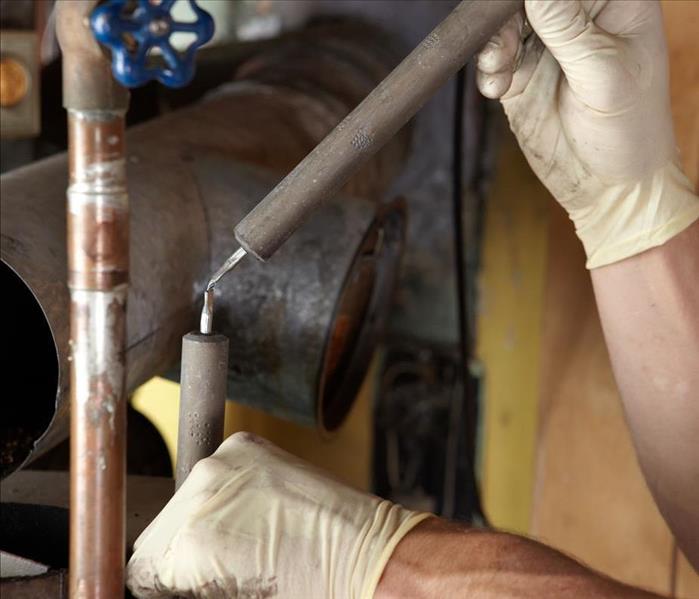 A homeowner that is maintaining his water heater.
A homeowner that is maintaining his water heater.
Most people think that once their new water heater is installed, that it does not require routine maintenance. But that is incorrect. There are a few things you should do to maximize your water heater’s efficiency and longevity.
Here are some maintenance tips:
1. Test the Temperature-Pressure Release (TPR) Valve
Shut off the power (or gas control) and the cold water supply valve. Place a bucket under the pipe connected to the TPR valve. Lift the valve’s tab to let some water out, then let it go. If the water keeps flowing, drain a little bit more water and install a new one.
2. Check the Anode Rod
Connect a hose to the tanks drain cock and let out a few gallons of water. Get a 1 1/16-inch socket and place it on the rod’s hex head on top of the water heater, and unscrew the rod. If its less than an ½ inch thick, or coated with calcium, it is a good time to buy a new one. If you install a new rod, make sure you apply teflon tape the threads, and securely tighten the new anode rod.
3. Flush the Tank of Sediments
As you are working on the heater and already have some of the water drained, drain the rest of the tank into a bucket. Stir up the sediment on the bottom of tank by briefly opening the cold water supply valve. Drain and repeat until clean water comes out.
4. Adjust the Temperature
When you have located the temperature dial, unscrew its cover. Adjust the dial to 120 degrees. For every 10 degrees the temperature is lowered, you can save up to 5 percent in energy costs.
If you are not going to be home for a few days, turn the water heater down or off. This will help save money as well.
5. Insulate the pipes and water heater body
Buy 3/8 – inch thick foam pipe insulation that fits the pipes. Buy enough to cover the hot and cold water pipes. Insulating the cold pipe will help with condensation during the summer time. When wrapping the water heater with an insulation blanket, do not cover the top of the unit.
Be sure to check on your water heater regularly for any rusting, calcium build up, or malfunctions. It is easy for the bottom to rust out, or one of the fittings to rust on the top of the unit and cause a water damage.
Contents Affected By Water Damage
3/1/2022 (Permalink)
 Water Damaged Contents
Water Damaged Contents
When a water damage happens, it can be devastating. The flooring, walls, and sometimes contents can get wet and damaged. Unfortunately, if a water damage should happen, any contents in contact with the floor typically get affected as well. I’m going to give you tips on how to protect your home’s contents until help arrives.
If there is furniture sitting on wet carpet, place aluminum foil, tupperware lids, or unfinished wood blocks underneath the feet. This will help get the furniture out of direct contact with the carpet, and will help prevent futher damage to furniture legs, and protect the carpet from furniture stains.
If there are affected contents that are nonporous (items that can not soak up water, such as plastics, glass, etc.) use a towel to wipe the items off. With fabric materials, get as much water out of them first. Then, if they are machine washable, run them through the washer and dryer. If there are contents that are porous (items that can soak up water, such as wood, paper, area rugs, etc.) it is best to get them laid out in an unaffected area so they can start air drying. Porous materials that contain organic materials need attention right away so the damage does not get worse. If allowed to stay wet, these materials have a high risk of developing mold growth.
The tips that where given above is based water damage caused by clean water. Flood water and sewage backups potentially contain hazardous substances, and should not be handled without proper protection and safety precautions. If you have a loss that is from sewage or flooding, please consult the professionals first. Your safety is our top concern.
Commercial Water Sources
2/23/2022 (Permalink)
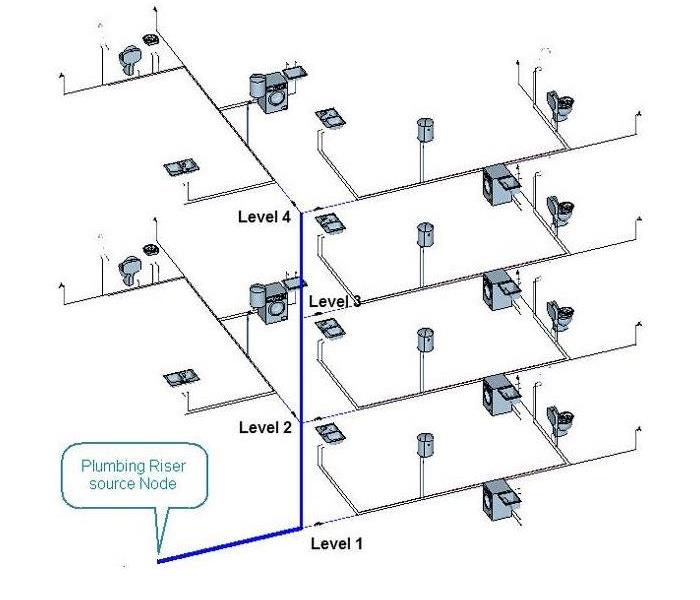 Water lines for bathrooms, kitchens, and laundry rooms.
Water lines for bathrooms, kitchens, and laundry rooms.
Commercial properties contain a myriad of water sources. Kitchens, restrooms, laundry rooms, and utility areas have an assortment of sinks, fixtures, supply lines, appliances, and drains. Each of these items can potentially fail, resulting in water damage.
Good maintenance and inspection practices can help reduce the risk of water damage. But despite the best preventative measures, indoor water leaks and breakages are inevitable. When water damage occurs, timely response is critical.
Water spreads quickly throughout commercial structures. It tends to follow cracks, and creases in flooring. It also readily soaks into absorbent materials, such as carpet, pad, and drywall.
Never wait to get help. The sooner water removal services begin, the faster everything will dry. It will also reduce the amount of damage to materials by limiting water migration, and will help save you money.
Having a water damage or sewer back up can be overwhelming and stressful. Finding all hidden water, and properly drying out your facility, is very important. That is where SERVPRO of Casper comes in. We have IICRC (Institute of Inspection Cleaning and Restoration Certification) certified technicians on call 24/7, that can respond quickly to mitigate the damage and save your property.
Office Safety
2/11/2022 (Permalink)
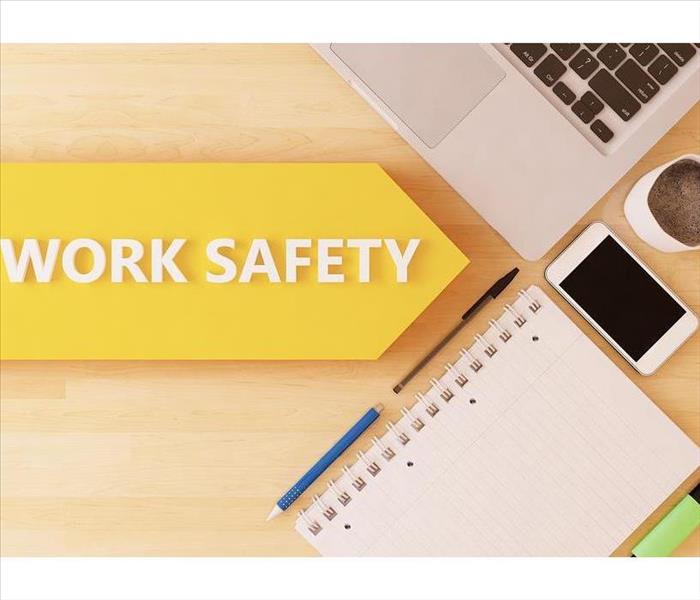 It's a desk setting with a laptop, cup of coffee, notebook, pen, and pencil, and phone, with sign that says work Safety
It's a desk setting with a laptop, cup of coffee, notebook, pen, and pencil, and phone, with sign that says work Safety
In manufacturing or industrial settings, businesses are very mindful of safety in the workplace. “Safety First” is a common phrase, because of the hazardous nature of these types of work. But it is very easy to forget the office environment, and the safety concerns there. Safety issues that get overlooked the most include ergonomics, the walk from the car to the office, the headset that being worn all day, and others. Here are some office safety concerns, and tips on how to fix them.
Physical Inactivity / sitting too long: Sitting for extended periods of time without movement puts office workers at risk for numerous health concerns. Going for small walks around the block, and doing leg, arm, and back exercises will help keep the circulation in your body moving.
Entering and leaving the office: watch for debris, such as rocks, trash, and uneven ground. Winter can bring on icy roads and parking lots. Shuffling your feet, or walking flat foot with slow short steps (like a penguin) will help prevent slipping.
The use of a headset: Wearing a telephone headset all day, or cradling the phone between your ear and shoulder can cause back and neck pain. Try taking off the headset periodically, and switching the phone between different shoulders will help. Doing neck and back exercises can be helpful as well.
Keeping your area cleaned up: Clean up spills right away. Keep piles of clutter away from walking paths. Keep electrical and phone cords tucked away so they don’t get tripped on.
Know your emergency procedures: Make sure you know where the exits are, and the location of fire extinguishers throughout the building.
Roof Leaks
1/28/2022 (Permalink)
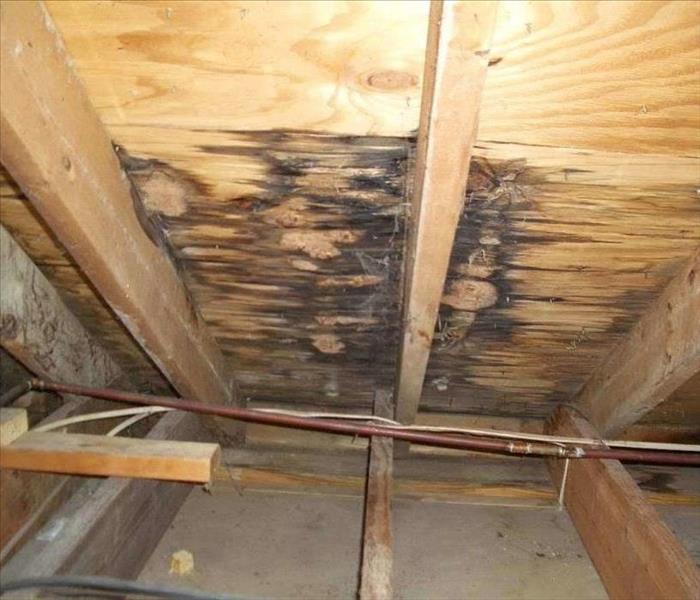 A wood ceiling in an attic showing signs of a roof leak for a long period of time.
A wood ceiling in an attic showing signs of a roof leak for a long period of time.
There are many sources in a home that can create water damage. There could be a broken pipe, washing machine malfunction, a water heater failure, among others. But another source some don’t think about until it happens is the roof. Typically, home or business owners do not climb their building to visually inspect their on a regular basis. Until there is water dripping, or dark discoloration forming on the ceiling, it’s easy not knowing if there is missing shingles or areas that have worn over time.
Performing inspections on the property from time to time would help identify problem areas in advance. A good place to start an inspection is the attic (if the building has one), as it rarely gets checked. Look at the decking and trusses, and see if there are any signs of water staining or water dripping. When cleaning out the gutters in the fall on some roofs, it is a great time to look at the overall condition of the roof. Inspect the shingles for any damage, as well as the edges.
The most common sign of roof leaks are water marks or stains on the ceiling, water running down the wall, or bubbling paint on the ceiling or wall. If there is a slow leak for an extended period of time, there could be a musty odor. This can be a sign of fungal growth or rot.
If you had a roof leak and need structural drying, call SERVPRO of Casper today!
Space Heater Safety
1/28/2022 (Permalink)
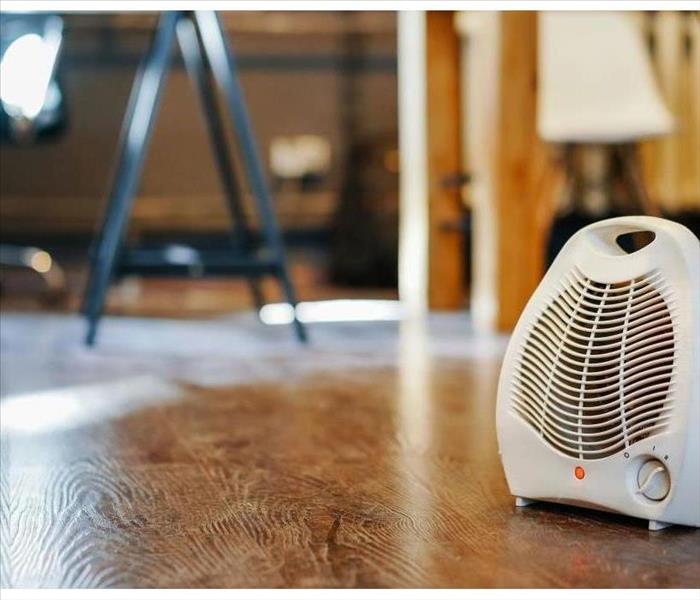 A space heater that is properly placed heating that area up.
A space heater that is properly placed heating that area up.
During the coldest months of winter, it’s not unusual to have areas in the home or office that are not adequately warmed up by your heating system. Space heaters are a common solution to adding heat to cold areas without increasing the temperature throughout the building by turning up the thermostat. But if it is used incorrectly, a space heater can create additional risks and hazards. If misused, it can cause fire or smoke damage to the property.
Following these tips this can help prevent a disaster caused by a space heater:
Make sure the heater is on a level, hard floor. Don’t place on carpets or area rugs.
Keep at least three feet away from flammable materials .
Keep away from loose fabric, such as drapes or hanging towels.
Keep out of reach of children and pets.
Always plug directly into the wall. Do not use extension cords or power strips.
Don’t leave heater unattended.
Always unplug when not in use.
Make sure there are smoke alarms on every floor of the property.
We at SERVPRO of Casper hope you have a safe and warm winter.
Getting Ready for Winter
1/25/2022 (Permalink)
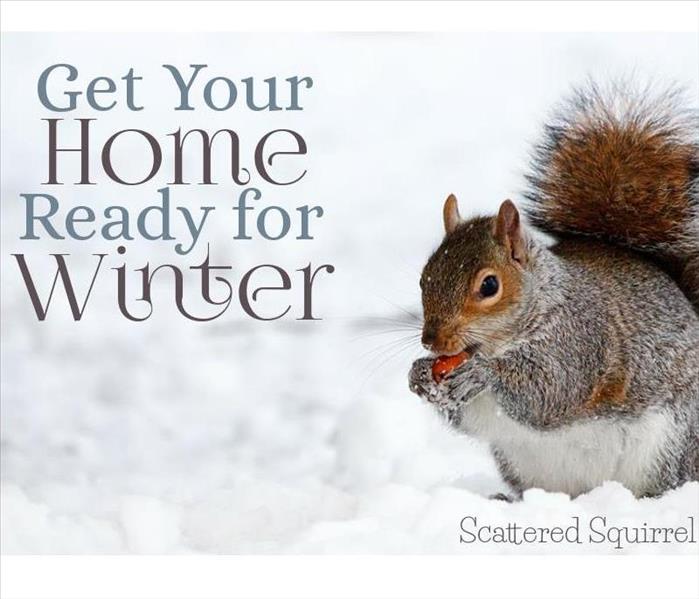 A squirrel getting ready for winter.
A squirrel getting ready for winter.
During the cold months of our Wyoming winter, the low temperatures can wreak havoc on your home. Ice damming on roofs, and pipe breakage from freezing, becomes a greater risk.
Here is a list of things you can do to help get your home ready for the winter:
In the fall, be sure to inspect the exterior of your home for any potential problem areas. Inspect your roof for any missing or damaged shingles. Check your windows for cracks and gaps.
When it is cold, heating your home becomes considerably more expensive. Making your home more energy efficient can help reduce this expense. Sealing door jambs, windows and openings to the home with weather stripping will reduce air drafting in and the heat going out. If you have any gaps on the exterior of your home, be sure to fix those with some caulking.
Clean and inspect your gutters. During the fall, leaves and twigs land and accumulate in the gutters, causing the gutters to lose their draining abilities. With the leaves building up, there is a risk of standing and freezing water.
Before temperatures start to drop, have your heating system checked by a professional. Whether it is a forced-air or boiler heat unit, a system that is running well is almost always more efficient and will save you time and money in the end!
Whether you have a water damage from the freezing temperatures or you need your ducts cleaned, SERVPRO of Casper is here for you anytime.
Disasters in the Healthcare Facilities
1/19/2022 (Permalink)
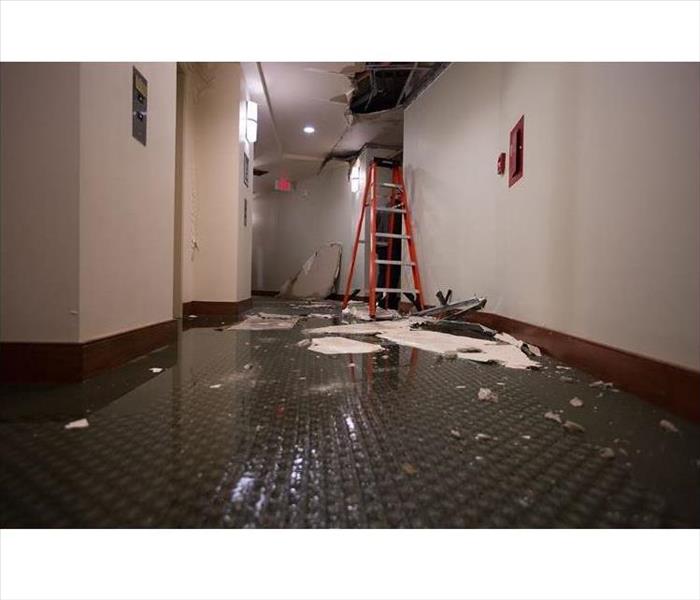 Wet tile that fell from the ceiling on a wet floor.
Wet tile that fell from the ceiling on a wet floor.
Disasters at healthcare facilities are complex. So when it comes to flood or fire in a medical facility not only does affect the employees, but it also affects the patients. So we like to get in and out as fast as possible to so there is little disruption. We understand that there is special training to handle regulated medical waste and comply with HIPPA regulations. Whether we’re dealing with a small medical office or a large hospital campus, SERVPRO of Casper works quickly and efficiently to assess your needs.
Types of facilities we can work on:
Regardless of the cause, size of the loss, or the size of your facility. SERVPRO of Casper are available day or night to help you with the damage. 307-235-6558
Water Damage Time Line
1/10/2022 (Permalink)
 A black and white clock
A black and white clock
Water emergencies come at the most inconvenient time. So when you have had a long day at work and come home to a soggy basement, it’s the last thing you want to deal with. Just know that SERVPRO of Casper is here to help. We provide emergency response 24 hours a day, 365 days a year.
Flooding and water damage can be very invasive. Water can quickly spread throughout your home and absorb into floors, walls, furniture, and more. SERVPRO of Casper will arrive quickly, and start the water extraction process almost immediately. Our rapid response helps minimize the damage and the restoration costs.
Water Damage Timeline
Within Minutes
Water quickly spreads throughout your property
Water is absorbed into walls, floors, upholstery, and belongings.
Furniture finishes may bleed, causing permanent staining on carpets.
Photographs, books, and other paper goods start to swell and warp.
Hours 1 - 24:
Drywall begins to swell and break down, and paint begins to blister.
Metal surfaces begin to tarnish.
Furniture begins to swell and crack.
48 Hours to 1 Week:
Mold may grow and spread.
Doors, windows, and studs swell and warp.
Metal begins to rust and corrode.
Wood flooring swells and warps.
Serious biohazard contamination is possible.
More Than 1 Week:
Restoration time and cost increase, walls and flooring, and possibly other building materials will need replaced.
Structural safety, mold growth, and biohazard contaminants pose serious risks to occupants.
If you have questions about your water damage, please call SERVPRO of Casper today at 307-235-6558.
Duct Cleaning
1/6/2022 (Permalink)
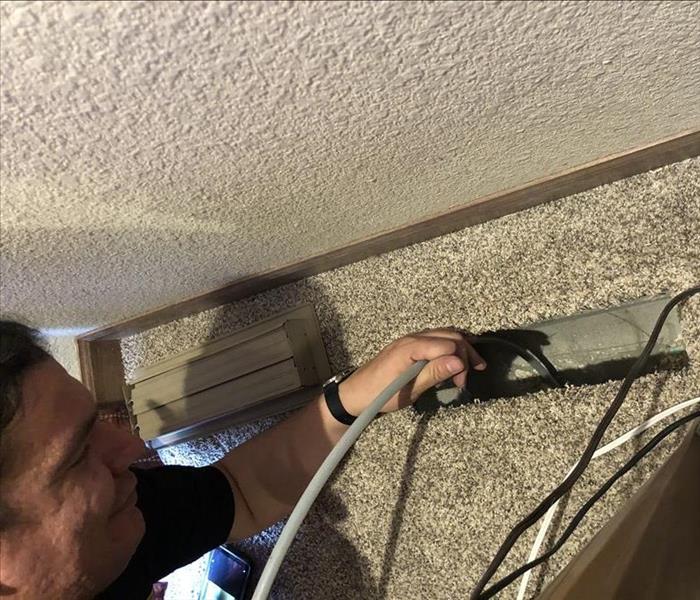 One of our technicians cleaning ducts.
One of our technicians cleaning ducts.
When it comes to cleaning the home, duct cleaning is the most frequently-forgotten service. It’s not something you really look at everyday, such as windows, floors, and counters. But getting your ducts cleaned is just as important as getting your carpets cleaned, because it has a direct effect on the cleanliness of the air in your home.
There can be health benefits from getting your HVAC cleaned. Your HVAC systems have been shown to collect a variety of contaminants such as fungi, bacteria, dust, pet hair and dander. All these can be irritants, especially if you have allergies. Removing the contaminants will help the indoor air quality overall.
Doing a visual inspection of your ductwork is very simple. Remove a register, slide your smartphone into the duct (with the flash enabled), and take a picture. You may be surprised at how much loose debris is lurking in your ducts!
How often should you have your ducts cleaned? It depends on several factors, such as:
- If anybody smokes in the house
- If pets live in the house (especially those that shed high amounts of hair and dander
- If water damage has occurred in the ductwork
- Residents with allergies or asthma
- Recent home renovations or remodeling
- Moving into a home that had prior occupants
When picking an HVAC contractor, several factors should be considered. See if the company has been in business long enough to have adequate experience. Get proof that the company is properly licensed (if applicable in your state) and adequately insured. Make sure that the company is going to clean and visually inspect all of the air ducts and related system components. Avoid advertisements for “$99 whole house specials” and other sales gimmicks. Ask if the company has the right equipment to effectively perform cleaning, and if the company has done work in homes similar to yours.
If you are interested in a FREE duct cleaning estimate, call SERVPRO of Casper at 307-235-6558.
Fire Drills
1/6/2022 (Permalink)
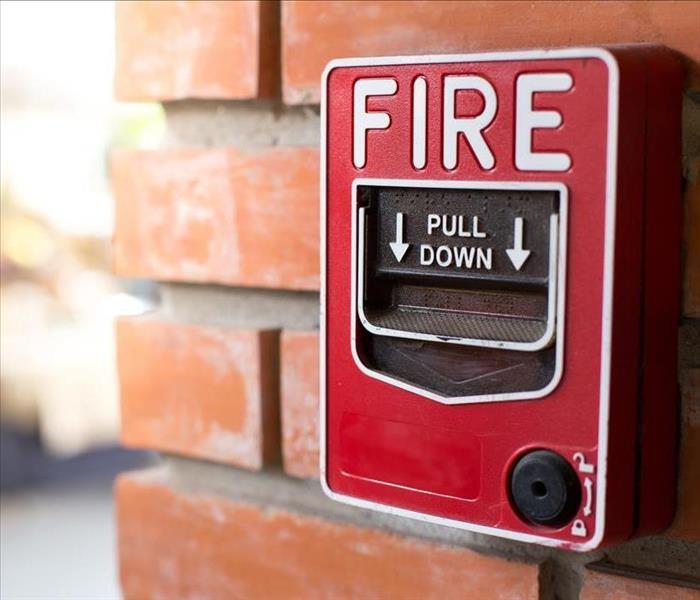 A Fire Alarm Pull
A Fire Alarm Pull
When running a business, your top priority should be the safety of your employees and patrons. Having a safety plan in place will help your employees know what to do in case of an emergency event. Doing drills such as a fire drills will help your employees know what to do and where to go if a fire should happen. Doing regular fire drills with different scenarios is important, because of the many variables that could occur. So it is best to be prepared as much as you can. When putting together an emergency plan, remember the Seven P’s (Proper prior planning and preparation prevents poor performance). There should be one person per shift that is in charge during an emergency.
For a commercial building, there should be some key points in a fire plan: You will want to establish roles and responsibilities for a fire evacuation team. Make sure there is a communication plan, such as mapping out routes. Make sure you know the locations of all fire alarms, smoke detectors, and fire extinguishers. It is best to run your employees through a fire drill at least twice a year.
When setting up standards for you fire drill, it becomes easier after the first one. You will have a better idea what needs to be done, routes, and acceptable times.
You should have goals, such as how much time does it take to shutdown critical equipment, how long does it take for everyone to get out of the building, and do a check-in. Once the first one is done, have a sit down with the leaders and have them give you a report. Then re-adjust either your goals, routes, or routines on getting out.
Once you have things established, rehearsing fire drills regularly is important. Changing the routine is important too. People can start getting complacent, so when the time comes, everyone will be on top of their game.
Appoint independent observers during drills. You want people that are not on your team to keep an eye out during a fire drill. Things they should be looking out for: large groups moving slowly and talking to each other, people using cellphones, people grabbing coats, purses, or bags, doors that are hard to open or slippery floors that could cause problems with people that have a disability, or anyone that chooses to use a different exit rather than the one close to them.
After a fire drill is done, there should be an AAR(After Action Review). Things that should be reported include: did employees close the door after exiting the room? Was everyone calm and confident? Did everyone go where they are suppose to go? Did all the alarms work properly?
Christmas Tree Safety
12/14/2021 (Permalink)
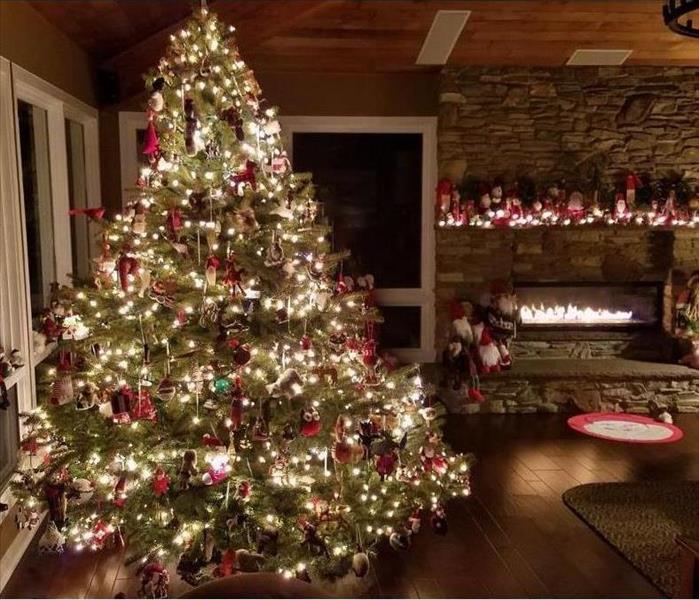 A decorated Christmas tree in a decorated living room.
A decorated Christmas tree in a decorated living room.
One of the best parts of Christmas is the Christmas tree. But there are responsibilities involved with having a Christmas tree, whether it is a natural or artificial tree. If you are purchasing a real tree, don’t just grab the first tree on the lot. Carefully inspect the tree before buying. You want to make sure the tree is fresh with green needles, and that the needles do not fall off when touched.
When placing your Christmas tree in your home, cut at least 2 inches from the base of the trunk. Once the tree is secured in its stand, add enough water to keep at least the bottom inch of the trunk submerged. You will want to add water daily, because the tree will soak up a lot of water. Make sure that your tree is at least three feet away from any heat source, like fireplaces, radiators, candles, heating vents, or lights. You want to make sure that your Christmas tree is not blocking any exits. If an emergency should happen, you don’t want to have to fight your tree.
When it comes to lighting the tree, use lights that are listed by a qualified testing laboratory. Be sure to pay attention to the details on the box, as some lights are rated for indoor or outdoor use only. Replace any strings of lights that are worn, broken, or have loose bulb connections. Read the manufacturer’s instructions for how many lights you can string together, and do not overload the lights or outlets.
Be cautious of toddlers and pets. They can pull the ornaments and lights down, and possibly put them in their mouth. The ornaments are a choking hazard, and the lights can be an electrocution hazard. You may have to set up a barrier for their safety.
After Christmas, it is good to get rid of the tree before it starts to dry out. A dried-out tree is a fire hazard. They should not be tossed in your garage, or near the side of your home.
Some facts from the NFPA (National Fire Protection Association):
- Almost one third of home Christmas tree fires are caused by electrical problems.
- Although Christmas tree fires are not common, when they do occur, they are more likely to be serious.
- A heat source too close to the tree causes more than one in every five of the fires.
What To Do Incase Of Hypothermia
10/19/2021 (Permalink)
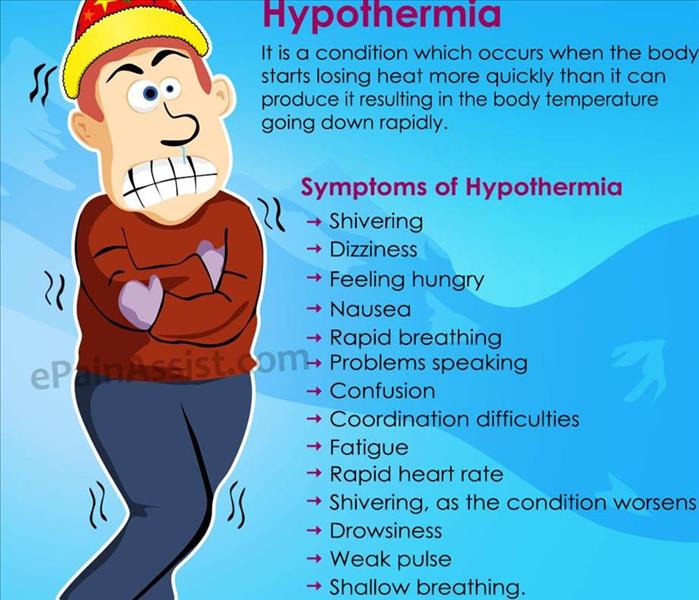 Signs of Hypothermia
Signs of Hypothermia
In the winter months, hypothermia can be a very serious health hazard. It is important to know the basics of hypothermia, how to prevent it, and what to do if you or someone you know develops it.
Hypothermia – Is caused by prolonged exposures to very cold temperatures. Lengthy exposures will eventually use up your body’s stored energy. Exposed to cold temperatures, your body begins to lose heat faster than its produced.
Body temperature that is too low can affect the brain, making it hard to think clearly or move well. This is why hypothermia is so dangerous. The person may not know what is happening to them, and won’t be able to do anything to help themselves.
Who is most at risk?
- Older adults with inadequate food, clothing, or heating
- Babies that sleep in cold rooms
- People who remain outdoors for an extended amount of time such as homeless, hikers, hunters, etc.
- People that drink alcohol, or use illicit drugs
Signs and Symptoms -
Adults:
- Shivering - Exhaustion or feeling very tired - Confusion
- Fumbling hands - Memory loss - Slurred speech
Babies:
- Bright red, cold skin
- Very low energy
When someone shows signs of possible hypothermia, take their temperature. If it is below 95 degrees, it is critical that you take immediate action.
If getting medical help is not possible right away, try warming the person up.
- Get to a warm room or shelter
- Remove wet clothing
- Warm the center of the body (chest, neck, head, and groin)
- Use electric blankets if possible, or skin-to-skin contact under loose blanket, clothes, etc.
- Drink warm liquids, not alcohol. It will help warm the person up, Do not attempt to give an unconscious person liquids
- Most importantly: when possible, get medical attention
A person with severe hypothermia could be unconscious. If that is the case, move the person gently and get them to medical assistance right away.
If the person is not breathing, or does not have a pulse, start CPR immediately. Continue with CPR until medical personnel arrives. Continue warming them up while giving CPR. In some severe cases, the person may still be resuscitated successfully.
Hearing Protection
10/19/2021 (Permalink)
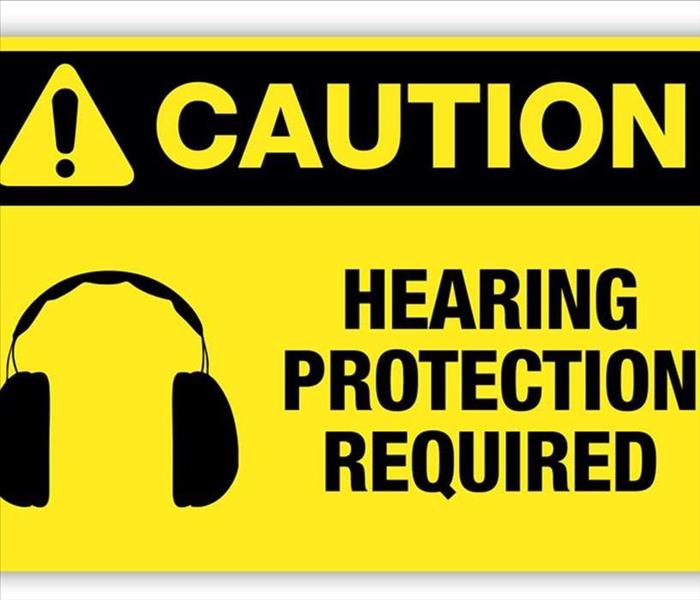 A caution sign about wearing hearing protection.
A caution sign about wearing hearing protection.
The 5 senses are important to a human. When you lose one of them, it can make things hard. Gradual loss of hearing is common for working people. It can create difficulties in both a person’s professional and personal life. It’s not impossible to still have a good quality of life if you lose one your hearing, but it does come without its challenges. While some factors in hearing loss may be out of your control, there are many mitigating measures that can be taken to preserve your hearing.
Some indicators that you may be suffering hearing damage in the workplace:
- Hearing ringing or humming in your ears when you leave the workplace
- Having to shout to be heard by a coworker an arm’s length away due to ambient noise
- Experiencing temporary hearing loss when leaving work
How to protect your hearing:
- Identify noise-producing tasks
- Wear hearing protection
- Make hearing protection conveniently available in the workplace
- Reduce equipment noise
- Limit your exposure, if possible
- Have your hearing tested regularly by a qualified audiologist
- Do not allow children to enter noisy work areas
Types of hearing Protection:
Formable Earplugs
Premolded Earplugs
Canal Caps
Earmuffs
Do everything in your power to protect your hearing, because once its gone, its gone.
Frostbite Prevention and When to Take Action
10/15/2021 (Permalink)
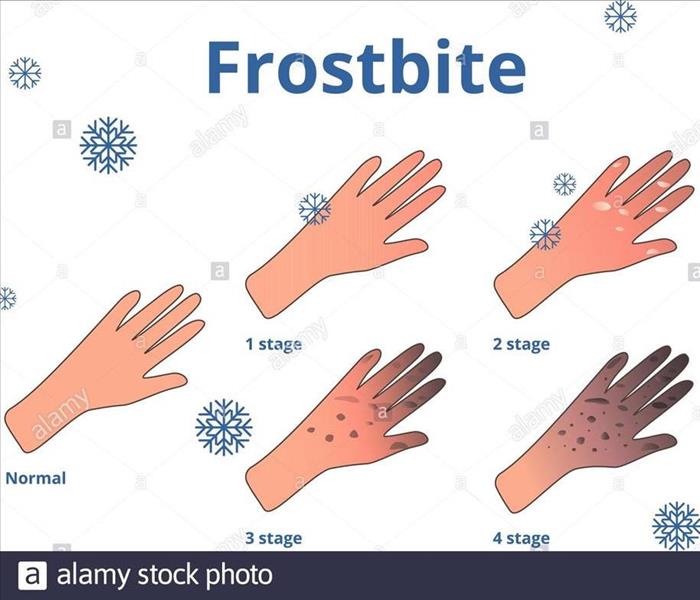 The different steps for frostbite.
The different steps for frostbite.
Frostbite:
Frostbite is caused by freezing. The affected areas will have loss of feeling and color. The most common extremities that get affected are the nose, ears, cheeks, chin, fingers, and toes. Frostbite can permanently damage the body, and in the most severe cases, lead to amputation.
Who is most at risk?
- Poor blood circulation
- Not properly dressed for extremely cold temperatures
Signs and symptoms of frostbite:
If there is redness or pain on any parts of the skin, get out of the cold and protect the exposed skin. Some of these other signs may point to frostbite:
- white or grayish-yellow skin area
- skin that feels unusually firm or waxy
- numbness
Someone may not know they have frostbite until it is pointed out. The frozen parts of their body are numb, and have no feeling.
When to take action:
If you see signs of frostbite on yourself or others, seek medical care. Make sure you also check for signs of hypothermia, as it can also be caused by exposure to cold temperatures. If anyone is showing signs, get emergency medical care.
- Get into a warm room as soon as possible.
- Do not walk on feet or toes that are frostbitten unless absolutely necessary. This could increase the damage.
- Don’t rub the frostbitten area or massage it, as this can cause more damage.
- Put the frostbitten areas in warm water, NOT hot water.
- If warm water is not available, use body heat. For example, if your fingers are frostbitten put them in your arm pit.
- Do not use a heating pad, heat lamp, stove, or fireplace. When areas are frostbitten, it is numb, and you can easily get burnt because you don’t realize how close you are.
Don't substitute these first aid steps for proper medical care. Frostbite injuries need to be examined by a qualified healthcare worker.
How to Help Prevent Frozen Pipes
10/13/2021 (Permalink)
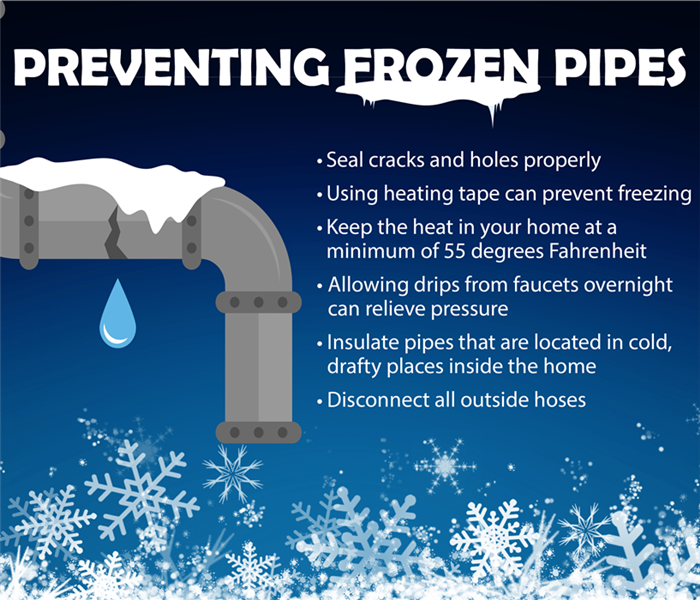 A water faucet that is dripping water, with an explanation on how to keep pipes from freezing.
A water faucet that is dripping water, with an explanation on how to keep pipes from freezing.
Living in Wyoming, it’s common knowledge that during the winter, freezing temperatures will happen. Depending on the duration and severity of a freeze event, frozen and broken pipes can be a common problem. But there are a few precautions that can help keep your pipes from freezing.
Leave faucets dripping-
Having a trickle of cold water flowing through your pipes will keep water moving. Moving water is more resistant to freezing.
Open Cabinet Doors-
When temperatures are freezing, opening the cabinet doors on sinks such as kitchen sinks, bathroom sinks, or laundry wash tubs will help reduce risk of freezing. This measure is especially important if the sinks are located along an exterior wall. Sometimes there could be a cool breeze finding its way in through the pipes, or a crack in the foundation. Opening the cabinet doors introduces heated air into the cabinet space, and warms the exposed plumbing.
Wrap Your Pipes-
Pipes that are at risk for freezing should be wrapped in heat tape, or pipe insulation. This will help add extra freeze resistance to your pipes.
Keep heat to 55F or higher-
If you plan on leaving your home for a day trip, vacation, or vacating your house for any reason, you should not leave your temperature any lower than 55 degrees F. This temperature provides a base level of warmth to prevent freezing in the home.
If your pipes freeze and break and it causes a water damage, SERVPRO of Casper is here for you 24/7. Call us anytime at 307-235-6558.
Vehicle Safety in the Winter and Winter Storms
10/13/2021 (Permalink)
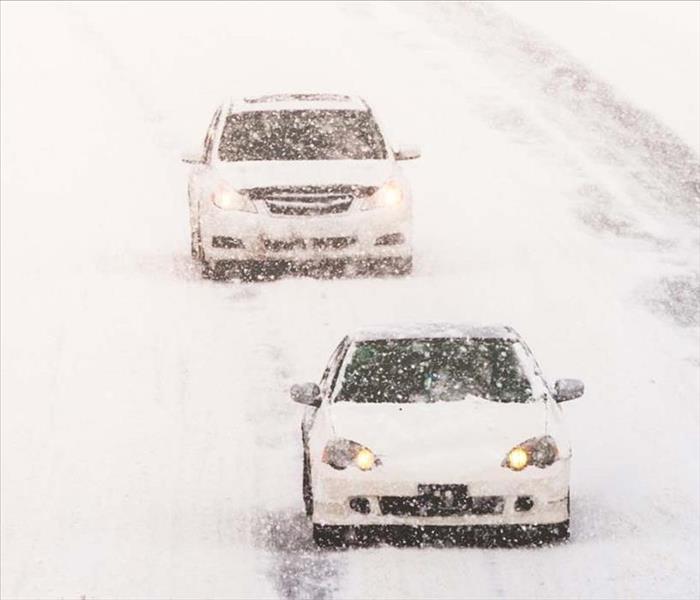 A vehicle on snowy roads.
A vehicle on snowy roads.
Before winter gets here, it is a good idea to start preparing your vehicle. You want to make sure your vehicle is in good working order before the snow starts flying. Here are a few things to check, and fix if needed:
1. It is best to start your inspection no later than November. You may want to start even sooner if you live in a colder environment. You don’t want to be stuck in the snow unprepared.
2. When the temperatures start dropping outside, so does the tire pressure on your vehicle. If the tire pressures drop too much, the performance of your vehicle goes down. When driving on ice and snow, proper air pressure will ensure maximum performance. To see the recommended tire pressure for your vehicle, check the data label inside your vehicle’s driver door, or refer to the owner’s manual.
3. Test your battery. Cold weather reduces the power your battery is capable of producing. At zero degrees F, your battery can only deliver half its normal amperage. If you do not have a battery tester, most auto parts stores will test your battery for you for free. It is also a good idea to keep a pair of jumper cables in your vehicle, in case you unexpectedly experience a weak or dead battery.
4. Check your windshield for cracks or chips. If you have any small chips, have them repaired by a local auto glass company. By having them filled in, this will keep the cracks or chips from spreading. You also want to make sure you have good windshield wiper blades.
5. Inspect your headlights and brake lights. If it is storming, you want to make sure your lights are in working order so you can see, and so people can see you.
6. In winter, it is very important to have an emergency kit in your vehicle. You will want blankets, warm clothes, winter shoes, flashlight, batteries, water, etc.
7. When traveling in winter conditions, always let someone know where you are going, and when you expect to arrive. Then check in when you get to your destination.
By following these tips, you can have a safer winter on the roads.
Chimney Inspection
10/8/2021 (Permalink)
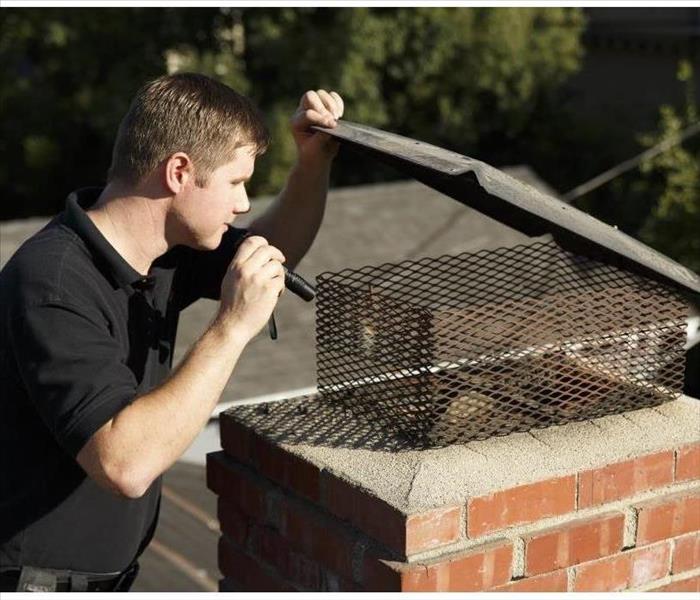 An inspector doing a chimney inspection.
An inspector doing a chimney inspection.
Nothing is more comforting on a cold day than lighting your fireplace. A fireplace has a wonderful ambience that cannot be matched by a furnace. The beautiful colors of the flames, the smell, and the feeling of the heat is enjoyable. But there is a lot of responsibility when it comes to owning a fireplace. You need to have periodic inspections, cleaning, and more. Here are some things you should do before winter.
Hire a Chimney Sweep:
The NFPA (National Fire Protection Association) recommends that all chimneys get swept at least once a year. Its best to find a certified sweep in your area to make sure it its done properly.
Check for Damage:
When you have your chimney swept, you should also request an inspection. They should look for cracks, loose bricks, or missing mortar. The chimney liners should be checked also for cracking or deterioration.
Cap the Chimney:
During the inspection looking at the chimney cap is important too. The cap helps keep out the rain, birds, squirrels, and debris from entering. If there is damage, or it is missing, make sure it is fixed or replaced.
Burn Seasoned Hardwood:
“Green” wood and certain soft woods like pine produce more creosote, a flammable byproduct of combustion that build up in the chimney. Excessive creosote buildup can cause a chimney fire. You want to burn dense hardwoods, like oak, if they are available. Before using any wood for fire, split it and store it in a high and dry place for at least six months.
Don’t Overload:
Keep your fire small. Small fire creates less smoke, and creosote that can build on the walls of your fire place. Also, if your fire gets toolarge, it can get too hot and crack the walls of your chimney.
Build it Right:
When starting a fire, start with kindling instead of flammable liquids. Place the logs towards the back, and on a metal grate.
Use a Spark Guard:
It is best if a fireplace has a glass or mesh door. This will help any shooting embers from coming out and landing on your floor. Adding a fire screen outside the fireplace creates an additional layer of protection against sparks and popping embers.
If you experience a mishap with your chimney or fireplace, prompt cleanup of the resulting smoke damage is important. Call SERVPRO of Casper for a free assessment.
Ways to Prevent Sewer Backup
10/7/2021 (Permalink)
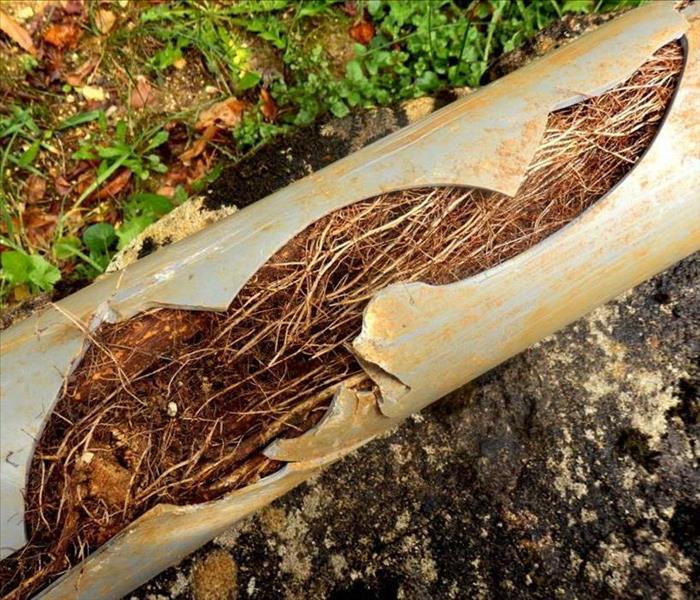 A pipe that is broken with tree roots.
A pipe that is broken with tree roots.
There are several different kinds of water intrusions that can happen in your home. When it comes to damage caused by a sewage backup, it can be more complicated than a basic pipe leak. In some cases, there can be actual human waste on your floor. Affected materials need to be removed, which can be more costly. Here are a few ways that a sewer backup can cause flooding in your basement.
Blockage -
Blockage is the leading cause of sewer line backups. Items such as feminine products, paper products that are non-flushable, and grease are common culprits. Grease may be a liquid when it’s poured down the drain, but it can still solidify and expand when cooled. This can cause blockage in your pipes.
Collapsed Piping -
A collapsed pipe is not as common, but it is still possible. If you have clay piping, with time they can start to decay and fall apart. Tree roots can repeatedly puncture the piping, compromising the integrity of the pipe and causing a collapse. Collapsed sewer lines can be corrected by replacement, but it is both expensive and intrusive.
Roots -
Tree roots can be a nightmare for a homeowner. If you live in an area were there are old trees, or a lot of trees, it is best to get your sewer line cleaned out once a year. Tree roots can puncture the walls of your pipes, or they can fill the pipe up to where there is no room for the waste to go, which can cause a back up.
If a sewage backup occurs in your basement, Call SERVPRO of Casper anytime for immediate assistance at 307-235-6558.
A Fire Free Halloween
9/30/2021 (Permalink)
 Halloween decorations, there is carved pumpkins, skulls, and other Halloween decorations.
Halloween decorations, there is carved pumpkins, skulls, and other Halloween decorations.
Halloween is right around the corner! People will be busy with parties, trick-or-treaters, and costumes. But one the most popular traditional activities during this time is carving pumpkins. You get to carve out funny or scary faces then add a candle in them so they light up at night.
If not done properly, there can be accidents, such as fires. There are a lot of Halloween-related items and materials that could catch on fire. Children’s costumes, decorations with loose fabric, or the dried cornstalks that are a popular fall accent, can all be very combustible. With the help of the National Fire Protection Association, I’m going to give you some tips on how to prevent a fire at Halloween.
- Use battery-operated candle or glow stick in the jack-o-lantern
- When choosing costumes, avoid long trailing fabric
- Teach your children to stay away from flames, such as a jack-o-lantern with a candle
- Keep dried decorations such as flowers, cornstalks, or crepe paper away from an open flame, or even light bulbs that can heat up, such as incandescent lighting
- Keep all exits clear of decorations so the escape routes are available if necessary, and make sure all smoke alarms are working
- Provide children with flashlights or glow sticks as part of their costume
By following some of these simple tips, you can have a happy and safe Halloween!!
Fatigue in the work place
9/22/2021 (Permalink)
 A lady slumped over her desk feeling fatigued. She has her laptop, with cups of coffee.
A lady slumped over her desk feeling fatigued. She has her laptop, with cups of coffee.
Work place fatigue can be a serious problem. Taking the right steps to make sure you’re taking care of yourself is very important. The Centers for Disease Control says that under regular circumstances, adults need 7-9 hours of sleep per night, along with opportunities to rest while awake.
Long hours, shift work, stressful or physically-demanding work can lead to poor sleep and extreme fatigue. Everyone is different on what their individual needs for sleep and rest, but here are some ideas to help manage fatigue.
Improving your sleep:
- You’ll sleep better if your room is comfortable, dark, cool, and quiet.
- It shouldn't take longer than 15 minutes to fall asleep. If it does, take some time before bed to try meditation, relaxation breathing, or muscle relaxation.
- When you know you’re going to work a long stretch of shifts, try “banking” some extra sleep.
- After you work your extended shifts, plan on getting extra sleep afterward so you can start to recover.
- Avoid sunlight or bright light at least 90 minutes before going to sleep. The light exposure before bedtime can cause you to feel more awake.
- If you work a graveyard shift and you’re going home in the daylight, wear sunglasses. This will help cut down your light exposure.
- In your bedroom, get some black-out curtains or blinds.
- Take naps when you have the opportunity.
- Before working a night shift, try taking a 90-minute nap. This will help keep you from feeling tired at work.
- Eating healthy foods and staying physically active will help improve your sleep.
- Avoid foods or drinks before bed that could make falling a sleep more difficult.
- Avoid alcohol, heavy meals, nicotine for at least 2-3 hours before bedtime.
- Avoid caffeine at least 5 hours before bedtime.
Feel Tired in the Workplace?
8/3/2021 (Permalink)
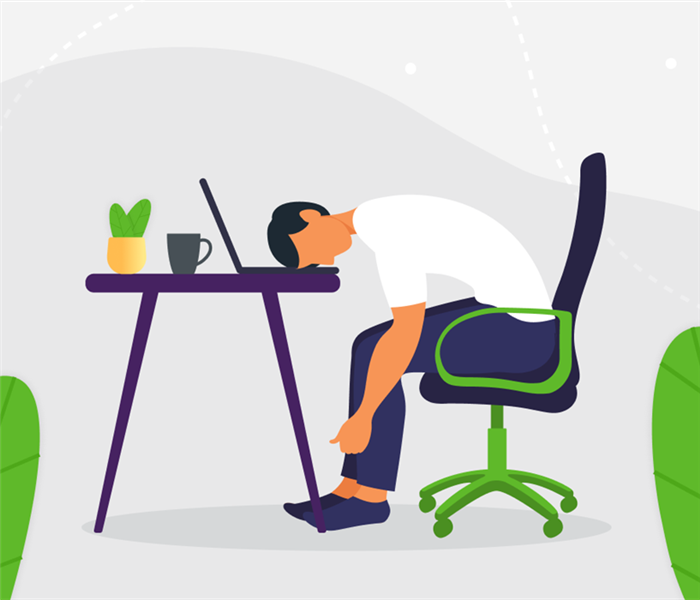 A worker sitting in his office at desk feeling tired with his head on his laptop.
A worker sitting in his office at desk feeling tired with his head on his laptop.
Depending on your work shifts, how many continuous days you’ve worked, or the stress of your job, its easy to get too tired to work safely. There are many things someone can do to help stay awake.
- Use the buddy system: check in with each other, see how they are handling the work hours and the demands. Watch your coworkers for signs of fatigue, such as yawning, having a hard time keeping their eyes open, or difficulty concentrating. Also be mindful of yourself, and be aware if you’re showing any of these signs as well. If you see any of your coworkers having any of these problems, say something. They may not even realize they are doing it. By speaking up, this can help prevent workplace injuries and errors.
- Find out if your employer has a program to help manage fatigue on the job. Ask questions to see if there are policies and procedures for helping employees manage fatigue.
- If there were any near misses, or events that were caused by fatigue, tell a manager right away. This will help help prevent injuries or errors.
- Don’t work if your fatigue threats the safety of yourself or others. Talk to your manager right away if you feel you can not work safely.
4th of July BBQs
7/2/2021 (Permalink)
 A table full of bbq food, hot dogs, and burgers.
A table full of bbq food, hot dogs, and burgers.
The Fourth of July brings Barbecues, parades, concerts, and fireworks. Everyone loves fireworks. Who doesn’t love the sounds, lights, and colors? But there are some safety concerns that you need to be aware of when handling or being around fireworks. The Consumer Product Safety Commission states that in 2018, there were 9,100 reported firework injuries and 5 deaths.
If fireworks are legal where you live and you choose to use them, here are a few safety tips:
Never allow young children to handle fireworks
Older children should use them only under adult supervision
Never use fireworks if impaired by drugs or alcohol
Anyone using fireworks or standing nearby should wear protective eyewear
Never hold lighted fireworks in your hands
Never light fireworks indoors
When using fireworks point them away from people, houses, and flammable material
Never point or throw fireworks at another person
Only light one device at a time and maintain a safe distance after lighting
Never ignite devices in a container
Do not try to re-light or handle malfunctioning fireworks
Soak both spent and unused fireworks in water for a few hours before discarding
Keep a bucket of water nearby to fully extinguish fireworks that don’t go off or in case of fire
Never use illegal fireworks
Another 4th of July favorite is the sparkler. There is a misconception that they can’t hurt you because they don’t shoot off in the sky, but they can. The National Fire Protection Association states that sparkler injuries make up 25% of fireworks-related emergency room visits. Sparklers burn at 2,000 degrees Fahrenheit. That is hot enough to melt metal. If dropped on clothing, it can catch them on fire. It can also cause severe burns to the feet if wearing sandals, or if you are barefoot. Glow sticks, confetti poppers, and colored streamers are safer alternatives to sparklers.
We at SERVPRO of Casper hope you and your family have a fun and safe Fourth of July!
Saving Money
6/1/2021 (Permalink)
 A coin jar with a tree coming out of the top.
A coin jar with a tree coming out of the top.
When you own or operate a small business, you typically don’t have unlimited financial resources to stay afloat. It is critical to manage your expenses so you can control cash outflow from your company. If your business is in a commercial building, your utility bills can make up a large amount of your monthly expenses. Managing and reducing energy consumption is a sure way to lower your bills, and keep more money in your business.
- Insulation Saves Energy
One fairly inexpensive way to reduce energy costs is insulating your property. You can save up to 10% of your energy bill by installing proper insulation and sealing your building. Sealing drafty windows is a great start, as well as adding insulation to exterior walls. Additionally, sealing around plumbing penetrations and correcting leaks in HVAC ducts is helpful.
- Turn Off Lights and Computers
At the end of the business day, have your employees power down their computers, and turn off all lights. Modern laptop computers and LED lighting consume far less electricity than their older counterparts. However, they still use a small amount of energy. Fully shutting off computers and lights can still result in savings in the long run.
- Utilize Smart Building Technology
Modern building controls, including programmable thermostats, are a great way to limit energy consumption. Smart thermostats can help you build a heating and cooling schedule that keeps your employees comfortable during business hours, while cutting back on usage during times that nobody is present. Motion-sensing light switches turn lights on when people are in a room, and automatically turn them off when no motion is detected. This minimizes electrical consumption, and cuts down your electric bill.
- Maintain your HVAC system
Dirty HVAC systems consume more energy to operate than a clean, well-maintained system. Clogged filters, dirty refrigeration coils, and dust buildup in the supply and return ducts all add resistance to airflow. The blowers have to work harder to push air, and consume more power as a result. Changing filters regularly, and scheduling periodic duct cleaning, can save you money in the form of reduced utility bills.
SERVPRO of Casper can address your HVAC cleaning needs. We have the tools and training to keep your HVAC system running cleanly and efficiently, so you can keep a handle on energy consumption expenses in your business.
3 reasons your fridge may leak
4/21/2021 (Permalink)
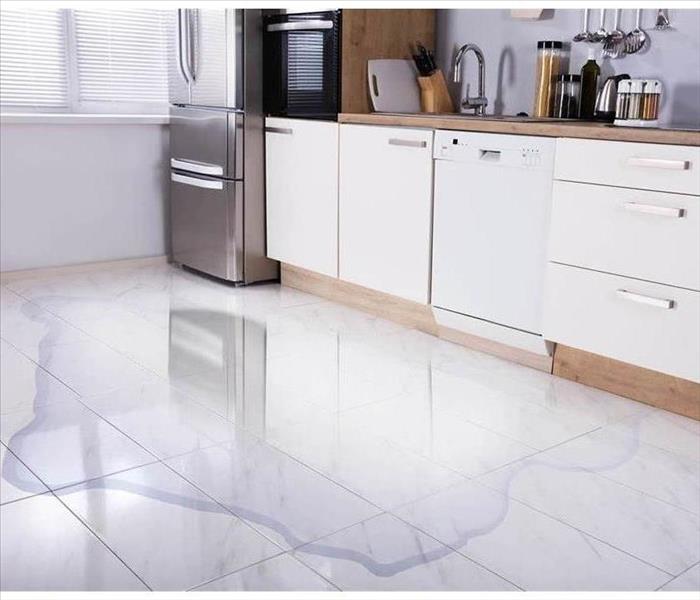 A kitchen that has standing water on the floor.
A kitchen that has standing water on the floor.
Your kitchen has a lot of appliances and fixtures that can develop water leaks. The sink, refrigerator, dishwasher, and water cooler are all potential sources of water damage. One of the most concerning appliances in this respect is the refrigerator. Refrigerator and ice maker troubles tend to start as very small leaks. Most leakage occurs in the back, normally out-of-view. A leak can continue for a long time before it is noticeable, and has caused substantial damage. The three most common sources of leakage from a refrigerator are improper leveling, drain blockage, or the water supply line for the ice maker.
- Refrigerator Leveling Problems -
If you get a new refrigerator, or installing new flooring, you should always double-check the level of the refrigerator when you put it back. The front of the refrigerator should be between a quarter-inch and half-inch higher than the back. This helps front-to-back tilt and enables coolant to flow freely. If coolant cannot circulate properly, it may pool in the pipes and force the fridge to work harder. This can create extra condensation around the coils, resulting in water dripping on the floor.
- Inspecting for Defrost Drain Blockage -
The defrost drain (located on the back of a freezer or refrigerator), should be checked to make sure it is not blocked by ice or debris. Flush out the drain hole with 1 teaspoon of baking soda mixed into hot (but not boiling) water. As a preventative measure, you can perform this flush once or twice a year.
- Checking the Water Supply Line -
Flow problems on your water dispenser, or erratic ice production, could be signs of a leaking supply line. Pull the refrigerator away from the wall and inspecting the line and its connections. Be careful not to pull the refrigerator too far away, as it could put strain on the fittings, and cause damage.
If you notice floor swelling or warping around your refrigerator, or paint bubbling on the surrounding walls, you should perform the above inspections to find what is causing the damage. Once you have the source of the water stopped, contact SERVPRO of Casper to evaluate and repair the damaged area.
Commercial Duct Cleaning
4/8/2021 (Permalink)
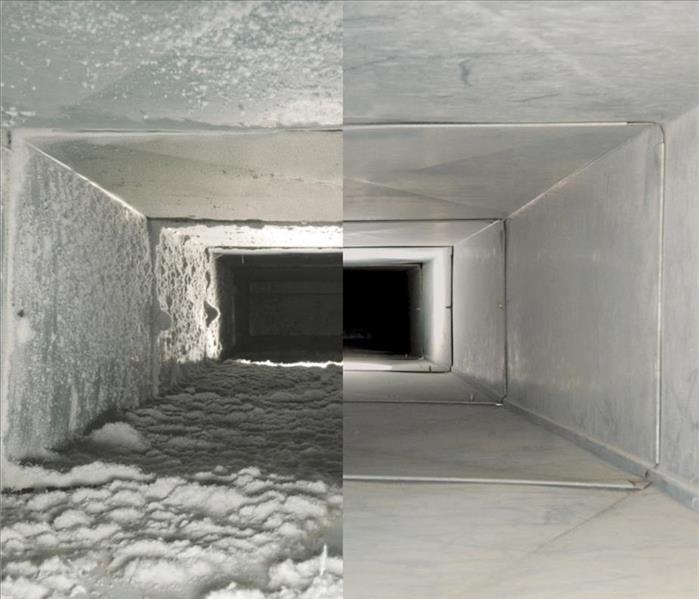 Before and after on duct cleaning
Before and after on duct cleaning
The heating, ventilation, and air conditioning (HVAC) system in a commercial building serves an important function. The HVAC system brings in heating and cooling throughout your facility. As any employer knows, it’s important to keep your employees comfortable and happy. Regular cleaning of your HVAC ducts is an important maintenance measure in your building. Here’s why:
Air Duct Cleaning Improves the Quality of Indoor Air
Having your air ducts cleaned it decreases the number of airborne particles in your building. As air passes through the HVAC system, contaminants such as dust and pollen accumulate in the ducts. An excessive amount of these substances can cause allergies or “hay fever” symptoms in some people. Frequent changing of filters helps control this problem, but some particles get past the filters. Duct cleaning reduces the amount of these fine particulates in the system, leaving you with healthier air. We use specialized tools (such as air whips and rotary brushes) to agitate the dust from the duct walls, and a HEPA-filtered vacuum unit to collect it from your system.
Air Duct Cleaning Conserves Energy
A clean HVAC system simply works more efficiently than a dirty one. If properly and thoroughly cleaned, it can reduce the costs of running your HVAC system. It can also increase the useful life of your air conditioner and furnace. Performing routine commercial air duct cleaning can help improve airflow, and help your system to work more effectively, and use less energy.
SERVPRO of Casper specializes in cleaning commercial and industrial air ducts. Call our office today to set up your free estimate at 307-235-6558.
Hail Storm
4/5/2021 (Permalink)
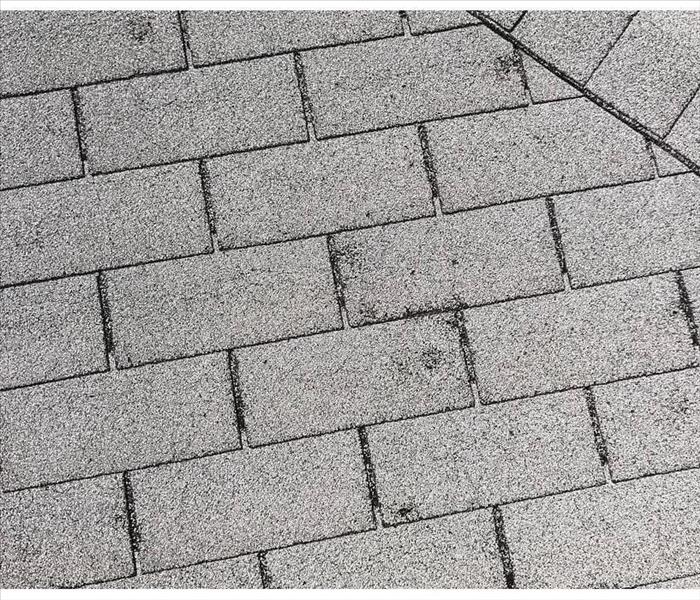 A roof that has a lot of hail damage
A roof that has a lot of hail damage
Even the smallest hailstorm can cause significant damage. The impact from hail can cause denting, cracking, and breaking of a multitude of surfaces. If a home is older or poorly-maintained, the damage from a hailstorm may be more severe. Hail can cause damage to both the interior of your home and the exterior of your home, as well as any exterior attachments.
Exterior Damage – The roof takes the majority of the hit, and depending on the material of the roof it could crack, split, peel, chip, or dent. In some cases windows could break, and if there is a skylight there is a higher risk of them breaking too. Aluminum and wood siding may be dented by side-swept hail. Vinyl siding has an increased risk of breaking under heavy hail impact.
Interior Damage – Depending on the condition of the structure, hail could melt and cause damage to the interior. If you start to see dripping or dark spots in the ceiling drywall, you should look up in the attic to check the insulation to make sure it’s not wet and causing more damage. Then you should look around in your attic and find the location where the water is coming in, so you can tell a roofing contractor. If the hail breaks any windows or skylights, rain and hail can get inside and cause significant damage.
Exterior Attachments – Hail can damage air conditioning units, satellite dishes, antennas, and other attachments on the outside of a home.
If your home sustains interior water damage from a hailstorm, rapid response and drying is important. Give the professionals at SERVPRO of Casper a call anytime, day or night.
Water Damage in Crawlspaces
4/2/2021 (Permalink)
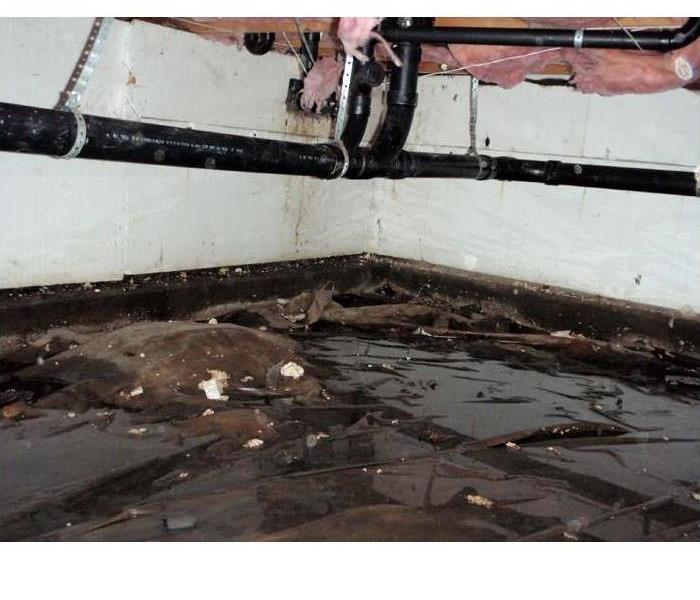 Flooded Crawlspace
Flooded Crawlspace
Water Damage in Crawlspaces
When water is able to enter the crawlspace under a home, it can cause substantial damage. Here are some of the common ways that water intrudes a crawlspace, as well as measures to prevent it from happening.
You want the ground to slope away from your home, creating positive drainage. If water pools up around the foundation it can over saturate the ground, and there’s a risk of it seeping through the foundation and going into your home.
If you live near a stream or river, you are at risk of flooding. Storms or large amounts of run-off can cause streams to come out of their banks, and reach nearby structures. It doesn’t necessarily mean you will encounter flooding inside the living space of your home. But the water can seep through the foundation and go into your crawl space.
The groundwater table varies greatly in Casper, from neighborhood to neighborhood. If you live in a low-lying area with a high water table, your crawl space could have continuous water intrusion problems. Sump pumps and drain tiles may help relieve the problem.
It is common for household plumbing to run through crawlspace areas, as it allows easy access to all rooms in the home. At any time, pipes can develop cracks or pin-hole leaks. Because these types of leaks are slow, and homeowners rarely go into their crawlspace, large amounts of water can accumulate over time. The increased humidity in the crawlspace may cause condensation on wood framing, which could encourage mold growth. The best way to avoid these problems is to inspect crawlspaces on a monthly basis.
Downspouts and gutters are designed to collect water from the roof and direct it away from the house. If a gutter becomes blocked, or a downspout is disconnected, the water may build up along the edges of the house. This water eventually enters the crawspace through foundational seepage. Keeping gutters free of debris, and repairing damage when it is discovered, will help keep the water away from your home.
If you should get water in your crawlspace, SERVPRO of Casper can help. Call us for a free inspection, or emergency service.
Winter driving 1 of 2
3/2/2021 (Permalink)
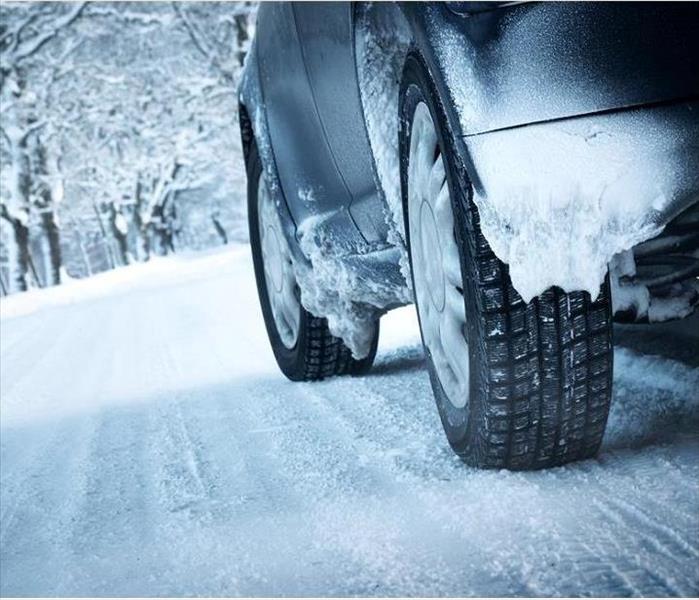 A vehicle driving on snow/icy roads.
A vehicle driving on snow/icy roads.
Winter weather can be unpredictable in Wyoming. When winter storms occur, the condition of local roads and highways can get very bad. While most drivers believe that they are skilled in driving on winter roads, many are not familiar with the fundamentals of driving in slick conditions. Here are some tips on how to drive safely when the roads are slick.
Driving in the snow:
- Stay home, if possible: Simply avoid getting on the road in bad weather, unless it is absolutely necessary.
- Drive slowly: Reduce your speed during slick conditions. It will help maintain traction on snow or ice.
- Accelerate and decelerate slowly: Push down on the throttle and brake pedals slowly to maintain traction, and avoid skids or spin-outs. Allow yourself more time and distance to slow down or stop on slick roads.
- Control your brakes: Even if you have an anti-lock brakes, you should keep your heel planted on the floorboard, and the ball of your foot on the pedal.
- Don’t stop if you can avoid it: If you can go slow up to a red light instead of completely stopping, it is safer. It requires more power to start moving from a full stop versus a slow crawl, and increases your likelihood of breaking traction.
- Don’t “power” up slick hills: If you apply too much throttle on a slick hill, your wheels may start to spin out. Build the inertia on dry land before going up a hill.
Winter driving 2 of 2
3/2/2021 (Permalink)
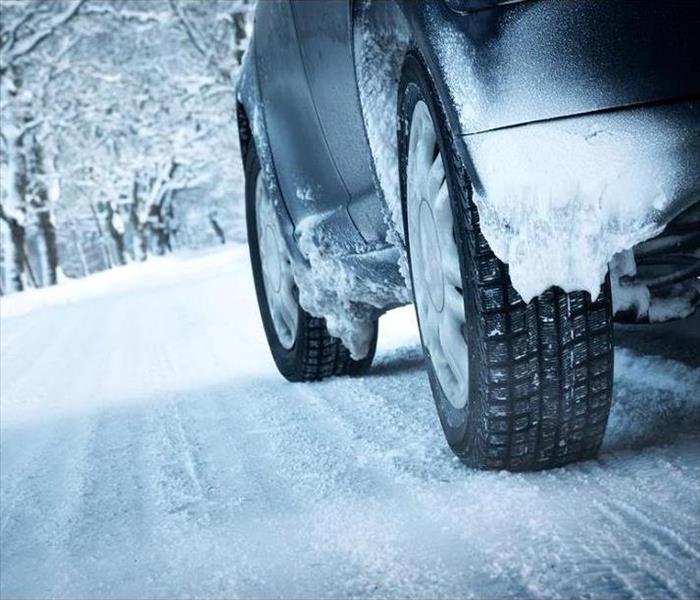 A vehicle driving on snow/icy roads.
A vehicle driving on snow/icy roads.
As you read in the last blog, winters can be unpredictable in Wyoming, and not everyone knows how to drive on bad roads. Here are some tips on how to drive long distances on slick roads, or in unpredictable winter conditions.
- Be Prepared: Make sure your vehicle is in good working order before leaving on long trips.
- Check the Weather: Check the weather reports along your route often for changes.
- Stay Connected: Before leaving on a trip, or when you get to your destination, let someone know.
- Stay with your vehicle: If you get stuck in the snow, don’t leave your vehicle. Your vehicle is a temporary shelter, and it makes it easier to find you.
- Don’t exert yourself: When digging out your vehicle, listen to your body. If you need to rest, do it.
- Be visible: Make sure you have something in your car that is bright and colorful. If your vehicle breaks down, you can tie something bright (such as engineer tape) on the antenna or roll a piece of cloth in the window. If it is night time, turn on your dome light to light up your vehicle so emergency responders can find you.
- Clear the exhaust pipe: Make sure the pipe is not clogged with snow, ice, or mud. If it gets plugged or blocked, there is a risk of carbon monoxide poising.
- Stay warm: Use whatever is available to insulate your body. It is a good idea to pack an extra coat and a couple of blankets during colder months.
- Conserve Fuel: Only run the engine and heater long enough to remove the chill. This will help conserve your fuel, and reduce the risk of carbon monoxide poisoning.
Hardwood Flooring drying
2/11/2021 (Permalink)
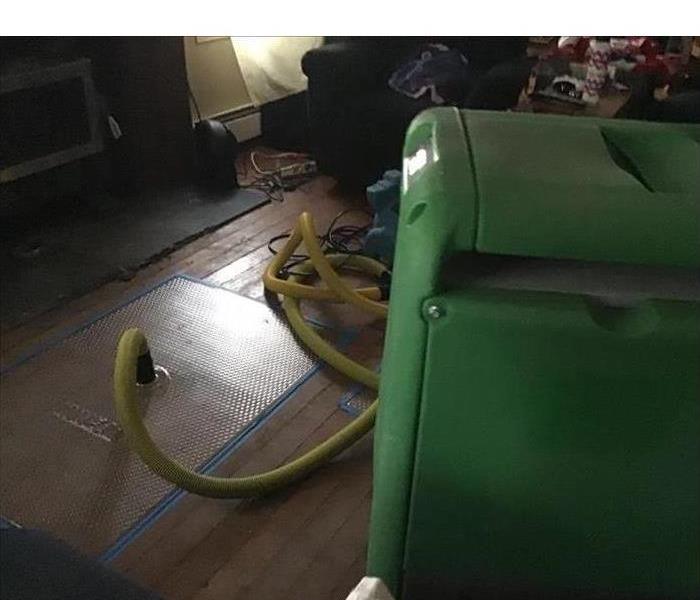 A wet hardwood with rescue mats to help dry the floor.
A wet hardwood with rescue mats to help dry the floor.
When a water damage affects your home, multiple types of flooring material can be affected. Some types of materials, such as glue-down carpeting, can be relatively simple to dry. Others can be more difficult to fully dry, and may require specialty equipment. Take hardwood flooring, for example. Water can seep into the grooves, and absorb into the plant cells of the hardwood floor, causing deep penetration and binding. SERVPRO of Casper has highly-trained technicians with the most up-to-date equipment to help get your hardwood floors dry.
Hardwood flooring is an expensive investment. When they get wet from a water damage, we follow a set of steps to ensure your hardwood flooring is dried effectively.
Step 1: Inspection
We look at the wood floors, paying close attention to signs of any buckling or warping. If there is severe buckling or warping, the floor may not be restorable. But under many circumstances, we are able to save them.
Step 2: Extraction
If there is standing water on the surface, we use our truck-mounted extraction system to remove the water. Then, we address the water that has soaked into the wood flooring. We use specialized wood floor “rescue” mats, connected to the truck-mounted extractor, to suck out the rest of the water. We continue this process until there is no more water coming out of the flooring.
Step 3: Drying
Once all the water is removed from the affected area, we set up the drying system. We use the same rescue mats and connect a specialty blower to them. The blower creates negative air pressure, drawing air through the boards, which removes additional moisture from the wood.
Step 4: Monitoring
Once the hardwood drying system is running, we return on a daily basis to monitor the progress of the floors. Hardwood floors must be monitored closely to prevent over-drying. Once the moisture content in the affected wood reaches equilibrium with the rest of the wood flooring in the home, we remove the drying system from your home. It is recommended that the flooring be allowed to rest without any further repairs for 45 days, to ensure that all of the wood returns to full equilibrium with the home environment. After that, any necessary sanding and refinishing may be done to complete the restoration process.
If you have questions about the process on drying your hardwood flooring, feel free to call us at 307-235-6558.
Commercial Delaminated Carpet
2/3/2021 (Permalink)
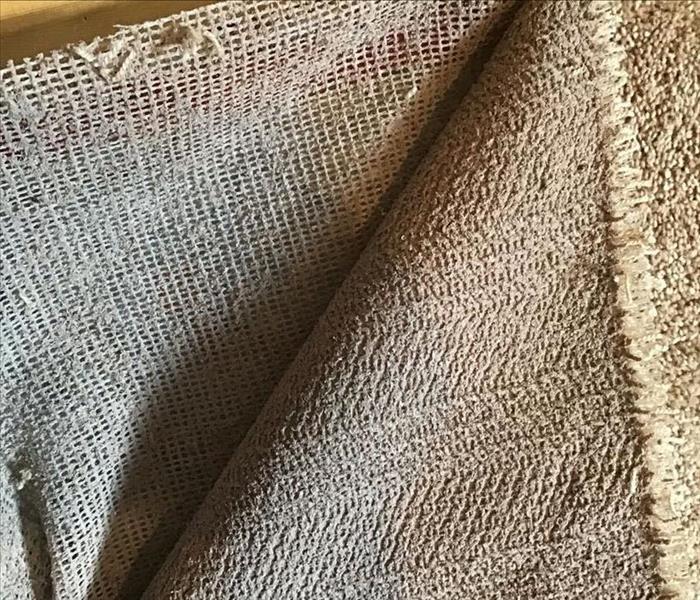 Delaminated Carpet
Delaminated Carpet
In many water-damaged homes, we are able to dry and restore the carpeting. But in some cases, water damage may cause delamination of the carpet.
Delamination in carpeting means that the adhesive holding the secondary backing on the carpeting has failed. The secondary backing separates from the carpet. The main purpose of the secondary backing is to give the carpet strength, and allow it to be stretched onto tackless strips. If delamination occurs, the carpet no longer has any structural strength, and cannot be stretched or secured.
Carpet delamination can be caused by several things. Heavy foot traffic, combined with years of wear, can cause the adhesive to crumble, resulting in delamination in the traffic lanes. Poor or defective manufacturing can cause premature delamination. A water damage does not necessarily cause the adhesive to fail. But if a carpet is subjected to multiple water damage incidents, or prolonged soaking in water, delamination is possible.
If we discover carpet delamination during water damage remediation, that carpeting is generally not restorable. It is more effective in that situation to remove and dispose of the carpet and pad, and focus on drying the remaining structural materials. If we remove the carpet, we save samples of it, in case your insurance company requests it. We also communicate with your insurance about why the carpeting needed to be removed.
When you have a water damage, you can count on SERVPRO professionals to evaluate the condition of your carpeting, and choose the best restoration path for your individual situation. For a free water damage evaluation, contact us anytime at 307-235-6558.
SERVPRO Service
2/3/2021 (Permalink)
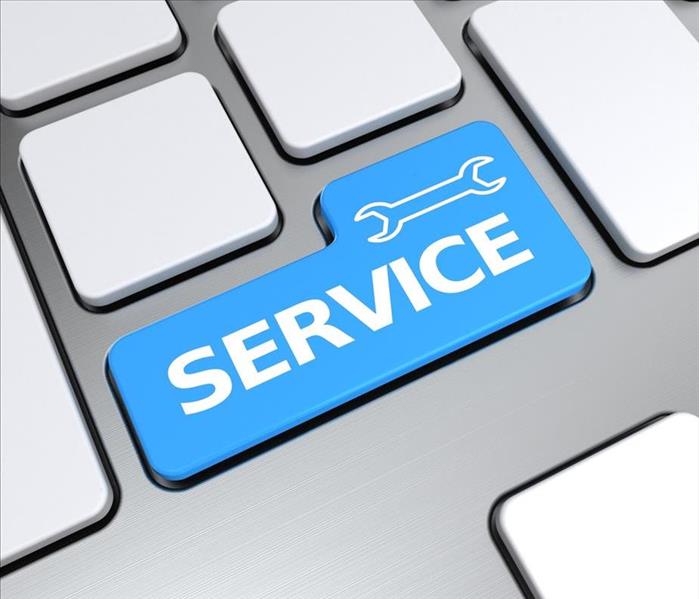 Services
Services
You may ask, why SERVPRO? Why are they the best choice for our cleaning and restoration needs? Here’s why: SERVPRO of Casper provides 24-hour emergency service, we respond immediately to emergencies, and we have the expertise to handle any restoration or cleaning needs, regardless of size.
We offer:
24-Hour Emergency Service
Faster to Any-Sized Disaster
Highly Trained Restoration Technicians
A Trusted Leader in the Restoration Industry
We are Locally Owned and Operated
Advanced Restoration and Cleaning Equipment
Residential and Commercial Services:
Whether your home needs emergency flood response or general cleaning, we are here for you. Our technicians have extensive cleaning and restoration training, and we have the latest technology and equipment to take care your property. The services we provide:
Water Damage Restoration
Fire Damage Restoration
Mold Remediation
Storm Damage Restoration
Bio-hazard Services
Cleaning Services
Commercial Services
Commercial Water Damage Restoration
Commercial Fire Damage Restoration
Fire or water damage never comes at the most convenient time. That’s why we are available 24/7,
365 days a year. Getting us out to your property and starting the cleaning up process is very important for several reasons. Every hour its not being cleaned up, water damage can become worse by more deeply saturating building materials. The sanitary condition of the water can degrade, requiring more material removal, and increasing the cost of the job. Rapid response by SERVPRO of Casper can save you both time and money.
When the need for professional cleaning or emergency restoration services should come up, we have the training and expertise to respond promptly. Our highly-trained technicians will get your home or business back to normal as quickly as possible.
Burning Candles 1 of 2
1/22/2021 (Permalink)
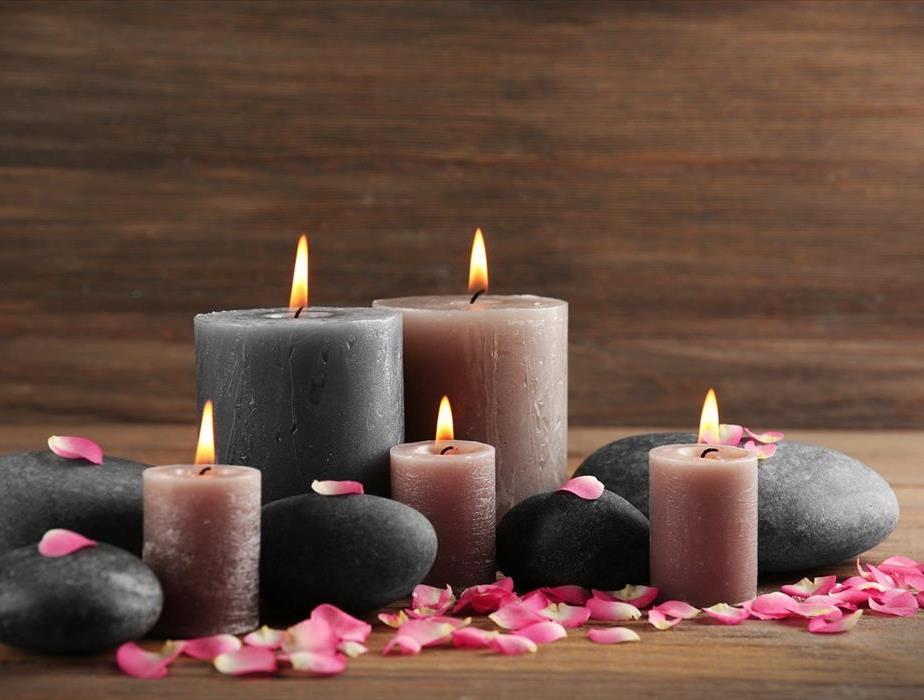 Gray and purple candles that are lit.
Gray and purple candles that are lit.
There are a lot of beautiful things that candles bring to a room in a house. They bring a nice ambiance, they are beautiful, and they can smell good. But candles carry an inherent risk: they can cause injures, and possibly a house fire.
Here are the statistics from the National Fire Protection Association. In a 5 year period (2013-2017):
Candles caused 2% of reported home fires, 3% of home fire deaths, 6% of home fire injuries, and 4% of the direct property damage in home fires.
Roughly one-third (37%) of home candle fires started in bedrooms. These fires caused 33% of the associated deaths and 51% of the associated injuries.
Falling asleep was a factor in 11% percent of the home candle fires and 19% of the associated deaths.
On average, 22 home candle fires were reported per day.
Three of every five (60%) of home candle fires occurred when some form of combustible material was left or came too close to the candle.
December is the peak time of year for home candle fires. In December, 12% of home candle fires began with decorations compared to 4% the rest of the year.
With those statistics in mind, here are some suggestions on how to burn candles safely:
Before lighting:
Always trim the wick to ¼ inch. Long or crooked wicks can cause flaring, dripping or uneven burning.
Keep the wax pool clear of debris, matches, and wick trimmings.
Make sure you have a candle holder designed for that specific candle. It needs to be heat resistant, sturdy, and large enough to contain drips.
Burn Candles in a well-ventilated room:
Stay away from drafts, vents or air currents. By doing that it will help uneven burning, sooting, and excessive burning.
It is recommended that candles do not burn longer than 4 hours, and cool at least 2 hours before relighting.
It is best to use long matches or a long lighter. Keep hair and loose clothes away from the flame.
Burning Candles 2 of 2
1/22/2021 (Permalink)
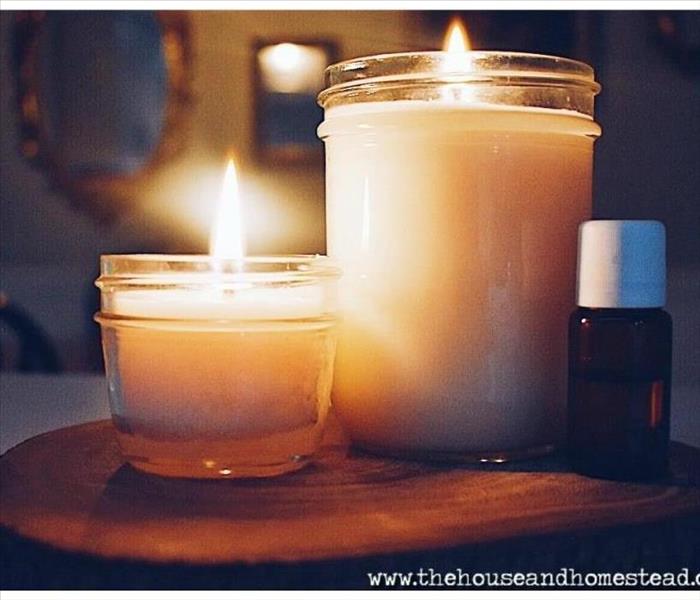 Lit candles in mason jars.
Lit candles in mason jars.
Burning Candles 2 of 2
While Burning:
Never leave candles unattended.
Keep burning candles away from furniture, drapes, bedding, carpets, books, paper, decorations, etc.
Keep candles out reach of children and pets.
Don’t touch or move a candle while it is lit and the wax is liquefied.
If using a pillar candle, don’t burn the last 2 inches; for any other type, don’t burn the last ½ inch.
If burning multiple candles, burn them at least 3 inches apart.
If the flame becomes too high or flickers repeatedly, extinguish the flame.
Never use a candle as a night light, just in case you fall asleep.
Be aware if using candles during power outages. Try having flashlights on hand. It is safer to move a flashlight around than a lit candle.
When Extinguishing a Candle:
To help prevent wax splattering when extinguishing a lit candle, use a candle snuffer.
Don’t use water to snuff out the candle. The hot wax may splatter, and the glass might break.
Make sure the candle is completely snuffed out before leaving the room. Really look at the wick and make sure there are no active embers on the tip.
It is best not to move or handle the candle until it is cooled and the wax has hardened.
If you use a knife or something metallic to scrape wax drippings off of a holder, you may end up scratching the glass, and it can become weak and break. A plastic or wood scraper is safer.
Following these guidelines, you can enjoy candles, while still keeping yourself and your home safe.
Storm Flooding
1/21/2021 (Permalink)
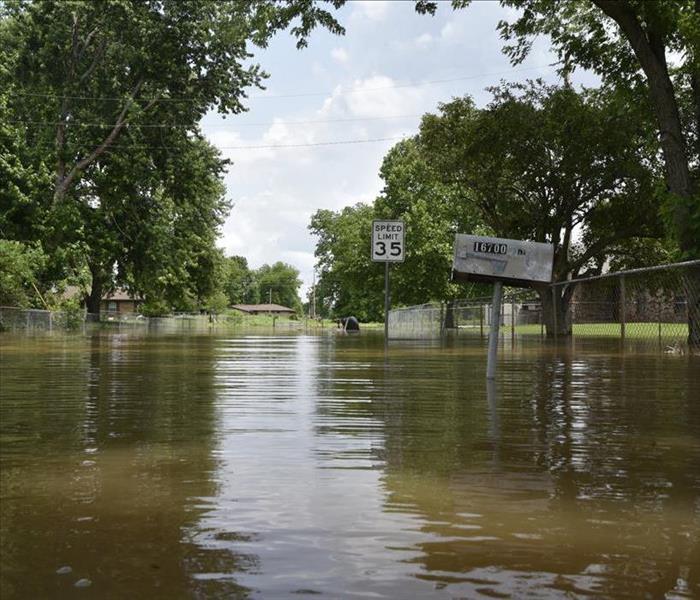 A road affected by spring flooding
A road affected by spring flooding
As we approach Spring, the rainy season is right around the corner. No matter where you live there is a good chance your town or city has flooded before, or could possibly flood. There several critical things you need to know about flood water, and the associated dangers.
Don’t drive in flooded areas:
Floodwater can pose a drowning risk
Always follow warnings about flooded roads
Do NOT drive into flooded areas; vehicles won’t protect you from floodwaters. Vehicles can be swept away and may stall out.
Stay out of floodwater:
Flood waters contain many substances that are potentially harmful to your health. Here is a list of some of these hazardous items:
Downed power lines
Human and livestock waste
Household, medical, and industrial hazardous waste
Other contaminants that can lead to illness
Physical objects such as lumber, vehicles, and debris
Wild or stray animals such as rodents and snakes
Exposures to contaminated floodwater can cause:
Wound infections
Skin rash
Gastrointestinal illness
Tetanus
If you come in contact with floodwater:
alcohol-based wipes or sanitizer
Take care of wounds and seek medical attention if necessary
Wash contaminated clothes with hot water and detergent, or consider disposal
If you have to enter flood water, be sure to wear rubber boots, rubber gloves, and goggles
What is a Flood Cut?
1/20/2021 (Permalink)
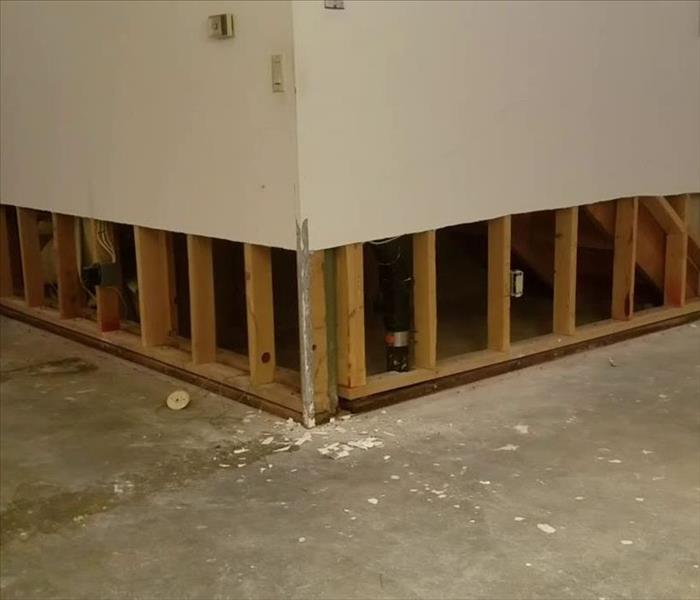 A room that had flood cuts done.
A room that had flood cuts done.
What is a “Flood Cut”?
During water damage emergency services, you may hear the term “flood cut”. A flood cut is the removal of the bottom 12-24 inches of drywall. The amount that is removed depends on how high the water has wicked up the wall, or how much of the drywall is contaminated.
There are many reason flood cuts may be done in a water-damage home or business. These reasons are:
- If the materials have been contaminated by sewage water
- If the materials have been contaminated by outdoor flood water
- If the water damaged sat for an extended number of days
- If suspected microbial growth is present
- If there is a moisture barrier behind the drywall that prevents effective structural drying
After flood cuts are done, once the sub-structure has fully dried, then materials such as insulation and drywall can be replaced.
SERVPRO technicians utilize specialized tools to cut drywall to ensure straight cut lines, and to contain dust created by cutting. We make sure we clean all work areas after we’re done by vacuuming and dusting, and properly dispose of drywall and other materials that may be removed. If appropriate, EPA-registered disinfectant is applied to the affected areas afterward.
Fire Drill
1/11/2021 (Permalink)
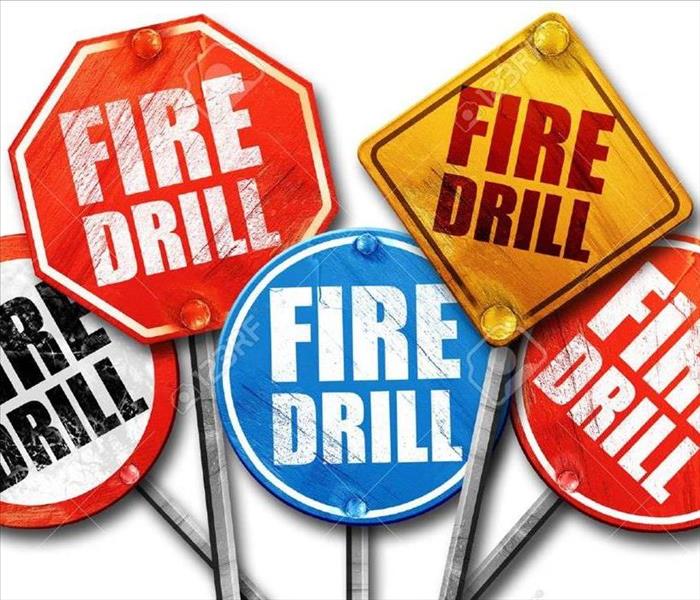 Signs that says FIre Drill
Signs that says FIre Drill
When owning or managing a business, an important safety precaution in your company is to do regular fire drills. Not only will regular drills teach new employees what to do, but it will help keep everyone informed of any changes, and to keep the proper steps in mind. With fire drills, repetition is key. By making it a habit, everyone will be be able to perform the drill without even thinking of it. They say it is good to remember the “Seven P’s” (Proper prior planning and preparation prevents poor performance). If you never have done a fire drill, or led a fire drill, here are a few steps on what to do.
Develop a detailed fire evacuation plan
You want to come up with various scenarios, considering where a fire might start in your business. Are there areas of the building at a higher risk for fire? Also, are you located in an area where a wildfire may threaten your business?
Key points in a commercial fire plan:
- Establish roles and responsibilities for the fire evacuation team
- Create a communication plan
- Plan and map out routes
- Know your tools such as fire detectors, fire alarms and fire extinguishers
- Rehearse fire drills at least twice per year
- Make sure to follow-up and report using a modern employee notification system so you can determine the safety of all employees
Setting goals
You will want to set standards and goals for the fire drill. If you include these things on your first drill, you can see about making improvement on subsequent drills. Some of the metrics that should be considered:
- Time to evacuate
- Time to report completion of the drill
- Successful shutdown of critical equipment, if applicable
Rehearse the fire drill
Doing rehearsal drills will reduce the complexity of the full drill. This should start with just the team leaders participating in the rehearsal, either in-person, or in the form of a table-top exercise. By starting this way, you can identify weaknesses in the plan, and be prepared for any confusion and questions. Once the rehearsals have corrected any problems, you should do a full rehearsal with as many employees as possible. The key to a successful fire drill is communication. Effective communication with your employees during the drill can prevent confusion.
Once you and your employees are proficient in the primary fire drill, start working on other scenarios. You want to consider fires in different locations, exits that are not working, and different possible disasters that require evacuation, so you can be prepared for anything.
Appoint observers
When you conduct a fire drill at work, you should choose a few people that are not on your team to be observers. Your observers should be looking for the following:
- Large groups moving slowly or talking with each other
- People on cell phones or using other mobile devices
- Unhelpful behavior such as grabbing coats, purses, and bags
- Difficulties for people with disabilities such as hard-to-open doors or slippery stairs
- Employees who choose a different exit rather than the one closest to their work station
Once the fire drill is all done, you and your team should sit down and do an AAR (After Action Review). Some good points to discuss:
- Did employees close the doors upon exiting rooms?
- Were employees calm and confident?
- Did everyone meet at their assigned meeting spot?
- Was the fire alarm reset and the alarm company notified of the drill (if applicable)?
- Did the building facilities, i.e. doors, alarms, automated voice commands work correctly?
Types of Biohazards
1/6/2021 (Permalink)
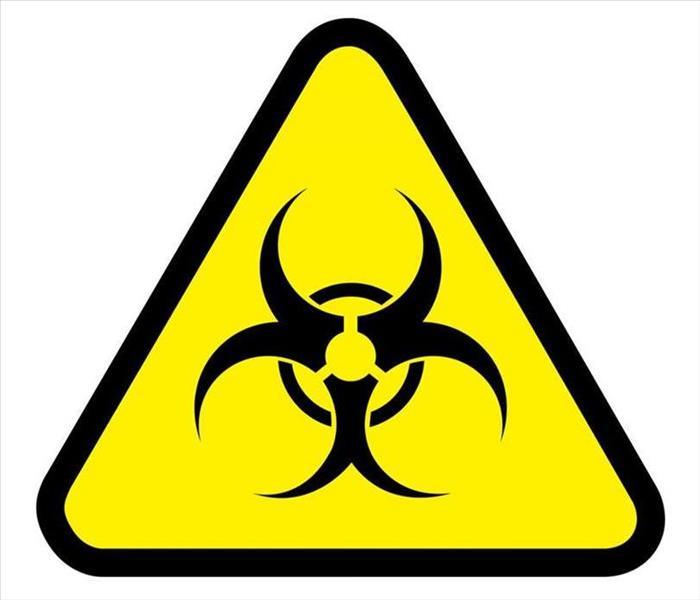 A yellow biohazard sign
A yellow biohazard sign
Many different biohazardous situations can occur in a home. Sewage backing up into a home is the most common biohazard problem. However, there are some less-frequent problems that may require special attention. In this blog, we will discuss two of these issues: Animal infestation, and hoarding. While many people think that these are not biohazard situations, they can each present health and safety risks that must be handled carefully.
Animal Infestation:
Animal infestation happens when non-pet animals take over your home. For example, birds or raccoons making nests in the attics or mice making their homes in your walls. Having these unwanted guests is not only damaging to your home, but it can be harmful to your health as well. Some animals can act as disease vectors, bring illnesses with them. Their droppings may also contain dangerous microbes that can cause disease.
Hoarding:
You’ve seen the hoarding shows on TV, and some people are wondering if that stuff is real. Well in some cases, it’s very real. There are a few different types of hoarders:
“Clean” hoarders that collect an excessive amount of stuff, but they generally keep a clean house. You normally see this in elderly couples’ homes, where they have collected many items over a period of decades.
“Dirty” hoarders that have a substantial excess of property and garbage in their home, and have lost control of the cleanliness of their living space. There may be piles of dirty dishes and trash everywhere, as well as large amounts of spoiled food. Insect and rodent infestation is a common side effect of this type of hoarding.
Animal hoarders. These hoarders have a large amount of animals in their home. They typically can’t keep up with cleanup of the animal waste, or the animals’ basic needs. This can result in dangerous amounts of bacteria from animal waste, and present a substantial health hazard.
Hoarding can cause permanent structural damage in a home. But the greater concerns are the health and safety risks involved. There can be air quality issues caused by mold or bacterial growth. Proper cleanup and waste removal are critical to bring the property back to a state that is safe for occupancy.
If you know someone that is dealing with any type of biohazard issue, SERVPRO of Casper has trained, certified technicians available to help anytime.
A leaky Shower
1/6/2021 (Permalink)
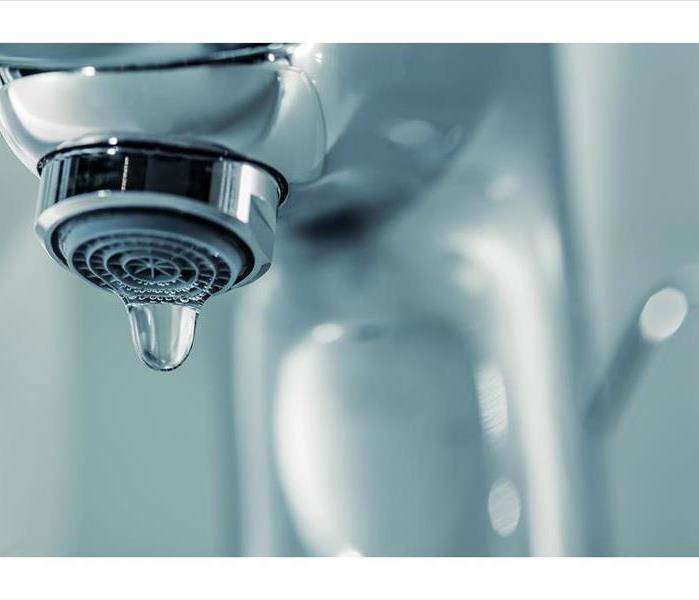 A leaky faucet with words that says "Leaking Shower Faucet?"
A leaky faucet with words that says "Leaking Shower Faucet?"
In most homes, the shower gets used on a daily basis. In many cases, it gets used multiple times a day. There is always a chance of a pipe leak, or water seeping through damaged caulking. A leak can cause a lot of damage if not taken care of in a timely manner. Here are few signs of a leaky shower.
Mold. If you clean your bathroom frequently but you still see mold outside of the tub, or if you see mold-like staining forming around the joints in the caulk or grout.
Damaged Flooring. Most bathroom floors are designed to with stand occasional water exposure. So normal exposure from water drips from getting out of the shower, or splashes from the sink typically don’t have an effect on the flooring. But if your bathroom floor is cracking, staining, or warping, that is a sign that something is not right, and you should check for leaks.
Damaged Walls. Signs of a water leak include warping, staining or browning, or bulges in surrounding drywall. Regular bathroom moisture shouldn’t cause this kind of damage.
Stained or damaged ceilings below bathrooms. If you see the ceiling in the room under your bathroom sagging, or blistering or forming a brownish stain, or blistering, you most definitely have a leakage problem. It is best to have a plumber inspect for hidden leaks.
Musty, earthy smells. Mold can create a musty odor. If you don’t see any signs of water damage, but there is a strong earthy or musty odor present, it is possible that there is a hidden mold problem. A small leak can create water damage and microbial growth inside wall cavities and under tubs without leaking into visible areas. It may be necessary to contact a plumber or other professional to determine the cause of the odor.
If you have a water or mold problem, call SERVPRO of Casper anytime. We are always here to help.
Do's and Don'ts of Fire Damage Clean Up
12/28/2020 (Permalink)
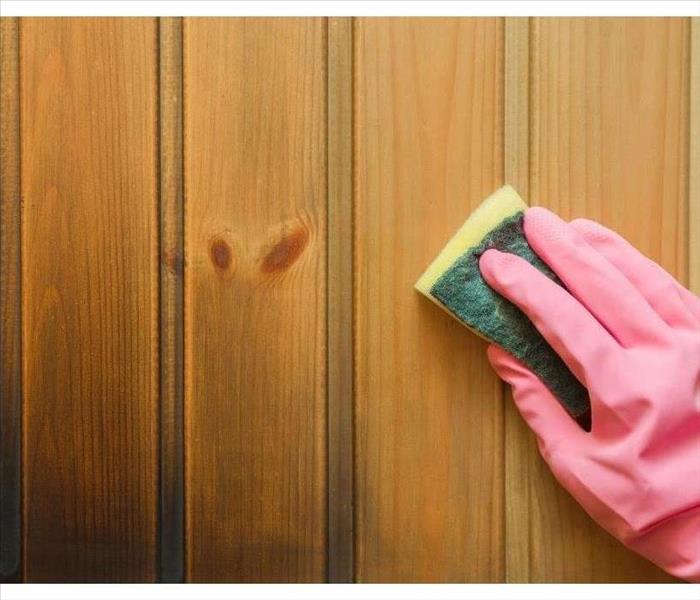 Wall cleaning after a fire/smoke damage.
Wall cleaning after a fire/smoke damage.
When a fire happens in your home, it’s a scary moment. After your home has been released, and you are allowed to re-enter it, seeing the damage for the first time can be shocking. Your first instinct is to start touching damaged items, and attempting to clean them. But we advise highly against that, as it can cause more damage by doing so. There is a lot to know when it comes to a fire clean up. To help, I’m going to provide a list of Do’s and Don’ts.
Do:
- Wear gloves before touching anything. Oils in your hands can permanently set soot.
- Limit movement in the house to prevent particles from being embedded into upholstery and carpet.
- Place dry, colorfast towels or old linens on rugs, upholstery, and carpet traffic areas.
- If the electricity is off, empty freezers and refrigerator completely. Prop doors open to help prevent odor.
- Wipe soot from chrome on kitchen and bathroom faucets, trim, and appliances. Then protect these surfaces with a light coating of lubricant.
- If heat is off during the winter, pour RV antifreeze in sinks, toilet bowls, holding tank and tubs to avoid pipe and fixture freezing.
- Wash both sides of your house plant leaves.
- Change the HVAC filter. Leave the system off until a trained professional checks the system out.
- Tape double layer of cheesecloth over air registers. This stops particles of soot from getting in the HVAC system.
Don’t:
- Attempt to wash any walls or painted surfaces until you talk to a SERVPRO professional.
- Attempt to shampoo carpet or upholstered furniture without consulting with a SERVPRO professional.
- Attempt to clean any electrical appliances. They may have been close to the fire, heat, or water source.
- Consume any food or beverages that may been stored close to a fire, or heat source.
- Turn on ceiling fixtures if the ceiling is wet. The wires may be wet or damaged and it could cause electrical shock. Air movement may cause secondary damage.
- Attempt to clean smoke-damaged laundry. If sending garments to a dry cleaner, make sure they specialize in fire/smoke damaged materials.
SERVPRO of Casper is here for you, to help you during your difficult time. We are trained and certified to assess and restore your loss. Call us at 307-235-6558 for your free evaluation.
Holiday Cooking
12/3/2020 (Permalink)
 A table that is full of a holiday meal.
A table that is full of a holiday meal.
Holiday cooking can be a lot of work, but it can also be very enjoyable. There is a lot that needs to be considered when it comes to doing a big holiday meal. How many people are coming? Do you have enough food? What time should you start cooking the bird, and all of the side dishes? With all these decisions, and the holiday conversations and chaos, safety is often forgotten.
Believe it or not, cooking is the number one cause of home fires during the holidays. The American Red Cross has come up with a list of safety items to do, so you have a safe and happy holiday.
Make sure you have a smoke alarm near your kitchen, on every level of your home, and inside and outside of any sleeping rooms if you sleep with the doors closed.
Don’t wear loose clothing or sleeves that dangle while cooking.
If you’re frying, grilling, or broiling, don’t leave it unattended. If you leave the kitchen, make sure someone is in the area or turn off the stove.
If you’re simmering, baking, or broiling food, check on it regularly.
The timer is your friend. Be sure to set it when cooking to remind you that stuff is in the oven.
It is best to keep kids and pets away from the cooking area.
Keep anything that can catch on fire away from anything that generates heat. Oven mitts, pot holders, wooden utensils, bags, towels and curtains are examples.
Clean cooking surfaces on a regular basis. This helps prevent grease build up.
Make sure you double-check all your appliances before going to bed. You want to make sure everything is shut off.
It is a good idea to get a fire extinguisher to put in your kitchen in case of an accidental fire. Make sure you purchase the proper type of extinguisher, and know how to use it.
We at SERVPRO of Casper want to wish you all a very safe and happy holiday season!!!
Holiday Light Safety
11/17/2020 (Permalink)
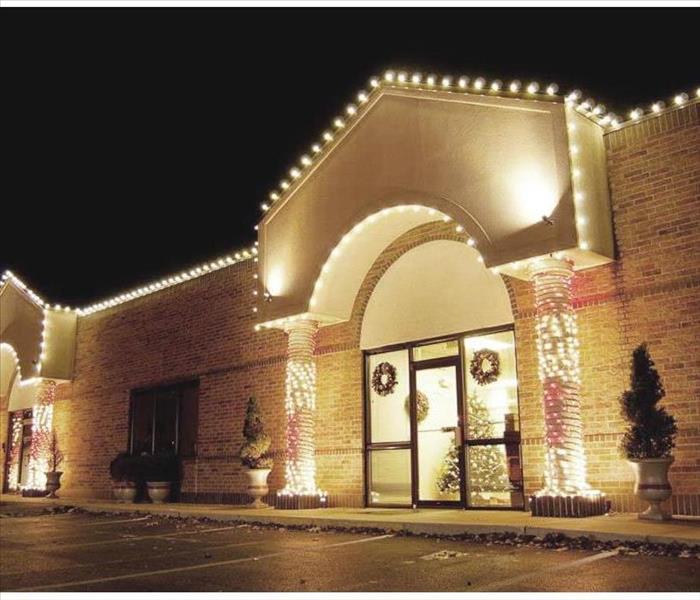 Commercial Christmas Lights
Commercial Christmas Lights
The holidays are here, and everyone is excited to start decorating. People are putting up Christmas trees, decorations, and hanging up lights throughout the house. With all the excitement, safety precautions are often forgotten. Here are a few things you may not think of, but should consider when decorating for your holiday season.
- Inspect each set of lights, even if they are new. Check for broken or cracked sockets, loose connections, or frayed wires. Discard any damaged cords.
- Plug in and inspect the lights before hanging them up.
- Make sure your lights have the Underwriters Laboratories (UL) label on them.
- Watch young children around lights and decorations, as they can easily grab and swallow them.
- Unplug all decorative lights, such as the Christmas tree, and the outdoor decorative lighting, before leaving the house or going to bed.
- If you buy an artificial tree, make sure that it has the flame-resistant label on it.
- When shopping for lights, choose LED. They last longer, and the bulbs don’t get hot to the touch.
- When using an extension cord for your outdoor lighting, use a 3 prong grounded extension with a UL label.
- Never overload outlets or extension cords.
- Cords need to stay out of water, and away from metal objects.
- Before using an extension cord, make sure the cord is fully uncoiled.
- Never place extension cords under rugs and doors or through windows where they can get pinched.
There’s a lot to look for when inspecting Christmas decorations, but taking that extra couple of minutes could help prevent an accident from happening.
Trick-or Treating Safety
10/9/2020 (Permalink)
 Kids dressed in their Halloween costumes, with their pumpkin baskets to be filled with candy.
Kids dressed in their Halloween costumes, with their pumpkin baskets to be filled with candy.
Kids look forward to October because of Halloween. They get to go trick-or-treating and collect heaping bags of candy. But there are some safety measures that need to be put in place first to make sure everyone has a fun and safe night. Here are some things to keep in mind:
Don’t go out alone – Any child 12 and under should be accompanied by an adult. Pin a piece of paper inside the child’s pocket with their name, address, and phone number in case you get separated. Encourage older children to go with friends, or friends and their parents. Make sure someone in the group has a flashlight with fresh batteries.
Set Ground Rules – If your child will be going trick-or-treating without you, make sure they communicate where they will be, and that they stay with their friends. Make sure they know not to go into houses or cars for a treat, and to only visit houses that are clearly lit.
Inspect treats before eating - Make sure your child eats dinner before going out. Explain to them to not eat any pieces of candy until you can inspect them. Discard anything that’s not sealed, is torn, or anything that looks questionable.
Ration the loot - Keep an eye out for how much your child eats, and don’t let them keep their candy in their rooms.
We hope you and your family have a safe Halloween this year!!!
Ladder Safety
10/9/2020 (Permalink)
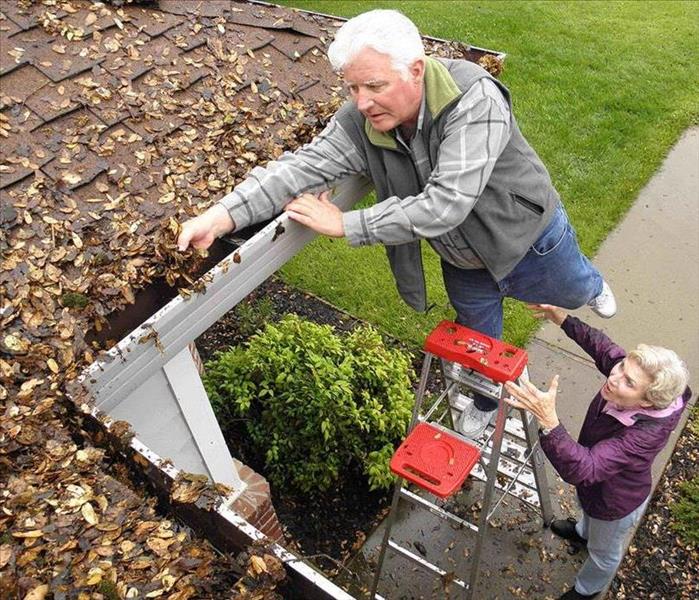 A homeowner on a ladder cleaning his gutters, with his wife holding on to the ladder for safety.
A homeowner on a ladder cleaning his gutters, with his wife holding on to the ladder for safety.
There’s a lot of safety risk when it comes to climbing on ladders. Falls from portable ladders are one of the leading causes of occupational fatalities and injuries. The following is a list of safety tips and suggestions to make sure you, and everyone around you, stay safe.
Make sure you read and follow the instructions on the ladder.
Look for overhead power lines before moving the ladder. Don’t use metal ladders near power lines or exposed energized electrical equipment.
Always do an inspection on your ladder before use. If something is broken or bent, either replace it, or get it repaired. If it’s a commercial ladder, make sure you tag it and pull it off line so another co-worker doesn’t grab it and use it.
You should always keep a 3-point contact when climbing (two hands and a foot, or two feet and one hand). Keep your body near the middle of the step and always face the ladder while climbing.
Make sure you use the right ladder and accessories for their designed purpose.
The ladder must be free of any slippery material on the rungs, steps, or feet.
Don’t use the top step/rung of a ladder as a step unless it was designated for that purpose.
Use a ladder only on stable/level ground, unless the ladder is secured to prevent displacement.
Don’t use boxes, barrels or other unstable bases to gain extra height for the ladder.
If the ladder needs moved or shifted, make sure that everyone and equipment is off of it.
The proper angle for setting up a ladder is to place its base a quarter of the working length of the ladder from the wall or other vertical surface.
If using the ladder in a place where it can get displaced by other work activities, make sure it’s secured.
Keep all traffic away from the area around the ladder.
Make sure that the locks on the on the extension ladder are properly engaged.
Be aware of the weight capacity of the ladder, and don’t exceed the maximum load. You need to take into account your weight and anything you carry on it.
Take a few minutes before getting on your next ladder by doing that inspection, and being mindful of its placement. By following these suggested ideas, serious injury can be prevented.
Autumn Storms
9/15/2020 (Permalink)
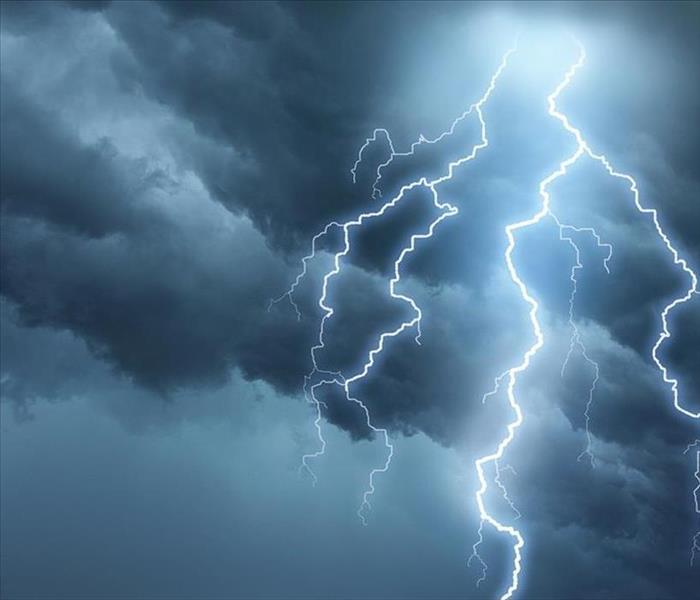 Storm clouds with lightening
Storm clouds with lightening
Autumn storms are right around the corner. The effect of these storms can be good or bad. As much as we love the sound of thunder, the jolt of lightning going through the sky and the smell of rain, there are bad things that can come along with it. Power outages are often a risk associated with storms. It’s good to know what to do in case you lose power, because you never know how long it could be out. It could be out for a matter of seconds, or for several hours. Here are some tips on what how to be prepared, and what to do during a power outage.
Keep flashlights available around your house. Avoid using candles when possible.
Keep the opening of freezers and refrigerators to a minimum. When kept closed, refrigerators can stay cool up to 4hours, and freezers can stay frozen up to 48 hours. If need be, you can put ice in a cooler to keep your food cold.
Watch out for carbon monoxide poisoning. If you are running a generator, it should be used outside and at least 20 feet away from a window or door. Never use a gas stovetop, oven, camp stove, or charcoal grill to heat your home.
If it’s cold in your home, add more layers of clothes and blankets. Don’t use the oven or a grill as a heating source. If it becomes too cold, try to make arrangements to go to another location where heat is available.
Turn off and disconnect any appliances and electronics. The power may surge or spike when it is restored, and that may cause damage to the items.
If you have a sump pump, keep an eye on it so you don’t end up with a flooded basement.
If a storm occurs, the safety of you and your family is of the utmost importance. Be safe out there!
IICRC (Institute of Inspection, Cleaning, and Restoration Certification)
9/1/2020 (Permalink)
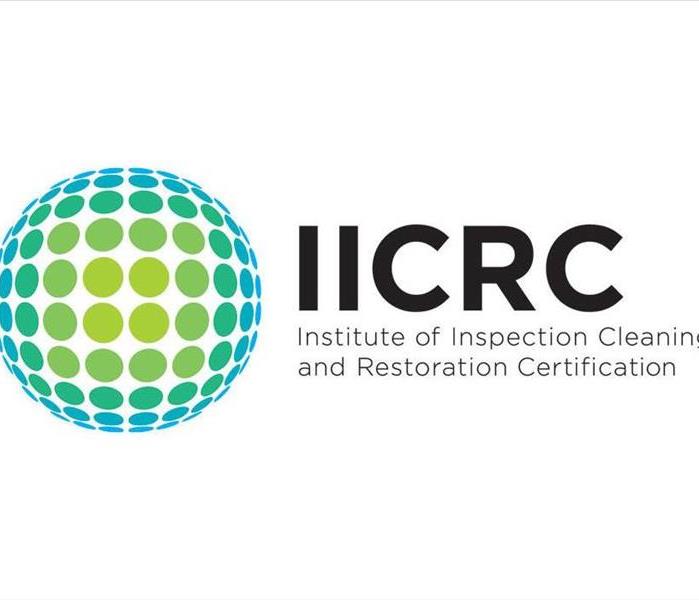 IICRC (Institute of Inspection, Cleaning, and Restoration Certification
IICRC (Institute of Inspection, Cleaning, and Restoration Certification
In the fire and water restoration business, it is important to perform all work in accordance with industry standards. Standards create a set of best practices to ensure restoration work is effective, and protects the health and safety of both workers and occupants. In the restoration industry, the Institute of Inspection, Cleaning, and Restoration Certification (IICRC) is the certifying body in the United States.
The IICRC develops and maintains standards for many facets of property restoration. It is the most utilized technical information in the inspection, cleaning and restoration industries. IICRC is ANSI-accredited, and recognized by some local, state and federal authorities.
Certification classes are taught by IICRC-approved instructors. There are over 25 certifications and continuing education requirements to maintain certification. This helps us keep all certified technicians refreshed and updated on any changes that may arise in the industry. SERVPRO of Casper is an IICRC Certified Firm. We are listed in the IICRC global locator, which is accessed by consumers and industry professionals.
A list of Certifications that is offered:
Applied Microbial Remediation Technician
Applied Structural Drying Technician
Building Moisture Thermography
Commercial Carpet Maintenance Technician
Carpet Cleaning Technician
Commercial Drying Specialist
Color Repair Technician
Floor Care (Hard Surfaces) Technician
Fire and Smoke Restoration Technician
House Cleaning Technician
Odor Control Technician
Rug Cleaning Technician
Resilient Floor Inspector
Resilient Flooring Maintenance Technician
Carpet Repair and Reinstallation Technician
Senior Carpet Inspector
Stone, Masonry and Ceramic Tile Cleaning Technician
Trauma and Crime Scene Technician
Upholstery and Fabric Technician
Wood Floor Maintenance Technician
Wood and Laminate Flooring Inspector
Water Damage Restoration Technician
If you want to learn more about the IICRC, please visit IICRC.org.
Fire Pet Safety
7/23/2020 (Permalink)
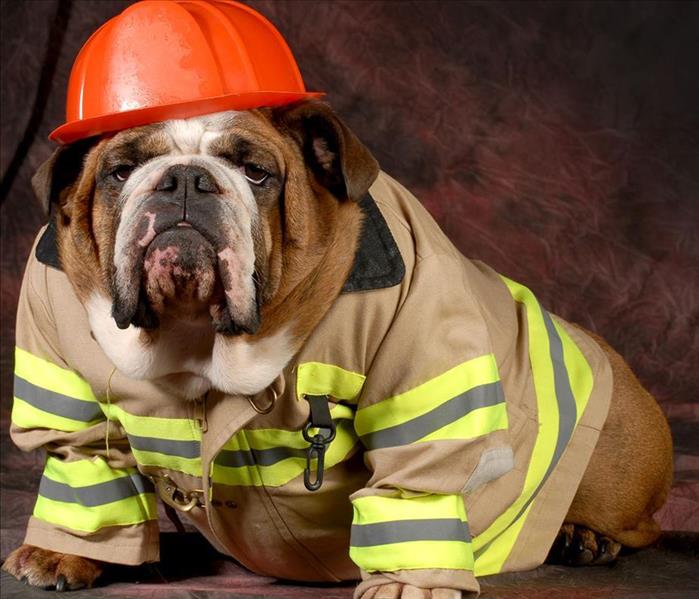 A dog in a fire fighters uniform
A dog in a fire fighters uniform
When a fire happens at your home, it can be devastating. Your first thought is to get your family (including your pets) and get out. But what if you’re not home and there’s a fire? There are 40,000 pets that die every year from a house fire, and about 1,000 home fires are accidentally started by house pets.
Prevent Your Pets from Starting Fires:
- Extinguish Open Flames – Pets are curious critters, and they want to snoop and investigate everything. They want to check out the cooking appliances, candles, and even your fire place. It’s recommended that you don’t leave your pet unattended in any areas that have an open flame. Make sure everything is snuffed out and turned off before leaving your home.
- Remove Stove Knobs - Before you leave your home, consider removing the knobs from your stove or putting a cover over them. The stove or cooktop is the most common piece of equipment involved in fires started by pets.
- Invest in Flameless Candles – Flameless candles have use an electronic light bulb instead of an open flame. If it gets knocked over, there is no risk of it starting a fire. Cats are notorious for starting fires with their tails from knocking over candles.
- Secure Young Pets – Young pets, like babies, are still learning what is right and what is wrong. Until they have learned what to stay away from, it is best to keep them away from potential hazards by containing them with kennels or baby gates.
Help Firefighters Help Your Pets:
- Keep collars on your pets, and keep their leashes close to the front door so it’s ready in case the firefighters need to save your pets. Keep them contained in a room or area that’s near the front door so it’s easy to find them.
- Put a Pet Emergency Alert sticker in the front window by the door. On the sticker, you list how many pets and what kind of pets you have, and names. This will help the firefighters know what kind of animal and how many to look out for.
The best way to protect your pets from a fire is to include them in your family plan. This includes making them their own disaster supply kit, and pre-arranging a safe place for them to stay if you should have to leave your home. When you practice your escape plan include your pets, so they will come to you when they are called. If something should happen and you must evacuate it’s important to protect them, but remember if you are struggling to get them out, don’t delay too long in getting yourself and your family out.
Reasons for Sump Pump failure 1 of 2
6/23/2020 (Permalink)
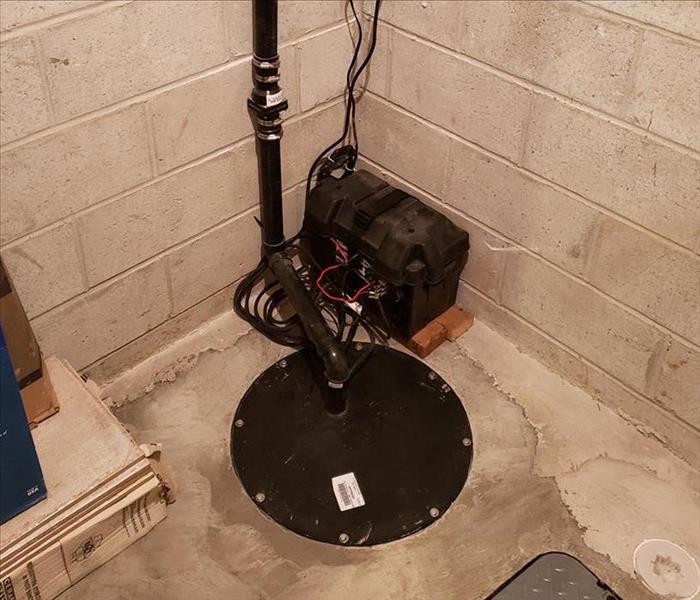 An installed sump pump
An installed sump pump
Depending on where your home is located and how it is built, a sump pump may be an important part of protecting your home from water intrusion. In some homes, the sump pump may never need to operate, or may only operate annually during a wet, rainy season. In other homes that are located near a drainage or an area with a high water table, the sump pump may need to evacuate water frequently. It’s very important to keep your sump pump maintained, whether it runs regularly or not. You don’t want to get into a situation where you need it and it’s not working. Here are a few reasons why your sump pump could fail.
- Power Failure
Power failures can sometimes happen during a bad rain storm. If the rainfall is heavy, and your sump pump is not working, you could end up with a flooded basement or crawlspace. A good way to prevent this from happening is to keep a backup generator on hand. By doing this, you can continue to power your sump pump to keep the water at bay.
- Overwhelmed Pump
Your sump pump can get easily overwhelmed by the volume of water if your sump pump is too small.
If your sump pump is too big, it can overwork and it will have a shorter lifespan. If you have questions on what size of sump pump is best for your needs, contact a local plumber.
- Frozen or Clogged Discharge Pipe
If your sump pump discharge is frozen or clogged, flood water will flow back into your basement. Since you can’t keep that pipe from freezing, you can have a specialty discharge line installed that allows water to exit your basement. A way to keep your discharge line from clogging is to install a protective grate on it.
- Lack of Maintenance
Your sump pump needs a good cleaning and some quarterly maintenance. You can run vinegar solution through your sump pump, and making sure the float switch motion is not restricted. Clean all the vents on your sump pump and the air holes on your discharge line. If your sump pump rarely runs, it is a good idea to pour a five-gallon bucket of water into the sump on a quarterly basis. This exercises the pump, and prevents seizing from lack of use.
- Old Age
With years of use and wear and tear, eventually your sump pump will give out. Sump pumps should be replaced every 7-10 years.
Reasons for Sump Pump failure 2 of 2
6/23/2020 (Permalink)
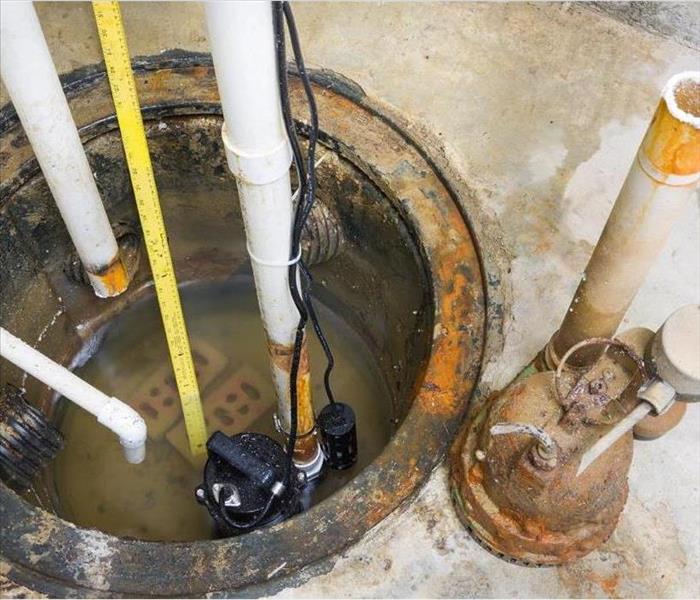 A replaced sum pump, with the failed one sitting next to it.
A replaced sum pump, with the failed one sitting next to it.
- Did Not Install a Check Valve on the Discharge Line
When the check valve is not installed on your sump pump’s discharge line, a back flow of water can cause the pump impeller to rotate backwards and unscrew off the motor shaft. If this occurs, the motor in your sump pump will sound like it is running, but it will not be pumping any water out the discharge line. A check valve is the best way to prevent this type of back flow problem.
- No Air Relief Hole in Discharge Line
A hole should be drilled between the pump and the check valve to prevent air pressure from building up. Without the relief hole, pressure will build up in the discharge line and force the sump pump to work harder. This additional burden on the sump pump will result in a shorter overall life.
- Setting Your Sump Pump in Gravel or Dirt
Some will pack their sump pumps in gravel or dirt to make it a snug fit. The gravel or dirt may cause the sump pump to fail, because the on/off switch and the float arm will be interfered with.
- Product Defect
It’s unlikely, but your sump pump could be defective. If you install it yourself, you will want to test it immediately to make sure it’s working. If it’s not, take it back to the store where you bought it, and exchange it for a different one.
- Improper Installation
If you have ruled other problems out, you should look to make sure your sump pump is installed correctly. Having the installation inspected by a licensed plumber can help determine if the sump pump will work properly when needed.
We hope you never have a sump pump problem that results in water damage. But if something should happen, just know SERVPRO of Casper is here for you anytime, day or night.
First Aid Kits
6/22/2020 (Permalink)
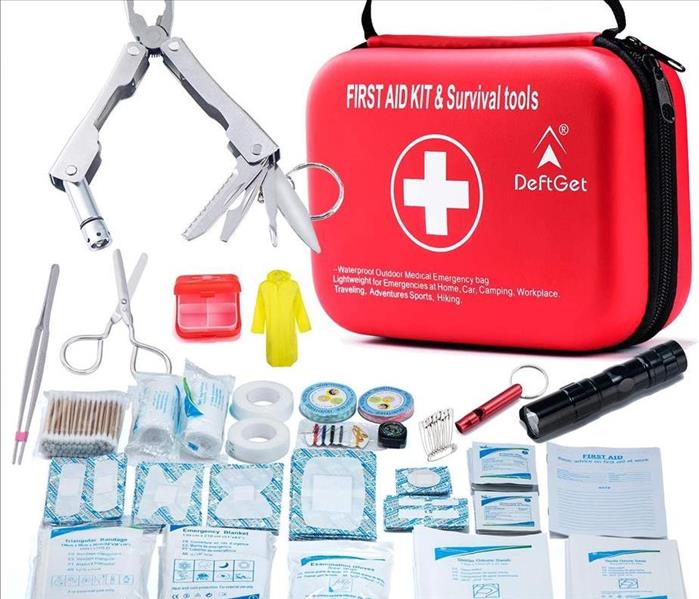 First Aid Kit with bandages, wraps, tweezers, scissors.
First Aid Kit with bandages, wraps, tweezers, scissors.
Accidents happen when you least expect them. Because of this, you should always keep a first aid kit in your vehicle and home It is also important to know the location of the first aid kits in your workplace. A well-stocked first aid kit can help you provide critical assistance in an emergency.
When it comes to a first aid kit you can buy them commercially, or make one of your own. If you decide to buy them, they come in all shapes and sizes. You want to make sure that you keep an inventory of your kit. This is especially important of workplace first aid kits, where multiple employees may use some of the smaller items in the kit from time to time. If you get kits that have medicine in them, keep an eye on the expiration date for those products.
Whether you’re buying or making them yourself, the following is suggested by the American Red Cross for a family of 4:
- 2 absorbent compress dressings (5X9 inches)
- 25 adhesive bandages (assorted sizes)
- 1 adhesive cloth tape (10yards X 1inch)
- 5 antibiotic ointment packets (approximately 1 gram)
- 5 antiseptic wipes packets
- 2 packets of aspirin (81 mg each)
- 1 emergency blanket
- 1 breathing barrier (with one-way valve)
- 1 instant cold compress
- 2 pair of nonlatex gloves
- 2 hydrocortisone ointment packets (approximately 1 gram each)
- 1 3in gauze roll bandage
- 1 roller bandage (4 inches wide)
- 5 3inX3in sterile gauze pad
- 5 sterile gauze pads (4X4 inches)
- Oral thermometer
- 2 triangular bandages
- Tweezers
- Emergency first aid guide.
Lightning Safety
6/1/2020 (Permalink)
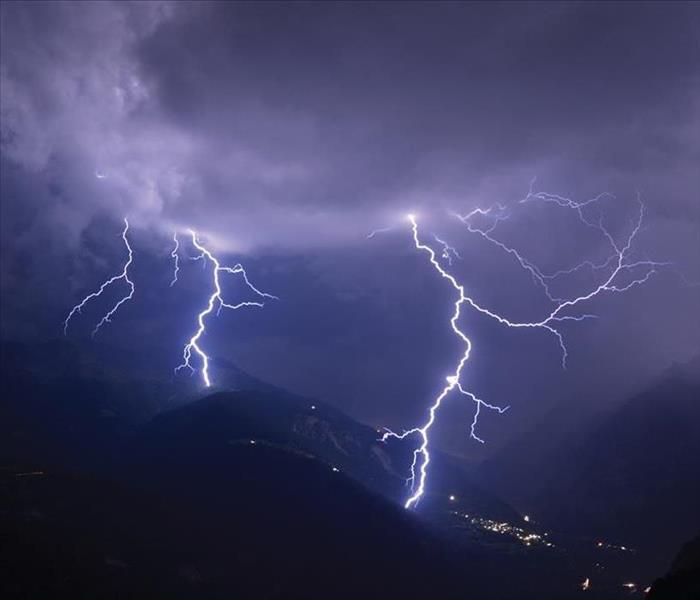 Mountains with streaks of lightning flowing across the sky
Mountains with streaks of lightning flowing across the sky
During the lightning season, you should always be prepared for changing conditions. Everyone is at risk if you have thunder and lightning where you live. You should know what to do if you get caught in a lightning storm.
Lightning and what you need to know:
- NO PLACE outside is safe when thunderstorms are in the area.
- If you hear thunder, lightning is close enough to strike you.
- When you hear thunder, move to a safe shelter. Inside a building is best. If a building is not available, a metal topped vehicle with the windows rolled up is a good alternative.
- Stay in the shelter for at least 30 minutes after you hear the last roll of thunder.
Indoor Lightning Safety:
- Stay off corded phones, computers and other electrical equipment that put you in direct contact with electricity.
- Avoid plumbing, including sinks, baths, and faucets.
- Stay away from doors and windows.
- Stay off of porches and balconies.
- Don’t lie on concrete floors, and don’t lean against concrete walls.
Last Resort Outdoor Risk Reduction Tips:
If you are in a situation where there is no shelter nearby, following these actions will help reduce your risk.
- Immediately get off of a hill, mountain ridges, peaks, or anything that is elevated.
- Never lie flat on the ground.
- Never shelter under a tree.
- Never use a cliff or overhang for shelter.
- Immediately get out of any bodies of water, including ponds, lakes, or ocean.
- Stay away from objects that conduct electricity such as barbed wire fences, power lines, windmills, etc.
Lightning is very beautiful, but also very dangerous. A typical lightning strike yields about 300 million Volts and about 30,000 Amps. A household current is 120 Volts and 15 Amps. There is enough energy in a typical flash to light up a 100-wall incandescent light bulb for about three months. Taking the appropriate safety precautions against lightning can help keep you and your family safe.
Hotel's First Impressions
6/1/2020 (Permalink)
 A hotel room with a freshly made bed with a tv, desk, and a beautiful view.
A hotel room with a freshly made bed with a tv, desk, and a beautiful view.
When operating a hotel you know that first impressions are everything! What does a guest see when they first walk into your lobby? What do they see (or smell) when they step into their hotel room for the first time? It is very important it is to make sure your guest rooms and facility are clean, and look their very best. By having a facility that looks and smells good, you are well on your way to developing a guest that will come back time after time, and possibly refer their friends and family to stay at your place. SERVPRO of Casper offers a variety of services to help freshen up your hotel, and strengthen your first impression.
There are a wide variety of materials and surfaces in your hotel that we can clean and deodorize. Here’s a list of some of the things we can clean:
- Carpets
- Upholstery
- Area Rugs
- Drapes
- Tile
- HVAC and Duct Cleaning
If your hotel needs some freshening up, have some comfort knowing that SERVPRO of Casper has the training and tools to get your hotel looking and smelling its very best!
Tips on Extinguishing a Grease Fire
6/1/2020 (Permalink)
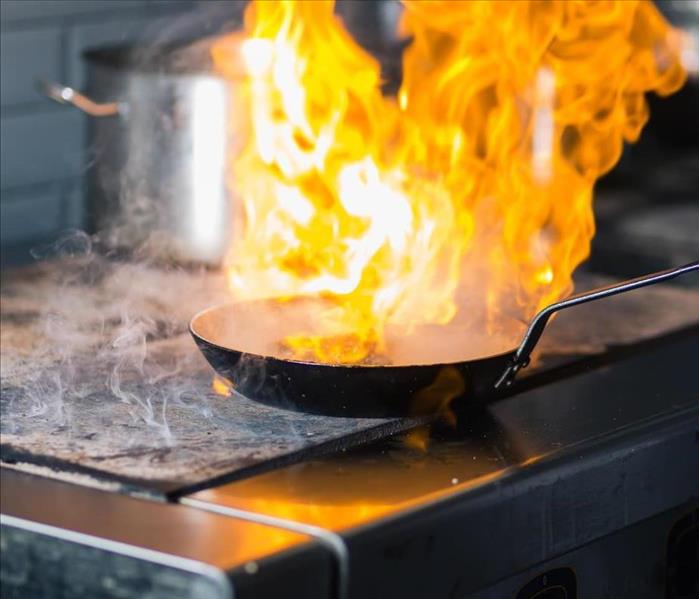 A pan that caught on fire from grease.
A pan that caught on fire from grease.
Cooking is the number one cause in home fires and injuries. Annually, there are 160,000 cooking fires caused by ignition of food or cooking materials.
Knowing how to smother a grease fire can help keep you, your family, or friends from getting hurt or having a severe house fire.
If A Grease Fire Starts:
- Cover the flames with a metal lid or cookie sheet. Leave the cover on until it has cooled.
- Turn off the heat source.
- If it’s small and manageable, pour baking soda or salt on it to smother the fire.
- As a last resort, spray the fire with a Class B dry chemical fire extinguisher.
- Do not try to extinguish the fire with water.
- Do not attempt to move the pot or pan outside.
DO NOT use flour, baking powder, or other cooking powders that resemble baking soda or salt. They act differently, and could make the fire worse.
If You Are Unable To Extinguish The Grease Fire:
- GET OUT!! You need to leave as soon as possible to prevent injury or loss of life
- When you leave, close the door behind you. This will help contain the fire inside.
- When you get to a safe distance from the fire, call 911 right away.
- Don’t re-enter your home until it has the “all clear” from the fire department.
Tips To Prevent Grease Fires:
- Stay in the kitchen while you’re cooking. One of the leading causes of kitchen fires is unattended cooking.
- Don’t cook if you’re exhausted or inebriated.
- Keep anything that can catch on fire away from your stovetop.
- Remove as much moisture from the food, and don’t add frozen foods to hot oil.
- Keep an eye on the temperature of your oil. If you see smoke or smell oil, that means your oil is too hot. Turn off the burner and let it cool down.
- Heat the oil slowly.
- Add food gently, so there is no splashing.
- Keep a lid in arms reach in case of a fire.
- Always keep children and pets away from the stove while cooking.
Spring Cleaning 2 of 2
3/18/2020 (Permalink)
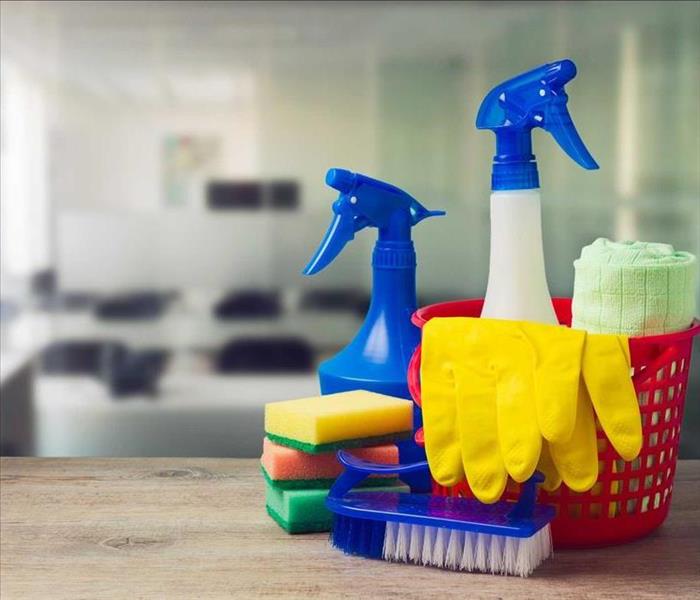 Cleaning Supplies for Spring Cleaning
Cleaning Supplies for Spring Cleaning
In the last blog, we talked about strategy when it comes to commercial spring cleaning. In this blog, I’ll give you a list of services that are recommended. Most of these items are commonly thought of during spring cleaning in a commercial setting. But some of them are often forgotten.
Flooring
- Deep-clean carpets to remove stains.
- Deep-clean floor mats before storing.
- Move file cabinets, conference tables, desks, and other large furniture items to clean the whole floor.
- Clean baseboards and corners with a high-powered vacuum.
- Buff and scrub tile and concrete.
- Consider re-finishing and re-sealing floors for a renewed appearance.
- Look for fire or safety hazards on the floor. Remove any floor or stairway blockages.
- Inspect tile for breaks, dents, or cracks.
Walls
- Look for chips or cracks. You will have to evaluate if a small coat of paint will fix the problem, or more work will be necessary.
- Clean all windows inside and out to remove dust and marks. If some of the windows are too high, you may have to hire a window cleaning company.
- Dust and wash all blinds and drapes. This is usually forgotten during the weekly cleanings.
- Dust light fixtures and door tops.
- Knock down “dust bunnies” and spider webs from high corners and sides.
Furniture
Deep-clean upholstery. Not only does it remove dirt and stains, but it helps with the appearance and smell.
Wipe down and sanitize all desks.
Wipe down conference room tables, trophy cases, and other shelving units.
Bathrooms
- Deep clean the floor and baseboards. If the flooring is tile, scrub the grout.
- Sanitize and deep clean all surfaces with bleach-based products.
- Replace toilet paper, paper towels, and soaps.
- Clean all trash cans, including the small ones in the stalls.
Breakroom
- Clean all trash cans.
- Deep-clean all appliances inside and out, including refrigerator, microwave, and coffee maker.
- Clean and disinfect all surfaces on tables and chairs.
- Sort all items in the refrigerator. Remove old, expired foods and condiments.
Other
- Dust and clean computers. Unplug the keyboards and shake them upside-down over a trash can. Use a microfiber cloth to wipe down screens.
- Disinfect surfaces that people touch on a regular basis, such as door handles/knobs, elevator buttons, and handrails.
Commercial Spring Cleaning 1 of 2
3/4/2020 (Permalink)
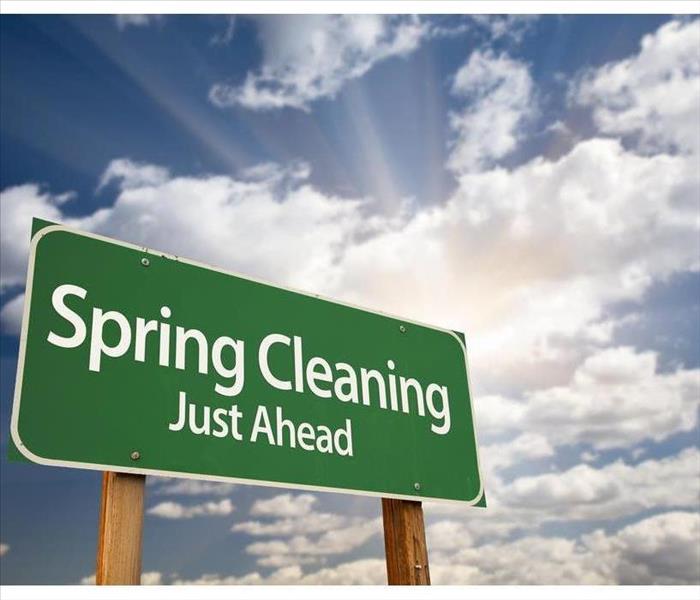 Road sign saying Spring Cleaning Ahead
Road sign saying Spring Cleaning Ahead
Spring Cleaning Checklist For Your Commercial Building (1 of 2)
Commercial spring cleaning is different from residential spring cleaning. There is typically more square footage to clean, and more organization and participants is necessary.
You should start off by creating a checklist for each room you want to have cleaned, and what day you want to do that cleaning. Once you have compiled your list, you should communicate it to all parties involved (email is a great way of doing this). Your employees should have advance notice when their area will be cleaned, and what is going to be done in their area. This will also give them enough time to get their stuff cleaned up, and if necessary, removed and boxed up from their shelves and desks. By being organized and staying in contact with the proper people, your cleaning will get done more efficiently. Please check out my next blog on some ideas on what type of spring cleaning to do.
Flood Alerts
3/4/2020 (Permalink)
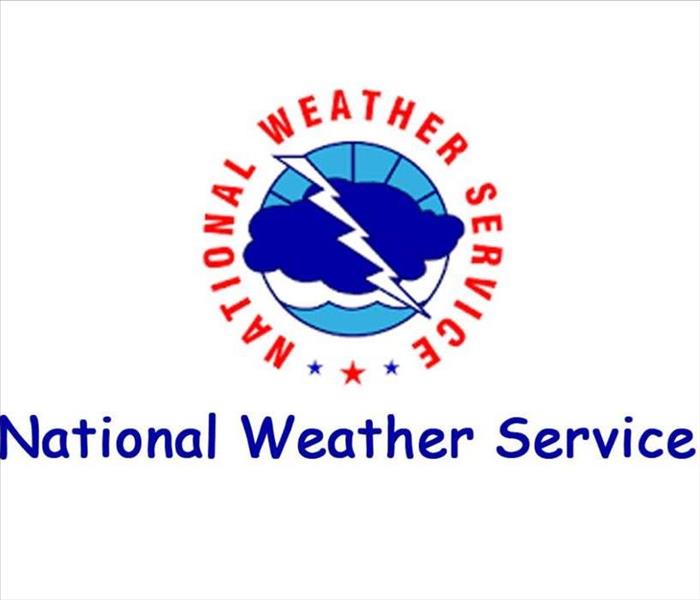 For flood advisories you should look to, The National Weather Service website
For flood advisories you should look to, The National Weather Service website
When it comes to weather alerts, there is always confusion on what flood watch, flood warning, and flood advisories, and flash flood warning mean. It’s good to know the difference so you can take the appropriate course of action for each event. According to the National Weather Service, here is the meaning of each of these alerts.
Flash Flood Warning: Take Action! A flash flood warning is issued when a flash flood is imminent or occurring. If you’re in a flood prone area, move immediately to higher ground. A flash flood is sudden and violent, and it could take anywhere from minutes to hours to develop. It’s even possible to experience a flash flood in areas not immediately receiving rain.
Flood Warning: Take Action! A flood warning is issued when the hazardous weather event is imminent or already happening.
Flood Watch: Be Prepared: A flood watch is issued when conditions are favorable for a specific hazardous weather event to occur. A flood watch is issued when conditions are favorable for flooding. It does not mean that flooding will occur, but it is possible.
Flood Advisory: Be Aware: A flood advisory is issued when a specific weather event that is forecast to occur may become a nuisance. A flood advisory is issued when flooding is not expected to be bad enough to issue a warning. However, it may cause significant inconvenience, and if caution is not exercised, it could lead to situations that may threaten life and/or property.
Hardwood Drying
2/26/2020 (Permalink)
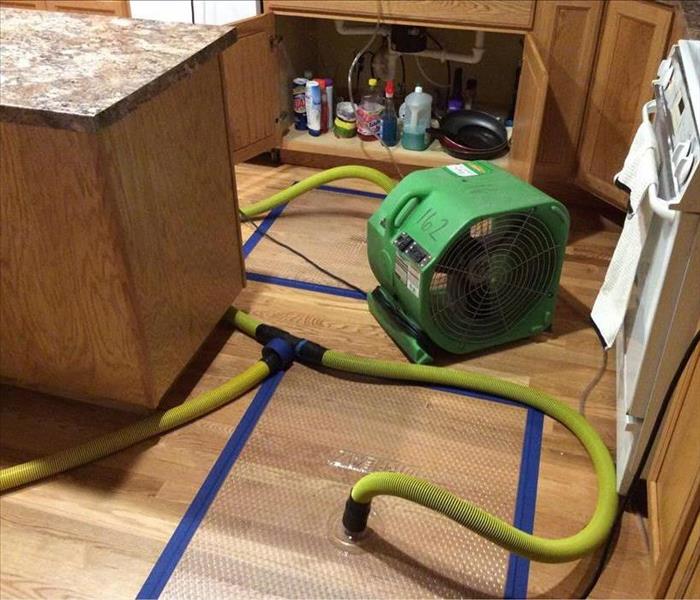 A specialty mat system and an air mover drying out the wet hardwood flooring
A specialty mat system and an air mover drying out the wet hardwood flooring
There’s a misconception that when hardwood flooring gets wet, it must be removed because it’s ruined. Frequently, that’s not the case. SERVPRO of Casper has the tools and training to evaluate and dry out hardwood flooring. We use specialized drying mat systems and balanced dehumidification to dry hardwood quickly, saving you the time and expense of flooring replacement. When evaluating water-damaged hardwood flooring, the length of time it has been wet is a critical factor. If the flooring is allowed to dwell in water for too long, it is possible for the boards to cup, warp, and possibly break. Rapid response is critical to success in saving hardwood.
When we respond to a water damage with affected hardwood flooring, we perform a preliminary inspection. What areas are wet? How long have they been wet? And specifically how wet is it? We use a combination of flooring extraction mats, and a powerful truck-mounted extraction unit to pull as much free water out of the flooring system as possible. After that’s done, we set up our drying equipment, and start the drying process. We return to the site daily to monitor the progress of the drying, using meters specially-designed for hardwood. Once the moisture level in the wood reaches an acceptable level, the hardwood flooring can be inspected by a flooring contractor.
Inventorying Your Fire Loss
2/26/2020 (Permalink)
 Inventorying Your Fire Loss
Inventorying Your Fire Loss
How to complete a total loss inventory list after a house fire
If you have a major fire that destroys your home, you will have to start the contents inventory process. Documenting your personal property will be necessary to ensure you get fully compensated for what you lost. Doing this full inventory is a high-stress task, but it must be done correctly and accurately. It is important to know ahead of time that the inventory process will be messy, time-consuming, and will require a lot of patience. You will be documenting a large portion of your family’s life, which can be emotionally difficult.
Before entering your home after a fire, you should always get permission from the fire department. They need to confirm that the scene has been released, and is no longer being investigated. When you have approval to enter your home, you want to make sure that you are wearing the proper protective gear. A long-sleeved shirt, long pants, close-toed shoes or boots, work gloves, hard hat, and safety glasses can help protect you from hazards. A disposable respirator with a NIOSH rating of N95 will help protect your respiratory system from inhaling ash, soot, and other toxic materials that may be present in the air.
- Start the inventory by making a diagram of your house and label all the rooms. In the rooms start drawing big furniture, and electronics. By doing this it will help jump start your brain into remembering what was in the rooms.
- Start one room at a time. Gather your smaller stuff. Place them on flat surfaces like some sort of tabletop. This is so you can get a good picture of your items. Make sure you do this with all the items so you have photos for everything. Once that room is done, then it’s time to move on to the next.
- When you are done photographing, then it’s time to start making your list. You will want to include brand, age, quantity, cost and condition. Model numbers and serial numbers, when available, should be documented. You need to be specific as possible to make sure you get the proper compensation.
- Note the price you paid for each on your inventory sheet, and include the receipts, if available. If you can’t remember what the value of an item is, sometimes you can research the valuation on the internet. If you find a price on the internet, be sure to note the cost to replace your damaged item with a new item of like kind and quality.
Fire Place Maintenance
2/24/2020 (Permalink)
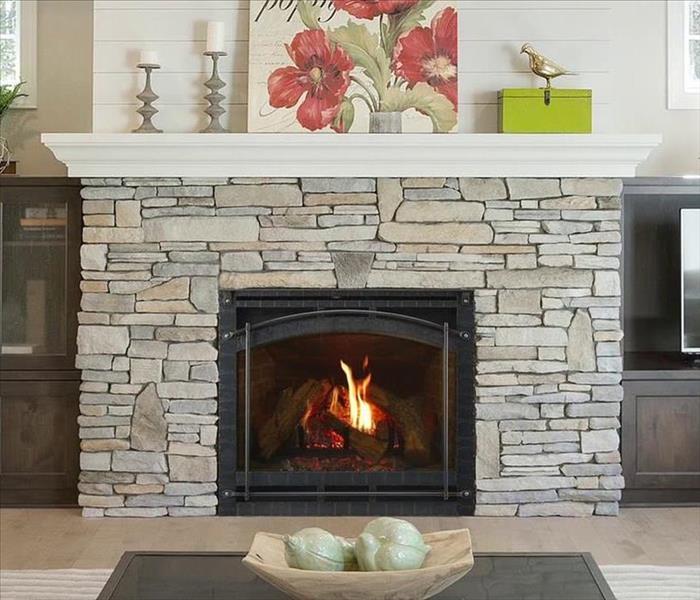 A fireplace with burning wood. Keeping the room nice and warm.
A fireplace with burning wood. Keeping the room nice and warm.
When your home has a fireplace, there is a lot of responsibility in maintaining it. Before you use it, make sure it is in good working order, and cleaned out properly. If it’s not maintained regularly, it could cause a structure fire, smoke could puff back in the house, or it could cause carbon monoxide poisoning. We’ll provide a few easy steps to take to make sure your fireplace is safe.
- Your chimney should be swept inside at least once a year, and it should be at the beginning of the year. By sweeping the chimney, it will help remove soot and debris. When you’re sweeping you should look for any animals that may have crawled in and died.
- Before you start the fire, check the structure of your chimney. You want to make sure there are no cracks, loose bricks, or missing mortar. Also look for any deterioration. Cracks and spalling are signs of deterioration.
- Use a wire-mesh cap on top of the chimney to keep the birds, squirrels, rain and other debris from entering.
- Check the damper; the damper is a movable plate that sits above the fireplace before the flue. Make sure the damper is working properly. There should be no debris preventing it from opening and closing.
- When cleaning the chimney, you want to keep an eye out for creosote buildup. Creosote is a chemical mass of carbon formed when wood, tar or fossil fuels are burned. Even though you can’t see it from the outside doesn’t mean that the buildup is not on the inside. When it’s not properly removed, it can build up in the flue and chimney, potentially causing a chimney fire.
- Make sure there isn’t anything hanging over the chimney, such as tree limbs, flags, etc. They could be a fire hazard, and it could interfere with proper draft airflow.
- Clean out ashes regularly. You should clean out the ashes from the last time you ran your fireplace. You can simply sweep or vacuum the cold ashes and dispose of them. Be aware that there could be hot coals in the mix. Hot coals can stay hot for up to 3 days.
If you don’t have experience in cleaning or maintaining your fireplace or know what to look for, call a local professional. They have the tools and resources to make sure that your chimney is up and running safely for the winter time.
Fire Sources To Watch Out For
2/24/2020 (Permalink)
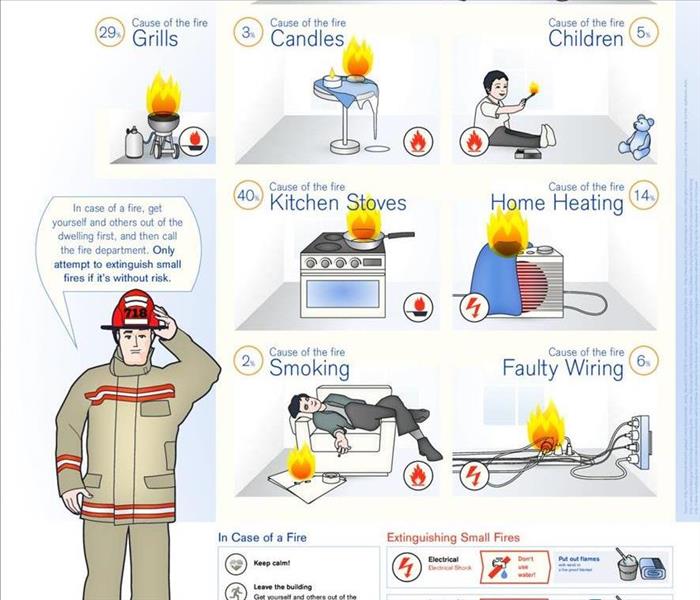 Pictures of some of the main sources of fires.
Pictures of some of the main sources of fires.
Whether you live in a house, trailer, or an apartment, you are always at risk for a fire, or smoke damage. It’s a good idea to know what some of the main sources are.
- Cooking equipment – Cooking is one of the leading causes of house fires. When you get a pan of oil or grease too hot on the stove, it makes it very flammable and it can flash. Holiday cooking is another cause. When cooking during the holidays you’re preparing multiple dishes at once, while entertaining guests at the same time. If you’re not paying attention, a simple mistake such as laying a towel too close to the stove flame can cause a fire. Another source would be kitchen appliances, such as crockpots, toasters, and griddles. An electrical short from a damaged cord, or putting a hot appliance away before it has fully cooled, can cause damage.
- Candles – If a candle is allowed to burn too closely to curtains or flammable items, they could catch on fire. Also, leaving candles burning unattended can lead to a mishap.
- Smoking – If a cigarette or cigar is not completely snuffed out, the embers could still be a risk to ignite a fire.
- Children playing with fire – Most children are curious with fire, and what can cause it. They see someone light a match, or a lighter, or even the gas stove, they want to get ahold of it and light it themselves. Because they don’t understand the risk of what could happen, sometimes an accidental fire can happen.
- Barbeque – During the summer, there is a lot more outdoor cooking. Most outdoor cooking is done on a gas appliance, or using a charcoal or wood fire. You never want to leave a grill unattended on a wooden porch. And it is important to avoid grilling too closely to a house or fence.
- Wiring – When it comes to the wiring in your home, you don’t want to take any short cuts. It should be up to date, and installed by a professional. Overheating or an electrical short can quickly start a fire inside the walls of your home.
- Christmas tree – The Christmas tree is everyone’s favorite, whether it’s a real tree or artificial. If it’s a real tree, you want to make sure that the stand is full of water so the tree doesn’t dry out. With both artificial and natural trees, placing them too close to a heat source (such as a fireplace or baseboard heater) can be a fire hazard.
- Heating Equipment – During winter, it is a common practice to use a space heater to warm up a cold area in a house, or to add heat to a garage. It is critical that space heaters are kept a safe distance from any combustible materials. Walls, clothes, curtains, and furniture can ignite if they are too close to a space heater. The same holds true for electric baseboard heat registers. A safe radius of at least six inches from the front and sides of the unit should be kept clear of any combustible materials.
Some fires are accidental and beyond your control. But most can be easily prevented through basic safety precautions. Always be aware of the steps you can take to prevent a fire.
Frostbite Stages and Treatments
2/14/2020 (Permalink)
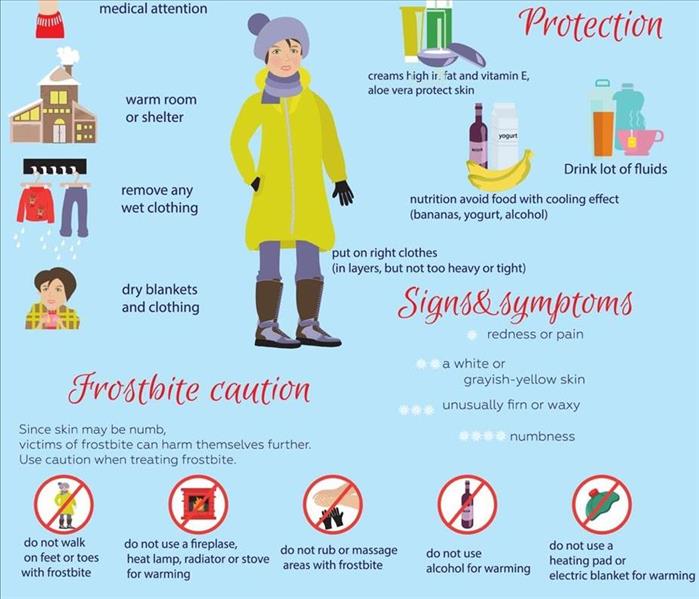 A list of frostbite treatments, protection, signs & symptoms, and frostbite cautions.
A list of frostbite treatments, protection, signs & symptoms, and frostbite cautions.
Frostbite is very dangerous, and should be treated seriously. There are 3 stages of frostbite, and the appropriate treatment for each stage is different. The three different stages are:
Frostnip – Frostnip is a mild form of frostbite. Continued exposure leads to numbness in the affected area. As your skin warms you may feel pain and tingling. This type of frostbite doesn’t permanently damage the skin.
Superficial frostbite – Superficial frostbite appears as reddened skin that turns white or pale. The skin may begin to feel warm; this is a sign of serious skin involvement. If you decide to treat the frostbite with rewarming at this stage, the surface of your skin may appear splotchy. There also may be some stinging, burning, and swelling. Fluid-filled blisters may appear around 12-36hrs after rewarming.
Deep (severe) frostbite – When frostbite progresses, it affects all layers of the skin, including the tissue that lies below. The skin will turn white or a bluish gray, there could be numbness, and loss of sensation of cold, and there will be discomfort. The joints and or muscles may no longer work. Large blisters from 24-48hrs after rewarming. Afterward, the area turns black and hard, because the tissue has died.
When to see a doctor –
If you have any of these symptoms you should seek medical attention:
- Signs of superficial or deep frostbite
- Increased pain, swelling, redness or discharge in the area that was frostbitten
- Fever
- New, unexplained symptoms
If you have been affected by any of this, and are waiting for emergency medical or a doctor’s appointment, there are a few things you can do in the meantime.
- Protecting the affected area from further cold
- Not walking on frostbitten feet
- Reducing pain with ibuprofen
If you suspect hypothermia, get emergency medical help right away. Hypothermia is a condition where your body loses heat faster than it can be produced. Some of the symptoms include:
- Intense shivering
- Slurred speech
- Drowsiness and loss of coordination
Water Damage Sources
2/13/2020 (Permalink)
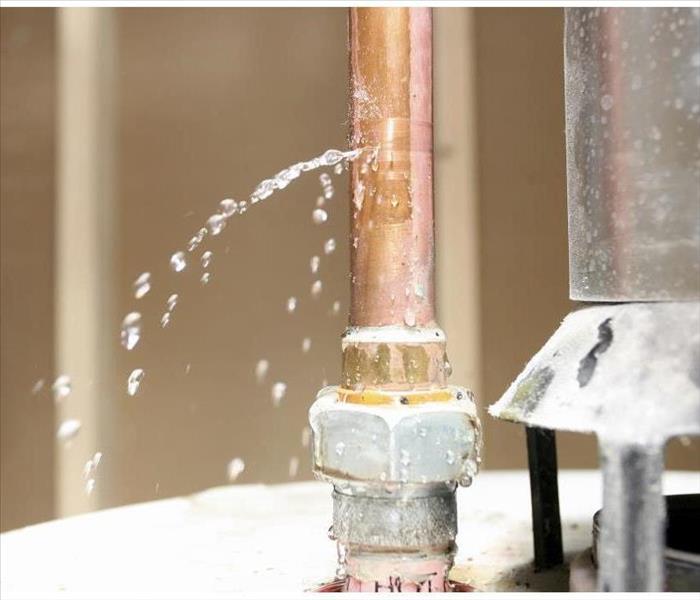 A water heater with a hole in the pipe and water bursting out.
A water heater with a hole in the pipe and water bursting out.
When a water damage happens in your home, several factors must be evaluated quickly. One of the key factors is the source of the water intrusion. When it comes to finding the source, it is good to start checking pipes.
- Sink pipe
- Toilet supply line
- Water heater
- Water softener
- Washing machine lines and connections
- Ice maker line
- Dishwasher
Another source could be flooding, or ground water.
- Is water coming in from the foundation?
- Is it coming from the window, or around a window frame?
- If you have a sump pump, is it coming from the hole where the sump is?
When you have a water loss, it’s important to find where the source is. It helps not only the contractors address the issue quickly, but it also helps the insurance adjusters that are investigating the claim. If the source is a pipe break, you should shut off your water as close to the source as possible.
Once you have figured out where the water is coming from, and you have stopped it from coming in, you should contact a qualified plumber. Then you need to call your insurance company, and a qualified restoration company to start the water removal and structural drying processes.
Winter Storm Precautions
2/13/2020 (Permalink)
 Handling the Winter Storm Months
Handling the Winter Storm Months
Throughout most of the country, the winter season can result in the occasional severe winter storm. Heavy snowfall, strong winds, and extremely cold temperatures can cause entire cities to shut down. Winter storms sometimes last for a few hours, but can extend into a number of days. These severe conditions can cause interruption in heating and power in homes and businesses, as well as knocking out telephone and internet communications. The risk of car accidents, frostbite, and hypothermia can increase in severe weather events. Fortunately, local media (such as TV, radio, and online news sources) can normally give a few days’ notice prior to the arrival of the winter storm.
If you know that a winter storm is approaching, it is best to be prepared as possible:
- Stay off roads
- Stay indoors and dress warmly
- Prepare for power outages
- If you have generators, use them outside only, and away from windows
- Listen to the TV or Radio for emergency updates
- Keep watch for hypothermia and frost bite, if you must go outdoors
- Check on your neighbors, especially if they are older or sick
Please check out my next blog on signs and symptoms of frost bite.
Ice Dam Control
1/22/2020 (Permalink)
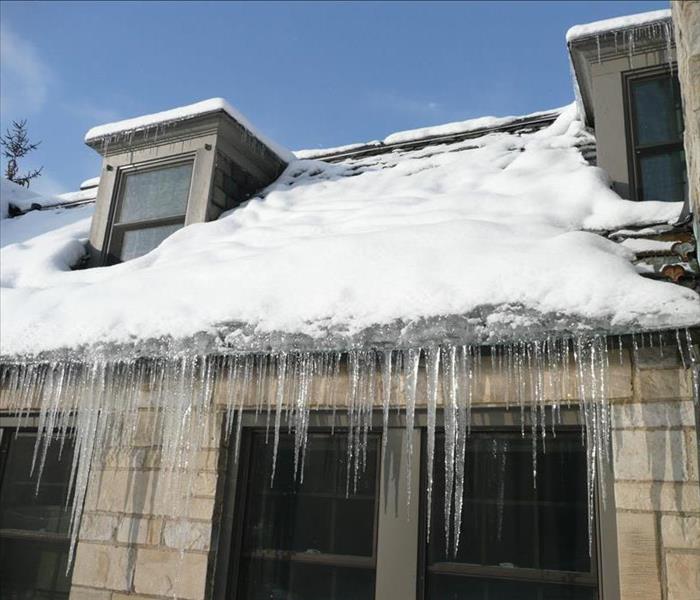 A snowy roof with ice crystals hanging off the gutters.
A snowy roof with ice crystals hanging off the gutters.
You may not see it on your roof, but in the wintertime, ice dams can form and cause serious damage.
An ice dam is a ridge of ice that forms at the edge of a roof and prevents melting snow from draining off the roof. The water that backs up can leak into homes, causing water damage on ceilings, walls, insulation and other materials.
Long term suggestions or immediate action on how to avoid an ice dam:
Short-term action:
- Remove snow from your roof.
- Use a roof rake or push broom. But be careful, it may damage roof materials.
- If you find water flowing into your house creating areas that water can drain off the roof is important.
- Hose down the roof with tap water on a warm day.
- Work upward from the lower edge of the dam.
Long-term action:
- Make the ceiling air tight so no warm, moist air can flow from the house into the attic space.
- After sealing air leakage paths between the house and attic space, consider increasing the ceiling or roof insulation to cut down on heat loss by conduction.
Roof & Attic Ventilation
Natural roof ventilation can help with uniform temperatures. If all other attic issues have been properly corrected, only a small amount of ventilation will be needed to prevent excess warmth in the attic.
If an ice dam has caused water damage within your home, SERVPRO of Casper is always here to help. Feel free to contact us anytime for a damage assessment and consultation.
Slips, Trips, and Falls
1/22/2020 (Permalink)
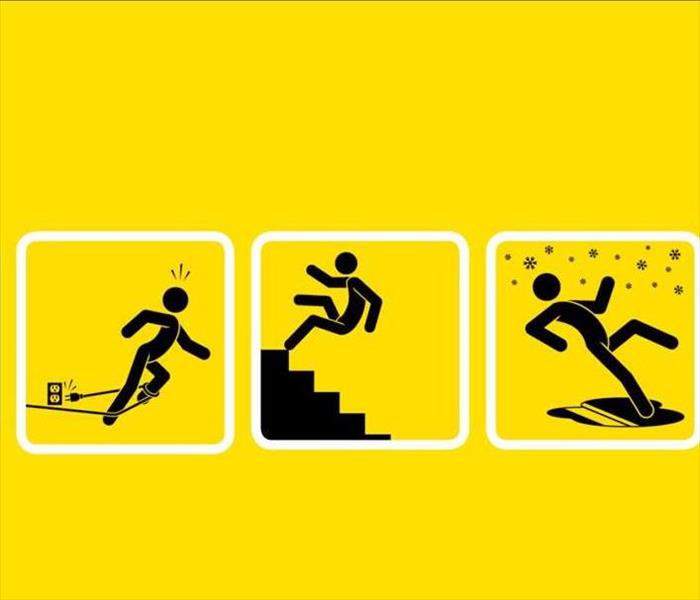 Photos of Slip, Trips, and Falls.
Photos of Slip, Trips, and Falls.
Slips, trips, and falls are the number one cause of injuries in the workplace. When someone gets injured on the job, not only does it hurt the employee physically and financially, but it also hurts the employers through increased insurance rates and lost productivity.
Typical locations on the body for slip, trip, and fall injuries:
- Knee, ankle and/or foot
- Wrist and/or elbow
- Back and/or shoulder
- Hip
- Head
Typical Injuries:
- Sprains and strains
- Bruises and contusions
- Fractures
- Abrasions and lacerations
Some common workplace trips:
- Uncovered hoses, cables, wires, or extension cords across aisles or walkways
- Clutter, obstacles in aisles, walkway and work areas
- Open cabinet, file or desk drawers, and doors
Human Factors:
- Carrying or moving cumbersome objects, or moving too many items at one time
- Not paying attention to surroundings or being distracted
- Taking unapproved shortcuts
- Being in a hurry and rushing
- Failing eyesight and/or visual perception
- Age
- Stress or Illness
- Medications, alcohol and drug effects
Measures to Prevent Slips, Trips, and Falls:
- Design of workplace & work processes
- Design workplace and processes to prevent potential exposures to slip & trip hazards
- Good housekeeping
- Maintain clear, tidy work areas free of clutter
- Safe walking practices
- Follow safe walking practices and routes
- Wear proper footwear with good traction
How To Keep You From Getting Back Pain
1/22/2020 (Permalink)
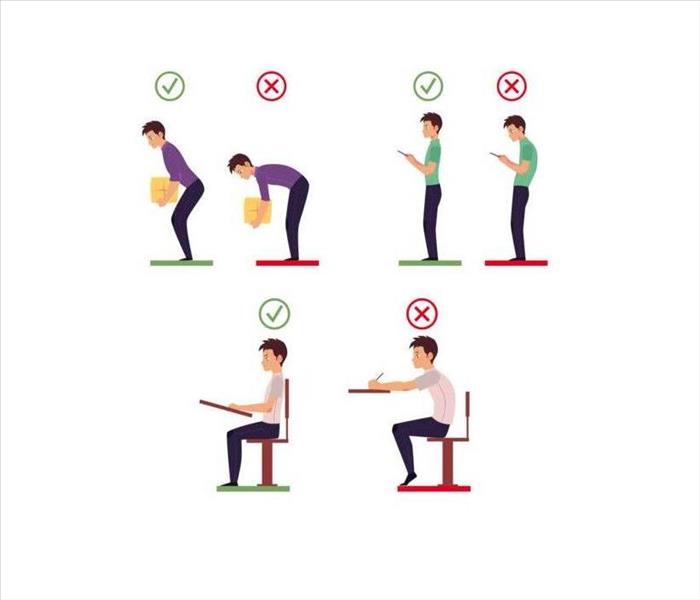 Examples of how to limit your back pain
Examples of how to limit your back pain
According to Federal Bureau of Labor Statistics, more than 1 million workers account for nearly 20 percent of all injuries in the work place. Your back is one of the most important parts of your body, and a back injury creates a number of limitations. It is very easy to strain or otherwise hurt your back. Here are some leading causes, and prevention ideas.
Common causes of back pain at work:
- Force - Exerting too much force can hurt your back, such as lifting, or moving heavy items.
- Repetition - Repeating certain movements, those involving twisting or turning, can injure your spine.
- Inactivity - An inactive job such as a desk job can contribute to back pain as well. If you have poor posture, or sit still all day with inadequate back support, you can encounter back problems.
Back pain prevention:
- Pay attention to posture – When standing, balance your weight evenly on your feet. To promote good posture when sitting, don’t slouch. Pick a chair that supports your back. Adjust the height of your chair so that your feet rest flat on the floor, and your thighs are parallel to the floor. Make sure there is nothing bulky in your back pocket such as a wallet or cell phone, as it can put extra pressure on your buttocks and lower back.
- Lift properly – When lifting heavy objects, lift with your legs, don’t twist, and tighten your core muscles. When carrying heavy objects, hold the object close to your body. If an object is too heavy to lift alone, get a second person to assist.
- Modify repetitive tasks – When lifting heavy objects, use a lifting device if available. If you are in a physically demanding job, try alternating between heavily-physical and less-physical activities. If you have a desk job, make sure your computer, chair, and key board are at the appropriate height. Avoid excessive bending, twisting and reaching. Limit the time you spend carrying heavy briefcases, purses, and bags.
- Listen to your body – If you sit for a prolonged period, its best to change your position often. Taking short walks periodically will stretch your muscles and relieve physical tension.
Back pain can plague your work, and make your free time less enjoyable. If something is aggravating your back, change your position or the task you are performing. Even the smallest preventative efforts can help prevent chronic back pain and spinal injuries.
Time table for water damages
1/3/2020 (Permalink)
 A clock with a second hand
A clock with a second hand
There is never a convenient time for a water damage, especially when it comes to businesses. Water can quickly migrate throughout your building; it can soak into walls, flooring, furniture, and more. When you call SERVPRO of Casper, we will respond to your location right away. We will assess the loss and make sure there is no hidden water in other rooms. From there, we will start extracting any standing water and any water trapped in your carpet. By having a rapid response to your commercial water damage, the total extent of the loss can be reduced, and help save money on your claim. Here is a rough time table of damage caused by water as it dwells in a structure:
Within Minutes:
- Water spreads throughout your property
- Water absorbs into the walls, floors, upholstery, and belongings
- Furniture finishes may bleed, causing permanent staining on carpets
- Paper goods like photographs and books can start to swell and warp
Hours 1-24:
- Metal surfaces begin to rust
- Furniture begins to swell and crack
- Dyes and inks from cloth and paper goods spread and cause staining
- Paint begins to blister
48 Hours – 1 week
- Drywall begins to swell and break down
- Mold may start growing
- Doors, windows, and framing studs swell and warp
- Wood flooring swells and warps
- Microbial contamination is possible
More than 1 week
- Restoration time and costs increases, with more materials needing replaced
- Structural safety, mold growth, and biohazard contaminants pose increased risks to occupants
SERVPRO of Casper is here for you 24 hours a day, 7 days a week, including all holidays. We can rapidly respond to stop further damage, and get your business back to work.
Do's and Don't for drain back up's
1/3/2020 (Permalink)
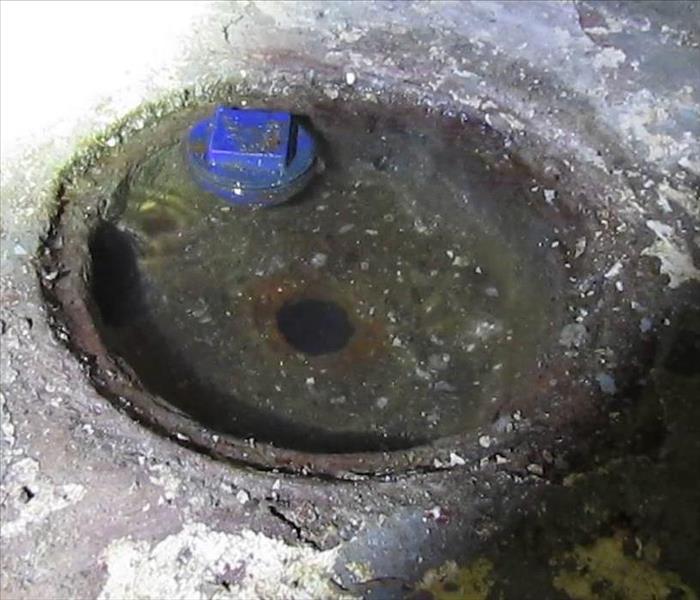 A drain that has had back up water come through
A drain that has had back up water come through
Most homeowners have never worked in the disaster restoration industry. When their home is damaged by contaminated water (such as sewage, drain back-ups, or outside floodwater), it seems that the first step is to grab a shop vacuum and start sucking up the mess. However, there are many more steps and precautions that need to be taken when dealing with contaminated water. Here is a list of Do’s and Don’ts if your home is affected by contaminated water:
Do:
- Avoid all contact with sewage and items contaminated by sewage
- Wash your hands thoroughly after contact with contaminated items
Don’t:
- Spread contaminated water by walking unnecessarily on damaged or wet areas
- Turn on the HVAC system if there is a possibility of spreading contaminated air
- Use household fans to dry the structure and spread contaminants
- Use products for personal hygiene and cleanliness if exposed to the contaminated areas
The best course of action for a contaminated water damage is to have it professionally mitigated. The experts at SERVPRO of Casper can assess the damage to your home, develop a plan of action, and clean up the damage safely and effectively.
Do's and Don'ts of Clean Water Damage
1/3/2020 (Permalink)
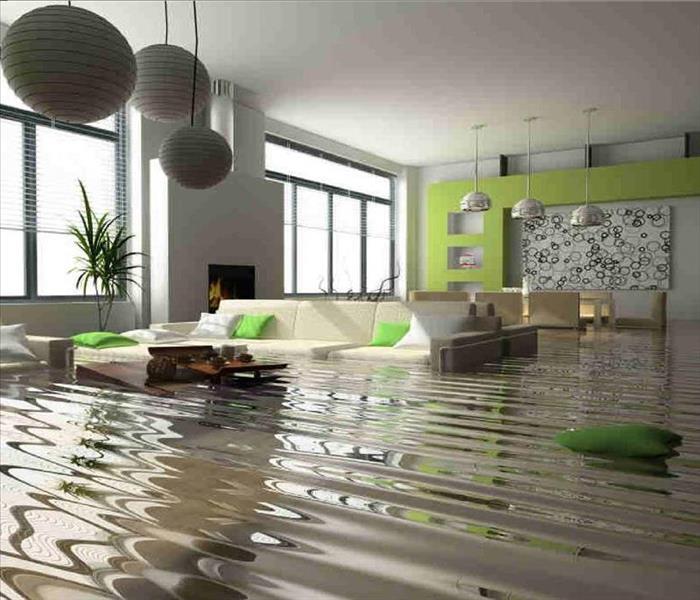 A flooded living room
A flooded living room
When you have a water damage in your home caused by clean water (such as a broken pipe or ice maker line), what should you do first? Grab a mop or a wet vacuum? Start tearing out wet carpet and walls? Some homeowners panic, and get very aggressive in removing wet materials. However, many of these wet materials can be dried out and saved, if handled by a professional mitigation company. Here is a list of Do’s and Don’ts, should you find that you have water damage (from a clean source) in your home:
Do:
- Shut off the source of water if possible, or contact a qualified plumber to stop the water source.
- Turn off circuit breakers from wet areas of the building, if the power distribution panel can safely be accessed.
- Remove as much excess water as possible by mopping and blotting.
- Wipe excess water from wood furniture after removing lamps and tabletop items.
- Remove and prop up wet upholstery cushions to promote even drying.
- Place aluminum foil or wood blocks between furniture legs and wet carpeting.
- Remove to a safe, dry place any paintings, art objects, computers, documents and other materials that are valuable or sensitive to moisture.
- Use wooden clothespins to keep furniture skirting off of damp floors.
- Hang draperies with coated hangers to avoid contact with wet carpeting or floors.
- Hang furs and leather goods to dry separately at room temperature.
Don’t:
- Enter rooms with standing water where electrical shock hazards may exist.
- Enter affected areas if electrical outlets switches, circuit breakers or electrical equipment are exposed to water. Always avoid electrical shock hazards.
- Leave books, newspapers, magazines, or other colored items on wet carpets or floors to cause staining.
- Leave Oriental rugs or other colored rugs on wet wall-to-wall carpets, which can cause staining.
- Use your household vacuum cleaner to remove water, possibly causing electrical shock or damage to the vacuum cleaner.
- Use TVs or other appliances while standing on wet carpets or floors, especially not on wet concrete floors.
- Turn on ceiling fixtures if ceiling is wet or enter rooms where ceilings are sagging from retained water.
Contact the professional, certified technicians at SERVPRO of Casper for rapid response to your water damage issues, day or night.
Bio-hazard Clean Up
1/3/2020 (Permalink)
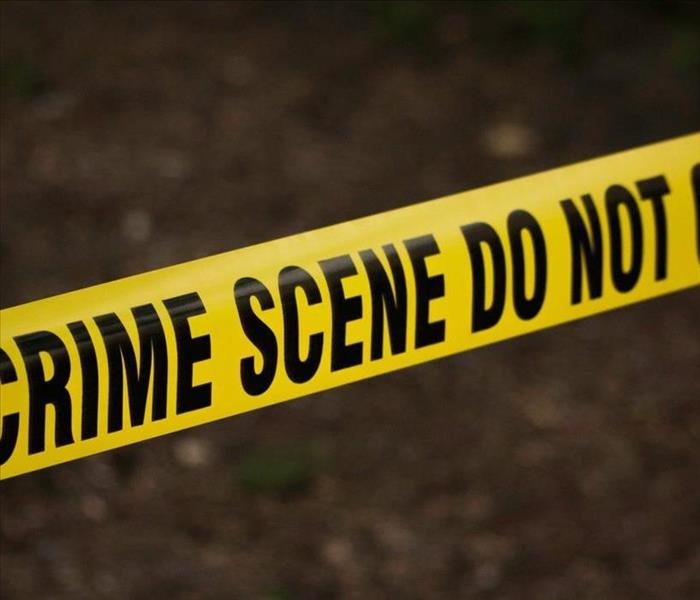 Crime Scene Tape
Crime Scene Tape
SERVPRO of Casper is trained and equipped to respond to any type of biohazard situation. We can clean up crime scenes, hoarding, animal and human waste, and unattended death. This is not the most pleasant part of our job, but it is critical that it is handled properly. Here are a few types of biohazards, with an explanation of what they entail.
Unattended Death:
When a loved one passes away, and discovered after the fact, some cleanup is often necessary. We are aware that this situation can be very stressful for friends and family of the deceased. The technicians at SERVPRO of Casper respond to these jobs with compassion, and perform the necessary services quickly and safely. It is our goal to provide our cleanup services in a caring manner, and to try to alleviate some of the stress, allowing you and your family to move forward.
Hoarding:
Hoarding can often develop into a biohazard situation. Excessive household garbage and spoiled food are common in a hoarder house. This can attract insects and rodents, and dangerous bacteria can be present throughout the home.
Other Types of Biohazards:
Sewage backups, certain medical emergencies, and crime scenes are examples of other biohazards that require special attention. Bacteria, viruses, and other pathogens may be present. Special cleanup procedures and products are critical to ensure the health and safety of the occupants of the property.
If you have a biohazard problem that requires immediate attention, call SERVPRO of Casper anytime. We can respond rapidly, while handling the situation with dignity and respect.
Smoke Alarm Install
12/27/2019 (Permalink)
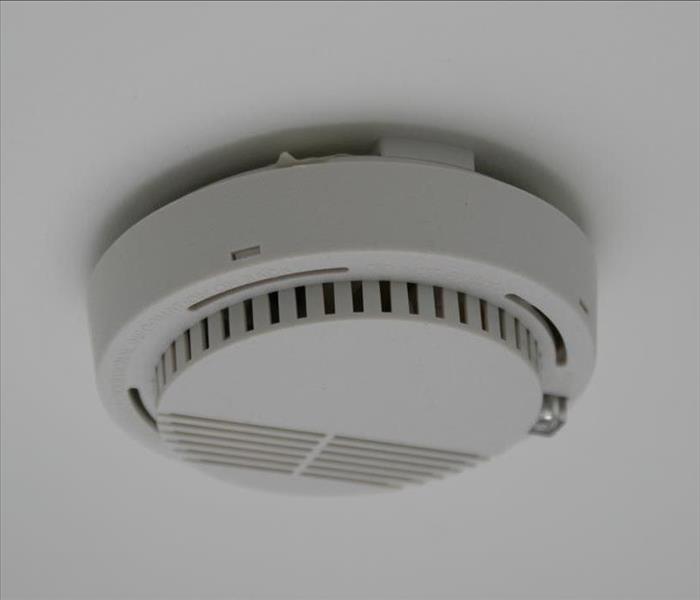 Smoke Alarm attached to a ceiling
Smoke Alarm attached to a ceiling
There is often a lot of confusion about the proper placement of smoke alarms in a home. Sometimes, homeowners will put an inadequate number of alarms in their property. Putting a single smoke alarm in the kitchen, or just one in a hallway, is not enough to protect yourself adequately.
Modern homes have far more plastic items and synthetic fabrics than they did just a few decades ago. Some of these plastics can burn much faster than natural materials. This means that a fire in a modern home can spread very rapidly. Properly-utilized smoke alarms can give your family the advance notice they need to safely escape a house fire. Here are a few tips on the proper placement of your smoke alarms.
- Don’t buy knock-off brands. Make sure you get alarms that have a label from a recognized testing laboratory.
- Place a smoke alarm in each bedroom, and outside the door of every sleeping room on all floors including the basement.
- When placing one in the basement, place it on the ceiling on the bottom of the stairs going up to the next floor.
- Don’t place smoke alarms closer than 10 feet from cooking appliances. Any closer could set off false alarms when cooking.
- Mount alarms high on walls or on the ceiling. If mounted on the wall, make sure it is 12 inches away from the ceiling.
- Don’t install a smoke alarm near a door, vent, or window. Drafts may interfere, and cause the alarm to not work properly.
- Keep smoke alarms free from debris, wall hangings, stickers, or paint.
Smoke Alarm Maintenance
12/27/2019 (Permalink)
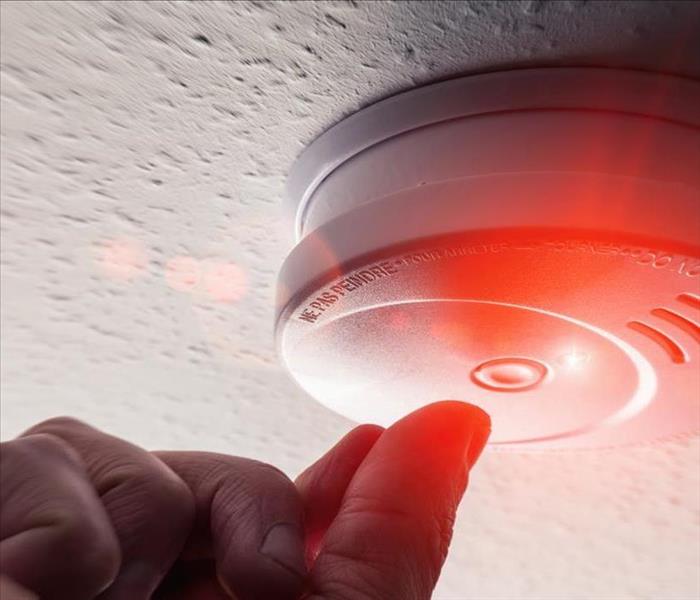 Someone is testing their smoke alarm.
Someone is testing their smoke alarm.
Smoke alarms are a fairly low-maintenance household device. However, in order to ensure they are in good working order, there are a few steps that you should perform.
- Make sure you read the manufacturer’s instructions to learn about any special maintenance required for your specific alarm model.
- It is recommended that you test the smoke alarm at least once a month. Normally, this is done by pressing the test button on the center of the device.
- Make sure everyone is familiar with the sound of the alarms, and knows what to do if they hear the alarm.
- The batteries in the smoke alarms should typically be replaced twice a year. A good habit is to change the batteries at the beginning and the end of Daylight Savings Time. If one of your alarms starts to occasionally “chirp”, it means the battery is low and you need to replace it immediately.
Always follow the manufacturer’s recommendations for your smoke alarms, and never become complacent in their upkeep. With a little periodic maintenance, smoke alarms can save lives.
Space Heater Safety
12/26/2019 (Permalink)
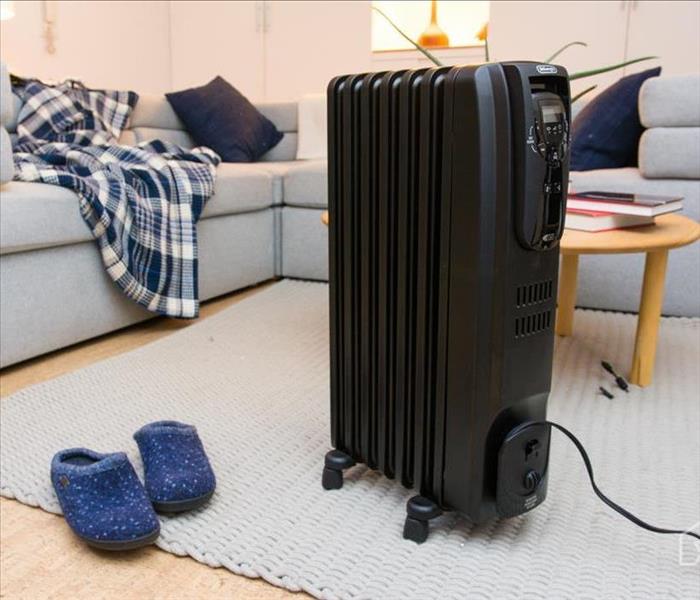 A Space heater sitting in the middle of the living room. There is a couch, slippers, and a coffee table sitting behind it. .
A Space heater sitting in the middle of the living room. There is a couch, slippers, and a coffee table sitting behind it. .
When outdoor temperatures drop, some people use space heaters to add a little extra heat in their home or room. There are more than 65,000 fires that are caused by heating equipment annually. With those fires, thousands of injuries, hundreds of deaths, and millions of dollars in property damage occur. These fires are often started by heaters placed too close to combustible materials, being improperly plugged in, or simply being improperly utilized.
Safety should be everyone’s top concern when it comes to space heaters. Here are some safety tips to keep you and your family safe.
- Turn it off when you’re leaving the room or going to sleep.
- Don’t let pets or children play close to the heater.
- Make sure your space heater has a recognized laboratory testing sticker on it.
- Take the time to read the instructions and warning labels.
- A space heater is only a supplemental heater, not a source to heat your bedding, cook food, dry clothes, or thaw pipes.
- Must keep the heater at least 3 feet away from anything that can catch on fire.
- Place the heater flat on the ground. Never place them on cabinets, furniture, carpet, or any surface that can catch on fire.
- Always plug the heater straight into the outlet, never into an extension cord or power strip.
- When you are done using the heater, unplug it and put away in a safe location after it has fully cooled.
We here at SERVPRO of Casper hope you have a warm and safe winter!
After holiday cleaning tips
12/26/2019 (Permalink)
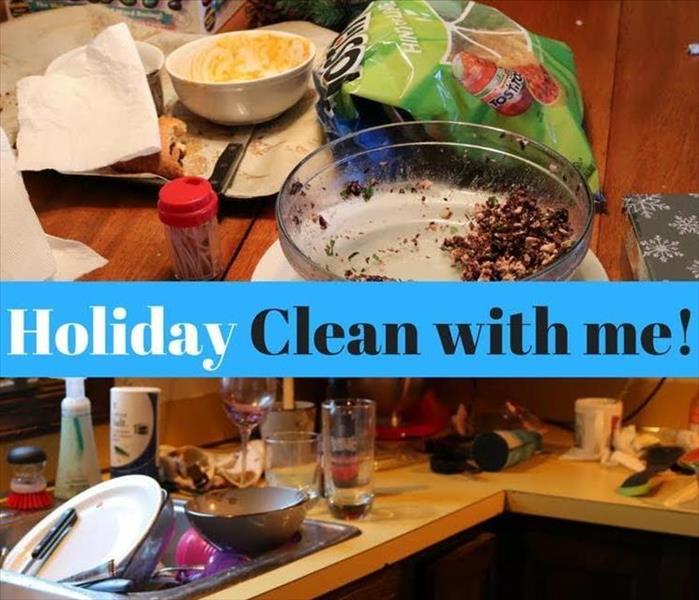 Sink full of after holiday dishes
Sink full of after holiday dishes
Cleaning Up After the Holidays
Cleaning up after the holidays can be a lot of work, but it’s necessary work. You want to start your new year with a fresh clean house, and not a house full of messes caused by the holidays. Here are some suggested things to do to help clean up.
Clean Up After Guests:
- Give all the surfaces in your home a nice deep clean
- Wash all the linens
- Vacuum all your carpet (you could even call SERVPRO of Casper to clean your carpets!)
- Mop your floors
- Clean out your refrigerator. Once you’re done with the last of your leftovers, then clean and store your leftover containers.
If you have a natural Christmas tree, here are some tips on how to get tree sap spots out of of your home:
- If you get sap on your clothes, knit gloves or rugs, put some rubbing alcohol on the area and run it through the laundry with warm water. Repeat again if it all doesn’t come out.
Clean and Store Decorations:
- Make sure you have enough tote boxes, and appropriate boxes for all of your decorations.
- Throw out any broken lights or decorations. No sense of keeping broken stuff, it will help declutter things. (Unless the item is sentimental, of course.)
- If you have decorations for certain rooms in your home, make sure you label your boxes for what room they belong in. This will make decoration setup go much more smoothly next year.
Frozen Pipes
12/26/2019 (Permalink)
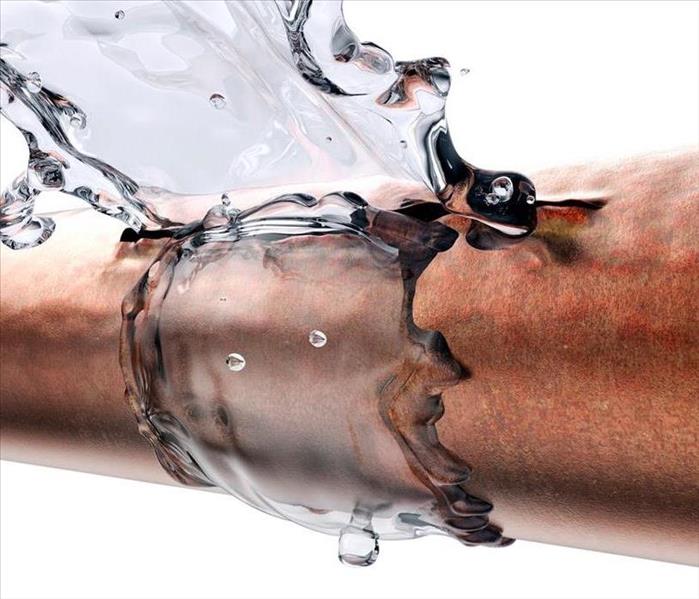 A pipe with a split in it with water spraying out.
A pipe with a split in it with water spraying out.
Why Do Pipes Break in Freezing Temperatures?
When water in the pipes start to freeze it expands, and ice crystals can form inside causing water blockage. This causes an increase in pressure inside the pipe. If the pressure is too high for the pipe to contain, it will rupture.
Plastic (PEX) pipes are more resistant to freezing than copper. Copper lines are typically ½ inch to ¾ inch in diameter, which makes it quicker to freeze. If you have a boiler system and it fails, you still run the risk of freezing boiler pipes whether they are cast iron or not.
When you turn on your main water supply, the whole system is pressurized. If you turn on your outside faucet and you discover very low pressure or find water leaking into your home, turn off the faucet immediately. You may have a frost-free faucet that has ruptured. Turning off the faucet will stop the flow of water through the rupture point. Have a plumber inspect your faucet in this situation, to determine if your faucet requires replacement.
If you encounter a frozen pipe (that has not broken) in your home, take the following measures to safely thaw it:
- Turn off your water supply to the frozen pipe off. The pipe could still burst.
- Make sure your thermostat is up to 75 degrees.
- Open the faucet.
- Circulate warm air throughout the house. Use fans to move warm air to cold areas.
- Place a heater near the frozen area.
Make sure you check on it regularly not only to ensure the pipe is not broken, but to keep an eye on the space heater.
If you run into frozen pipes, or water damage from frozen pipes, Call SERVPRO of Casper at 307-235-6558. We can assess the water damage in your home, and develop a plan to dry your property quickly.
Flu Season
12/9/2019 (Permalink)
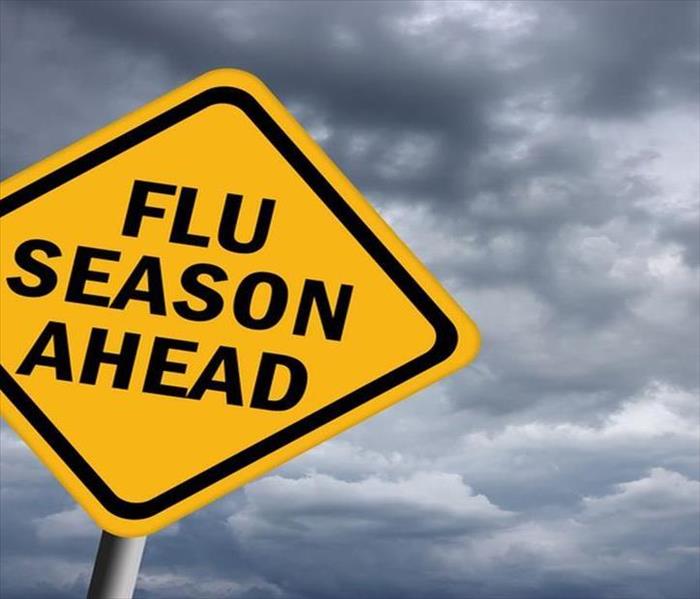 Flu Season Ahead
Flu Season Ahead
As we go about our day-to-day working routines, we come into contact with a lot of other people. During the cold and flu season, germs can spread rapidly from person to person. Preventative precautions during this season can help protect yourself and your loved ones from getting sick.
Ways to protect yourself during the flu season:
- Get vaccinated.
- Stay home if you are sick.
- Wash your hands often. Use soap and warm water for at least 20 seconds.
- Avoid touching your nose, mouth, and eyes.
- Cover your coughs and sneezes with a tissue, or cough and sneeze in your upper sleeve. Wash your hands after coughing, sneezing, or blowing your nose.
- Keep frequently touched common surfaces clean, such as telephones and computer equipment.
- Try not to use a coworker’s phone, desk, office computer, or other work tools and equipment.
- Avoid shaking hands or coming in close contact with coworkers and others who may be sick.
- Stay in shape, and get plenty of rest.
- Speak with your doctor and find out if you’re in a high risk category for seasonal flu.
- Participate in any wellness training offered by your employer.
Nobody likes getting sick, so do what you can to protect yourself and others.
Fire Extinguisher Safety
11/19/2019 (Permalink)
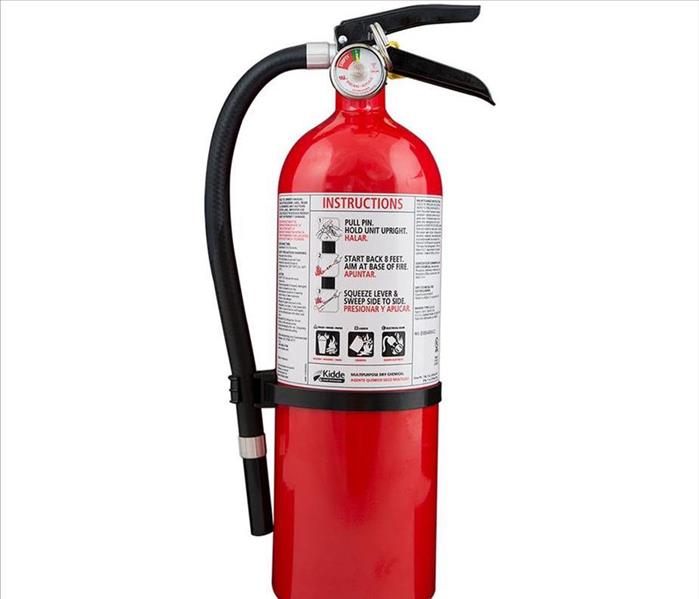 A red fire extinguisher
A red fire extinguisher
Having fire extinguishers in your home or commercial building is an important safety measure. But it is equally important to select the right type of fire extinguisher, and to know how to utilize it effectively.
To operate one, just remember the word PASS.
Pull the pin. Hold the extinguisher with the nozzle pointing away from you, and release the locking mechanism.
Aim low. Point the extinguisher at the base of the fire.
Squeeze the lever slowly and evenly
Sweep the nozzle from side-to-side
- When selecting a fire extinguisher for the home, it is best to pick a multi-purpose extinguisher (Class ABC). The multi-purpose extinguisher is good for all kinds of house fires.
- Make sure there’s a label on it from an independent testing laboratory.
- Familiarize yourself with the fire extinguisher by reading the instructions that come with it. Hands-on training is also available for the proper use of extinguishers. Fire equipment distributors often provide this training. And you can always check with your local fire department to see if they can help with training.
- Know when it’s time to go. A fire extinguisher is only designed to extinguish small areas like the wastebasket. Your primary concern is getting everyone out safe.
- Make sure you have an emergency plan in place. Also make sure everyone knows the exits, and where the meet-up location will be.
A fire can happen at any time, in both residential and commercial settings. Having a fire extinguisher available, and knowing how to effectively use it, can save both property and lives.
Commercial Winter Safety
11/15/2019 (Permalink)
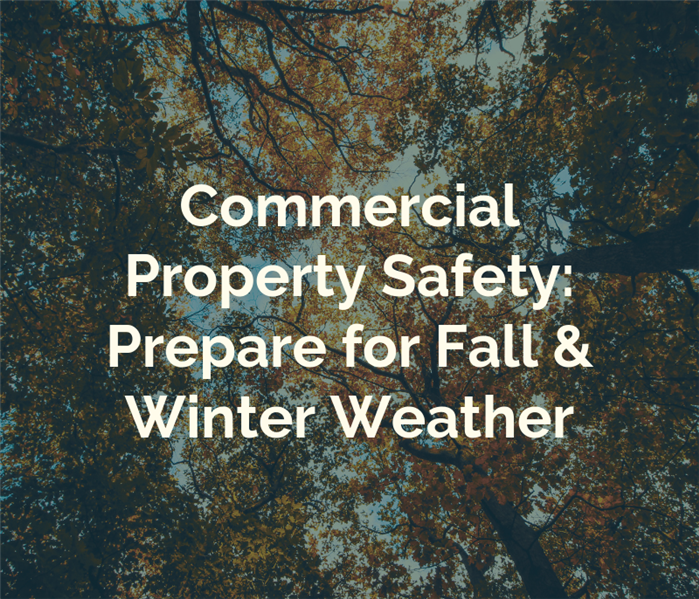 A sunny day with fall color trees
A sunny day with fall color trees
Winter weather in Wyoming can be unpredictable, so it’s very important to make sure you are prepared for any type of weather condition. In the winter we fight with snow accumulation, blowing snow, and severe temperatures. If you own a commercial property, you want to make sure you have a good winter contingency plan. This becomes especially important if you have employees. Preparedness makes things less difficult for you and your staff.
Stock Up
If you have an occupied structure, you should have emergency kits in place, in case anyone gets stranded. Here are a few suggested items to have in your kits:
- Food and water
- Supplies for basic first aid
- Flashlight with extra batteries
- A whistle
Condition of Your Building
Make sure that your building is well-maintained so there are no structure damage or potential leak points. It is important to keep up with routine housekeeping tasks, such as clearing of the traffic lanes, and no sharp edges or protrusions that could cause an injury. In case of power failure, it is good to ensure that there are extra blankets stored away, and a light source nearby such as a flashlight.
Think About Your Employees
If you know that severe temperatures and snow are coming, it would be good to evaluate the situation and decide if it’s appropriate for employees to come to work. You don’t want your employees taking unnecessary risks on bad roads, or getting snowed in at your facility.
With some preparatory measures, your commercial building can be ready for whatever happens. If your building sustains any damages caused by winter conditions, know that SERVPRO of Casper is always here for you.
Commercial Sprinkler Protection
11/15/2019 (Permalink)
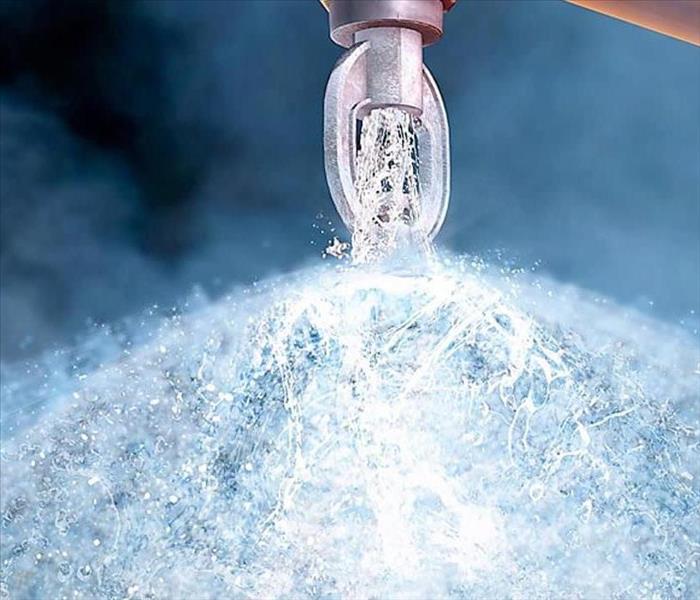 Water coming out of the suppression system.
Water coming out of the suppression system.
Winter is here, and so are the freezing temperatures. Frigid conditions can freeze and damage internal plumbing systems. This can also affect larger commercial systems, such as fire suppression system pipes. Depending on pressure, a fire suppression sprinkler head can release up to almost 4 gallons per minute. Broken sprinkler pipes can deliver even more, causing substantial water damage in a commercial building in a short amount of time.
Having fire suppression systems inspected on regular basis is an important way to prevent such damage. The NFPA (National Fire Protection Association) recommends that these systems are inspected 4 times a year. A qualified inspector will check the main components of the system such as the sprinkler heads, valves, and piping to ensure everything is in good working order.
Making a plan in case of an emergency is very important. SERVPRO of Casper will build an Emergency Ready Profile (ERP) for your commercial property at no cost to you. If your building sustains water damage from your suppression system (or any other cause), you will have a guide to utility shut-offs for your building, and key emergency contacts, ready at hand. Call SERVPRO of Casper today to arrange for a free Profile.
Water Damage Carpet
10/31/2019 (Permalink)
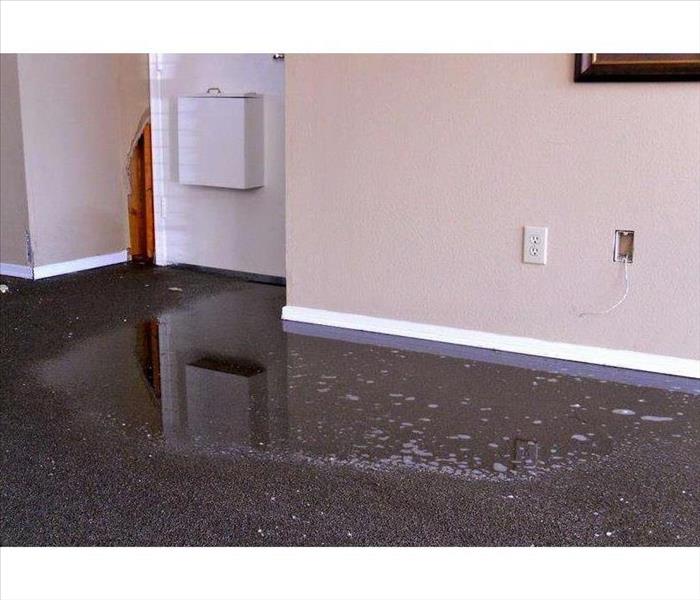 Water Damage carpet
Water Damage carpet
During a water damage, a multitude of materials can be affected. One of the most common materials that gets affected is carpet.
The good news is that often, water-damaged carpeting can be saved. Through various methods, it is possible to rapidly dry the carpet, saving the substantial cost of replacement.
In most circumstances, the carpet is released from the tackless strip around the perimeter, and carpet pad is removed and disposed of. Then, extraction is performed to remove the excess water from the carpet. After that, we place air movers to blow warm, dry air between the carpet and subfloor. This “float” method dries both the carpet and padding at the same time. Once everything is dry, new carpet pad is installed, the carpet is stretched back into place, and the carpets are cleaned.
Sometimes, it is more beneficial to save both the carpet and pad. In this situation, “in-place” drying is performed. A weighted extractor is used to compress the carpet and pad, and remove the water from it. After that, air movers are used to blow warm, dry air across the top surface of the carpet. This method takes longer to dry, as multiple layers of material are being dried at the same time. However, this saves the additional time and labor of carpet pad and carpet reinstallation.
To have the highest chance of saving carpeting and other materials, it is important to start the drying process as soon as possible. Our technicians are available 24 hours a day to handle your water damage problems quickly. Call the professionals at SERVPRO of Casper anytime, at 307-235-6558.
Safety tips on Holiday Cooking
10/23/2019 (Permalink)
 A table with a roasted turkey surrounded by all the holiday fixings.
A table with a roasted turkey surrounded by all the holiday fixings.
The time for holiday cooking and baking is here! There will be cookies, candies, turkeys, hams, and all the sides a person could imagine. Family and friends will gather, reminiscing about the year’s accomplishments and events. But all of these things lead to distractions, which can cause some potentially dangerous situations. House fires, smoke damages, and injuries increase during the holidays. Here are some safety tips on how to make sure you have a fun and safe holiday season.
- Don’t wear loose clothing or sleeves while cooking.
- If you’re frying, broiling, or grilling, never leave it unattended.
- If you’re baking, simmering, roasting, or boiling food, you’ll need to check on it regularly.
- Set a timer so you don’t forget that item you left in the oven.
- Make sure that kids and pets stay clear of the cooking area.
- Keep anything that can catch on fire clear of heat sources. Examples of this are pot holders, oven mitts, wooden utensils, paper or plastic bags, food packages, towels, and curtains.
- Clean surfaces on a regular basis so grease doesn’t have an opportunity to build up. Heavy buildup of grease and oils can become flammable.
- Make sure you check the stove, oven, roasters, or any other cooking items to make sure they are shut off before going to bed or leaving the house.
- It’s good to purchase a fire extinguisher to keep in your kitchen.
Our team at SERVPRO of Casper hopes you have a safe and fun holiday season!!!!
Tips on how to keep your pipes from freezing
10/17/2019 (Permalink)
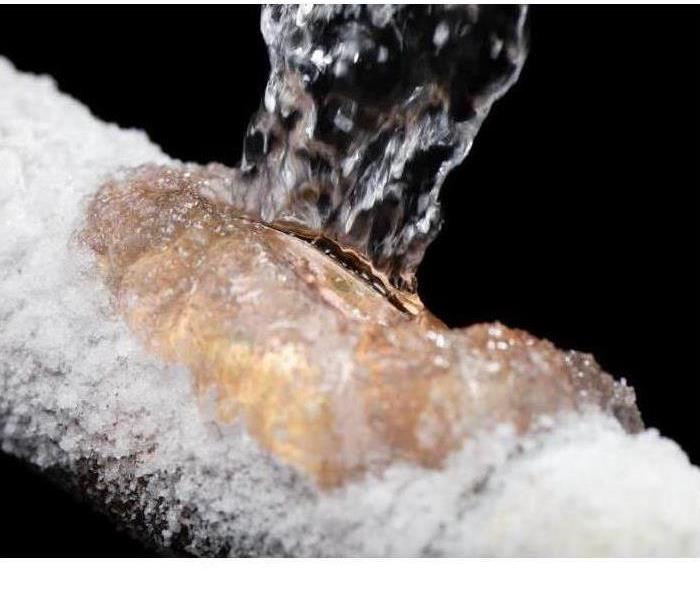 A pipe break that is leaking water.
A pipe break that is leaking water.
With winter right around the corner, there is always a risk of frozen pipes. With some seasonal preparation, you can significantly reduce your risk of plumbing breaks, and the water damage it can cause. Here are a few tips on how to do that.
- Keep garage doors closed if there are water supply lines in the garage.
- In extreme cold conditions, open kitchen and bathroom cabinets to expose the pipes to warmer air. Make sure any harmful cleaners or household chemicals are out of reach for pets and children.
- During freezing temperatures, allow a small amount of water to drizzle from the faucet. This continuous movement of water through the pipes helps keep them from freezing.
- Keep the thermostat at the same temperature at night and during the day. During freezing temperatures, you want to keep the temperature at least 70 degrees.
- If you’re going to be gone during the cold weather, you’ll want to leave the thermostat to at least 55 degrees.
If you happen to experience a water damage because of a frozen pipe this winter season, know that SERVPRO of Casper is here to help.
Commercial Carpet Cleaning
6/12/2019 (Permalink)
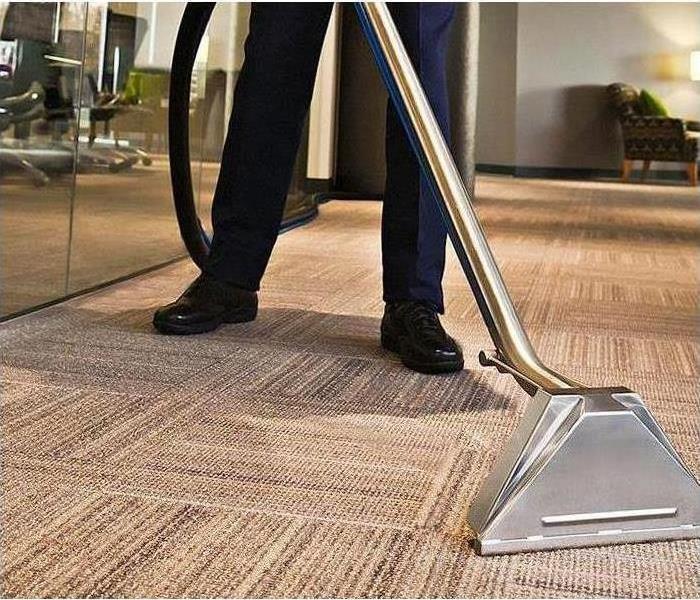 Commercial Carpet Cleaning
Commercial Carpet Cleaning
Most people are very conscientious about maintaining the carpeting in their homes. But when was the last time you looked at the carpet in your business? Clean carpets in an office brighten up the general appearance of every room. It also makes the business more appealing to customers. In addition to cleaning, routine maintenance is key in extending the life of wall-to-wall carpeting.
Carpet manufacturers agree that the measures you take between regular carpet cleanings can expand the life of your carpet. Your carpet collects settled debris from the air, and residues tracked in from outside shoes. It collects dust, dirt, gases, animal and human hair, and many other soils.
The good news is that about 80% of the soils in the carpet are dry soil. These are materials that can easily be removed by vacuuming. By doing some of these preventive maintenance actions, you can help the life of your carpet.
- Regular vacuuming (By vacuuming you can pull up 80% of soils in the carpet). Twice per week is ideal.
- Spot Removal, as needed
- Pilating the carpet to prevent matting
- Moving furniture to change traffic patterns
- Using walk-off mats to limit the amount of outdoor soil tracked onto the carpet
If you would like a free estimate for your commercial carpet cleaning, call SERVPRO of Casper today at 307-235-6558.
Wild Fire Preparation
6/12/2019 (Permalink)
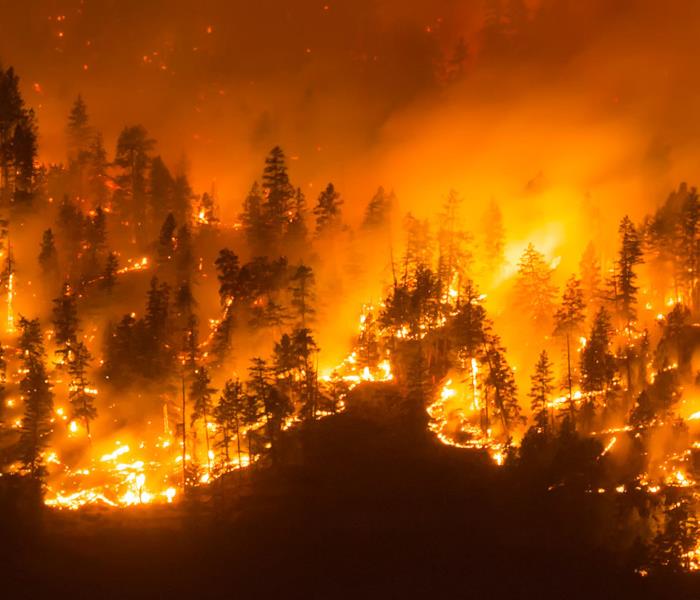 Wild Fire
Wild Fire
Towards the end of the summer, Wyoming always run a risk of wildfires. It could be caused by human error, or mother nature. A wildfire is potentially just as dangerous as flooding, and should be taken seriously.
If you’re under a wildfire warning, get to safety right away.
- Leave if told to do so
- If trapped, call 911
- Listen for emergency information and alerts
- Keep NIOSH N95 masks on hand to use to help keep particles out of the air you breathe
If you’re in a high risk area, you should prepare now.
- Sign up for your community warning system
- Have a plan for pets and livestock
- Find different shelter locations
- Gather emergency supplies, including a NIOSH N95 mask. Make sure you have a list of medications and a treatment plan, and don’t forget your pets.
- Close all doors and windows, and set up a portable air filtration machine to keep the pollution levels down in your home.
- Keep important documents in a fireproof container, and stored in a safe place, and make sure you have password-protected digital copies.
- Make sure you know where the outdoor water source is, and hook up a hose that can reach any area of your property.
- Make sure you create a fire-resistant zone free of debris such as leaves, tree branches, or flammable materials for at least 30 feet from any structure.
- Review your insurance coverage, make sure it’s all up to date and you have enough to replace your property if need be.
Survive during a wildfire
- Evacuate immediately if the authorities tell you to.
- If trapped, call 911 and give them your location, and turn on lights to help rescuers can find you
- Use NIOSH N95 masks to protect your respiratory system.
- If you are not forced to evacuate, and the condition keeps getting smokier, stay inside where it’s safer.
The after care
- Check with authorities before going back to your property, and to make sure your water is safe to drink.
- Be cautious walking around and moving things that have been burnt. There could be heat pockets, and you could get burned or start another fire. Also be considerate about your animals walking on anything that has been burned by the fire.
- Make sure you reach out to your family through text or social media. Phone lines may be over loaded because of the disaster.
- Document property damage and take photos. Make a list of anything that was destroyed and call your insurance company.
Safety Driving in a Hail Storm
5/24/2019 (Permalink)
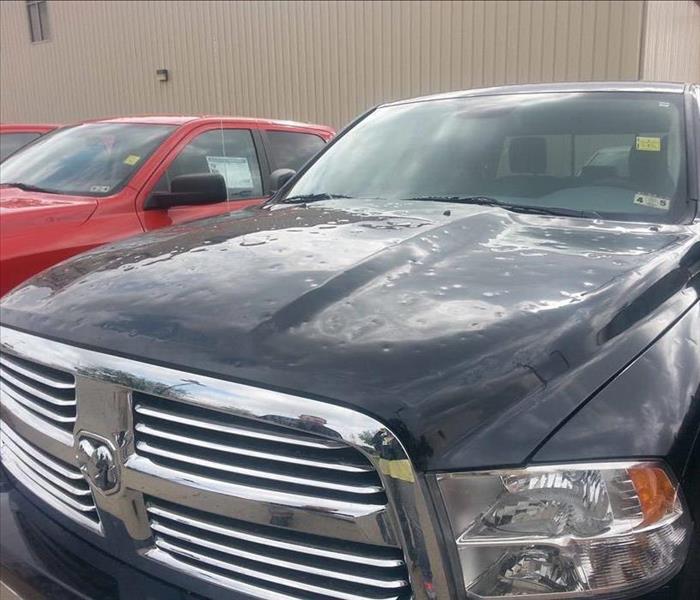 Vehicle damage from a hail storm.
Vehicle damage from a hail storm.
During spring time, rain storms and thunderstorms are a common occurrence. While some of these result in light to moderate rainfall, some may produce hail. Hail storms can cause injuries, and they can be damaging to your property. If you encounter a hail storm, here are some safety tips.
- Hail falls down fast, and can cause injury. If you are in your car when hail begins, it’s best to stay inside your vehicle until the storm passes.
- The speed of your vehicle can amplify the impact of falling hail, and could cause your windshield or any other windows to break. Safely pull your car off the road when hail begins to fall. If possible, parking under a nearby overpass can protect your vehicle from further damage.
- Park your car on an uphill slope, if one is available. Your windshield is designed to stand hard impacts, where the rest of the windows are not.
- When in your car, it is best to be lying down with your back up. Cover yourself with any available blankets or coats to protect yourself from debris in case any windows break.
During any storm it’s important to make sure your radio is on to hear any storm warnings and updates.
Document Restoration
5/23/2019 (Permalink)
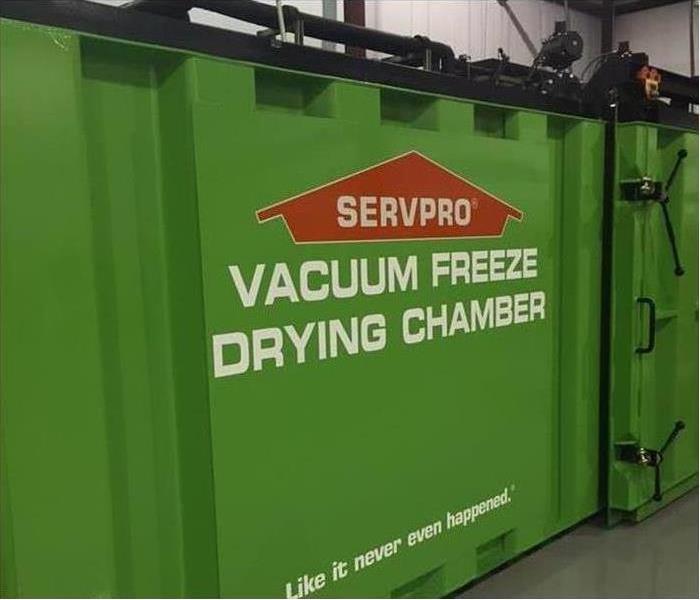 Document Restoration
Document Restoration
When a commercial water damage occurs, documents and files may get wet. Depending on the type of business and the nature of the documents, these may be critical to your clients, and the operation of your business. SERVPRO of Casper offers document drying services in these situations. Your documents are packaged, frozen, and shipped to our document drying center. Once they arrive at the center, they are freeze-dried to remove all water from them. While documents typically cannot be fully restored, the freeze-drying method prevents further damage, and typically brings the documents to a usable condition. Here are few common questions about document drying:
Is Document Restoration HIPAA Certified?
Yes, all members of the Document Restoration team are HIPAA Master Certified. The facility is monitored with a 24/7 surveillance. For highly-sensitive documents, dedicated courier service can be utilized.
Should you create your own inventory?
SERVPRO will perform an inventory, but it’s always a good idea for you to do your own inventory as well.
Do we pack-out documents on the loss site?
We typically do not pack-out documents, but if you need assistance with pack-out, please let us know. We are always happy to help.
Are we able to restore more than just paper documents?
We can restore photos, photo albums, yearbooks, and more.
How long does the process take?
The average time frame of completion is around 3-60 days. The time completion will depend on the quantity of the job, services being completed, and how much damage is sustained.
If you end up with water-damaged paperwork and need our assistance, call SERVPRO of Casper at 307-235-6558.
Is your area flooding?
5/23/2019 (Permalink)
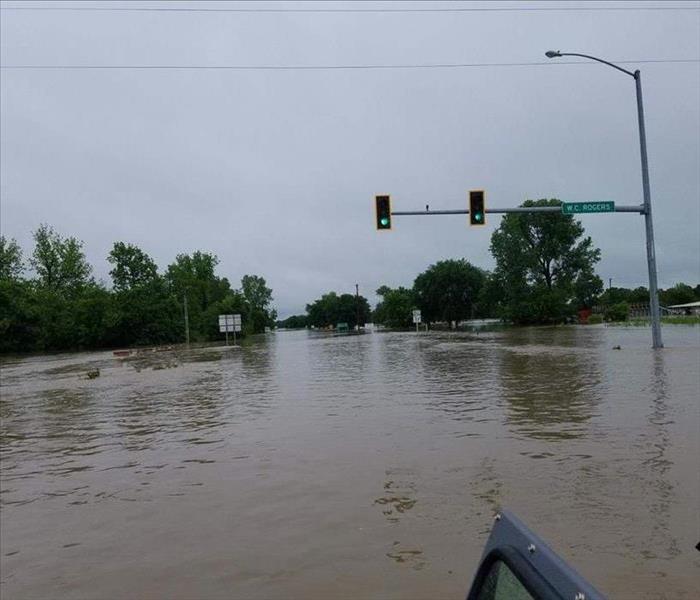 Flooded streets
Flooded streets
Floods are unpredictable, and they can happen in virtually any location you may live in. Just because you haven’t had a flood in the past doesn’t mean it will never happen in your area. It’s very important to be prepared in case the unexpected happens.
Things you need to know:
- Know the flood risk in your neighborhood. Do you live in a flood plain?
- How to prepare your home or property
- How to respond when floodwater comes
- How to recover after a flood
Ways to prepare:
- If your area is flood prone, it is best to have hard-surface flooring instead of carpet in your home
- Prepare an emergency kit
- Prepare a household flood plan
- Keep a list of emergency telephone numbers on display
- Check your insurance policy to make sure your property is covered for flood damage
If flooding is forecast to happen, take time to prepare:
- Place important documents, valuables and vital medical supplies in a waterproof case
- If you go to a different location, make sure your pets are with you. If you cannot take them, make sure you move them to a higher location with plenty of food and water
- Move any electrical appliances, furniture and area rugs to a higher location
Relocating to safer ground:
- Monitor the radio for warnings and advice
- Pack your essential needs: warm clothes, critical medications, valuables, personal papers, and an emergency kit
- Empty fridge and freezers and leave the doors open
- Turn off your gas and water
- Make sure you have your mobile phone with you
- When you leave, make sure you lock your doors
- Do not drive into water of unknown depth
Fire pit safety
5/23/2019 (Permalink)
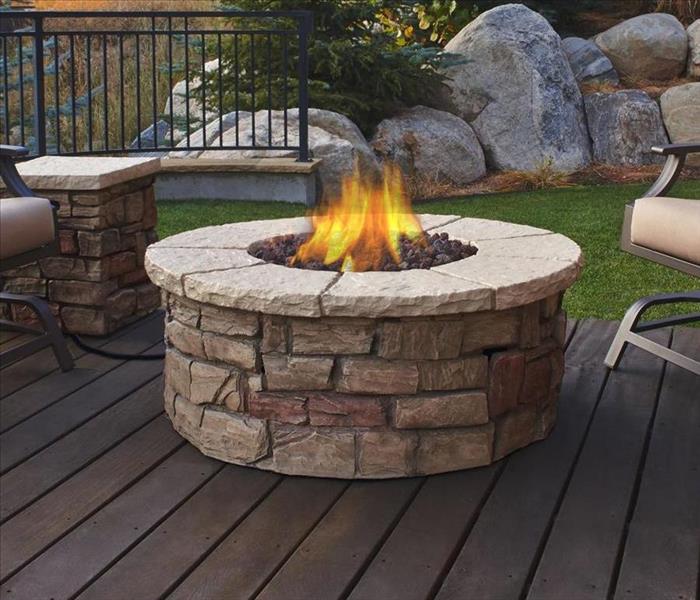 Don't have your summer ruined by your fire pit.
Don't have your summer ruined by your fire pit.
When summer arrives, you may get excited about the idea of relaxing by the fire pit in your backyard, enjoying the warm glow of a fire. But there can be safety concerns if it is not placed in the right area, or if the fire pit is not built properly. Here is a list of Do’s and Don’ts to make sure that you have a fun summer with your fire pit.
Do: Make sure your surface is level before building your fire pit. It reduces the risk of a log rolling out of the pit.
Do: Build your fire pit at least 10 feet from your home, fences, trees, and bushes. Building it closer increases the risk of fire damage.
Do: Make sure your guests keep a proper distance from your fire pit. Keep a close eye on children and pets.
Do: Check the weather forecast before building a fire, to ensure that it will not be excessively windy. You don’t want wind-driven embers or flames spreading to your trees, bushes, or home.
Do: Once you’ve extinguished your fire, gently stir the ashes to until they are cooled down.
Don’t: Don’t start your fire using gasoline or lighter fluid, if avoidable. A fire started with liquid accelerants can easily get out of control. When possible, use dry kindling instead.
Don’t: Don’t use river stones in the construction of your fire pit. Smooth stones from the river may have absorbed moisture over time, and when they are heated quickly, they can explode. It is best to use dry, rough stones.
Don’t: Don’t leave a fire unattended. Having someone present with the fire at all times ensures that if the fire starts to spread outside the pit, it can quickly be extinguished.
Leaky Roof
5/2/2019 (Permalink)
 Leaky Roof
Leaky Roof
With the coming of Spring, the first property concern that comes to mind is typically Spring cleaning. But this is also an important time to perform seasonal inspections on your property. Checking sprinkler systems and frost-free faucets for ruptures can prevent a lot of property damage. This is also a great time to inspect the condition of your roof. You don’t want to find out later through musty odors and staining on your ceilings that you were missing shingles on your roof, or that you had some other roofing damage.
The best time to detect leaks in your roof is during spring rainfall. If a wet spot appears on your drywall, mark the area immediately, and place a bucket to catch any drips. You will need two companies to address the damage: A roofing contractor to address the leak in the roof, and a restoration company (such as SERVPRO) to dry out any wet areas in the home.
If you don’t want to wait for a rainstorm to diagnose leaks, you can spray a garden hose over any areas that you think could be weak. Have a helper observe inside the attic while you do this, to quickly identify any drips or wet surfaces from the testing.
If you have any concerns of having wet materials from a leaky roof, give SERVPRO of Casper a call. We can perform a free assessment, and perform structural drying as needed.
Tornado Safety
4/23/2019 (Permalink)
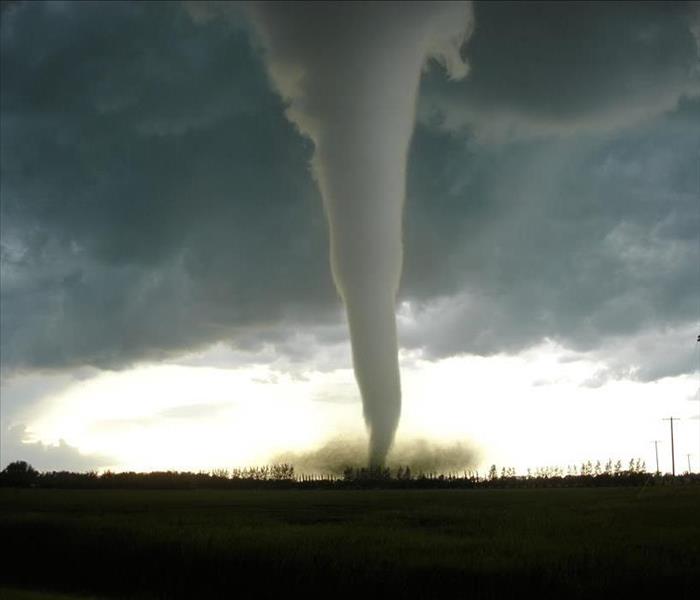 Always be prepared for any kind of storm event.
Always be prepared for any kind of storm event.
Wyoming may not have tornadoes as frequently as areas in the Midwest and the South, but they do still occur. Our wide-open prairies and sparse population result in most tornadoes touching down in unpopulated areas. But there is still a risk of homes and businesses being affected. Because of this possibility, it’s important to know how to handle a potentially dangerous tornado event.
Tip 1: Be prepared
The best way to stay safe during a tornado is to be prepared with:
- Fresh batteries and a battery-operated TV, radio, or internet-enabled device to listen to the latest emergency weather information
- A tornado emergency plan including access to a “safe shelter” for yourself and for people with special needs
- An emergency kit including water, non-perishable food, and medication, and a list of important information, including telephone numbers.
Be sure your children know what a tornado is, and what watches and warnings are.
Tip 2: Stay aware of weather conditions
Pay close attention to changing weather conditions in your area. If you know thunderstorms are expected, stay tuned to local radio and TV stations or a NOAA weather radio for further weather information. Some tornadoes strike rapidly without time for a tornado warning. The following weather signs may mean that a tornado is approaching:
- A dark or green-colored sky
- A large, dark, low-lying cloud
- Large hail or a loud roar that sounds like a freight train
Tip 3: Know where to shelter
Falling and flying debris cause most deaths and injuries during a tornado. Although there is no completely safe place during a tornado, some locations are much safer than others.
- Go to the basement or an inside room without windows on the lowest floor (bathroom, closet, center hallway)
- Avoid windows
- For added protection get under something sturdy (a heavy table or workbench). Cover your body with a blanket, sleeping bag or mattress. Protect your head with anything available.
- Do not stay in a mobile home
Dryer duct cleaning tips
4/17/2019 (Permalink)
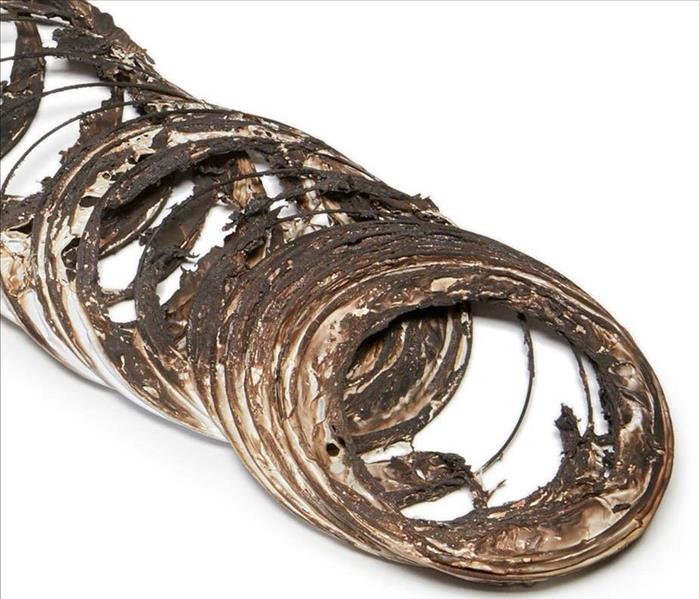 Melted dryer duct from a fire caused by back up dryer lint
Melted dryer duct from a fire caused by back up dryer lint
When most people think about duct cleaning, they often don’t think about the exhaust vent for their dryer. It’s just as important to make sure those get cleaned out. In some ways, the dryer vent is even more important than the HVAC system. Here are 5 reasons why your dryer vents should be cleaned.
- Safety
Dryers run hot, and lint is highly flammable. This can be a dangerous combination. According to the US Fire Administration, clothes dryers are responsible for more than 15,000 structure fires each year, and 80% of those are due to clogged dryer vents.
- Low-Efficiency
A clogged dryer vent could mean your clothes will need multiple cycles before drying correctly, or will need to run longer. This means that the proper amount of hot air is not reaching your dryer. Multiple cycles and extended drying times mean additional energy spent and could lead to an increase in your electrical bill.
- Mold
The purpose of the dryer vent is to release moisture and hot air outside. The moisture can sometimes create wet spots inside the tube. Built-up lint can get caught in these wet spots and create mold.
- Less Maintenance
Like any other appliance or machine your dryer will last longer and work better if it’s properly cared for. Cleaning the vent regularly will help ensure that your clothes are being dried in a timely manner and you aren’t unnecessarily wasting energy. Extended drying times can even cause strain on your fabrics. A dryer that continues to run with clogged vent can cause internal problems and require repairs. This means more money out of your pocket, and your household budget.
Your dryer vent should be cleaned once a year. If you’re unsure of how to clean your vents or want professional assistance, contact SERVPRO of Casper today!
Fire Safety for Pets
3/19/2019 (Permalink)
 Pet Safety
Pet Safety
The best way to protect your pets from the effects of a fire is to include them in your family plan. This includes having their own disaster supplies kit as well as arranging in advance for a safe place for them to stay if you need to leave your home. When you practice your escape plan, practice taking your pets with you. Train them to come to you when you call. In the event of a disaster, if you must evacuate, the most important thing you can do to protect your pets is to evacuate them, too. But remember: never delay escape or endanger yourself or family to rescue a family pet.
Prevent Your Pets from Starting Fires
The National Fire Protection Association estimates that nearly 1,000 homes fires each year are accidentally started by the homeowner’s pets.
The American Kennel Club and ADT Security Services have joined forces to provide the following tips:
Extinguish Open Flames – Pets are generally curious and will investigate cooking appliances, candles, or even a fire in your fireplace. Ensure your pet is not left unattended around an open flame and make sure to thoroughly extinguish any open flame before leaving your home.
Remove Stove Knobs – Be sure to remove stove knobs or protect them with covers before leaving the house – a stove or cook top is the most common piece of equipment involved in a pet starting a fire.
Invest in Flameless Candles – These candles contain a light bulb rather than an open flame, and take the danger out of your pet knocking over a candle. Cats are notorious for starting fires when their tails turn over lit candles.
Secure Young Pets – Keep them confined away from potential fire-starting hazards when you are away from home such as in crates or behind baby gates in a secure area.
HELP FIREFIGHTERS HELP YOUR PETS
Keep pets near entrances when away from home. Keep collars on pets and leashes at the ready in case firefighters need to rescue your pet. When leaving pets home alone, keep them in areas or rooms near entrances where firefighters can easily find them.
Utilize a pet alert window cling. Write down the number of pets inside your house and attach the static cling to a front window. This critical information saves rescuers time when locating your pets. Make sure to keep the number of pets listed on them updated.
Source: American Red Cross
Extension Cord Safety
3/19/2019 (Permalink)
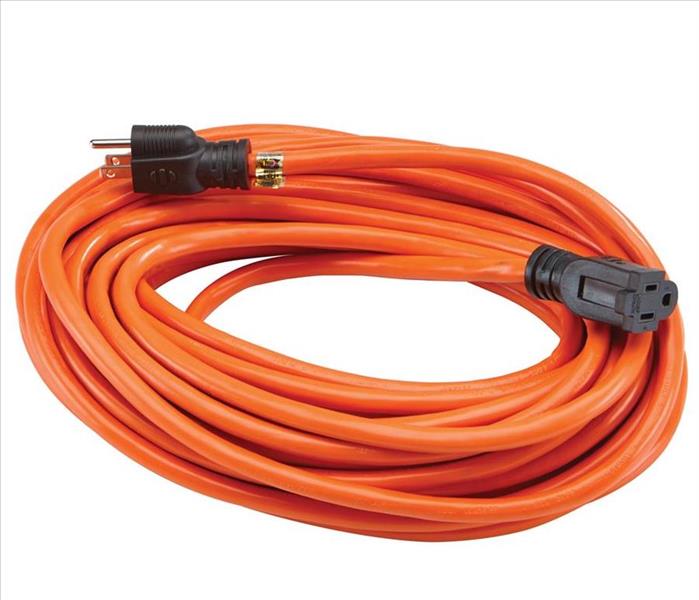 Extension Cord Safety
Extension Cord Safety
Using extension cords properly is critical to your safety. With continuous use over time, an extension cord can deteriorate, creating a potentially dangerous electric shock or fire hazard. The Electrical Safety Foundation International offers the following tips for staying safe from electric shock and electrical fires.
- Do not overload extension cords or allow them to run through water or snow on the ground
- Do not substitute extension cords for permanent wiring
- Do not run through walls, doorways, ceilings or floors. If cord is covered, heat cannot escape, which may result in a fire hazard.
- Do not use an extension cord for more than one appliance
- A heavy reliance on extension cords is an indication that you have too few outlets to address your needs. Have additional outlets installed by an electrician where you need them.
- Multiple-plug outlets must be plugged directly into mounted electrical receptacles; they cannot be chained together.
- Make sure the extension cord or temporary power strip you use is rated for the products to be plugged in, and is marked for either indoor or outdoor use.
- The appliance or tool that you are using the cord with will have a wattage rating on it. Match this up with your extension cord, and do not use a cord that has a lower rating.
- Never use a cord that feels hot or is damaged in any way. Touching even a single exposed strand can give you an electric shock or burn.
- Never use three-prong plugs with outlets that only have two slots for the plug. Do not cut off the ground pin to force a fit. This defeats the purpose of a three-prong plug and could lead to an electrical shock. Never force a plug into an outlet if it doesn’t fit.
- Use extension cords with polarized and/or three-prong plugs.
- Buy only cords approved by an independent testing laboratory, such as Underwriters Laboratories (UL), ETL-SEMKO(ETL) or Canadian Standards Association (CSA).
RAIN IS ON THE WAY, ARE YOU READY?
3/14/2019 (Permalink)
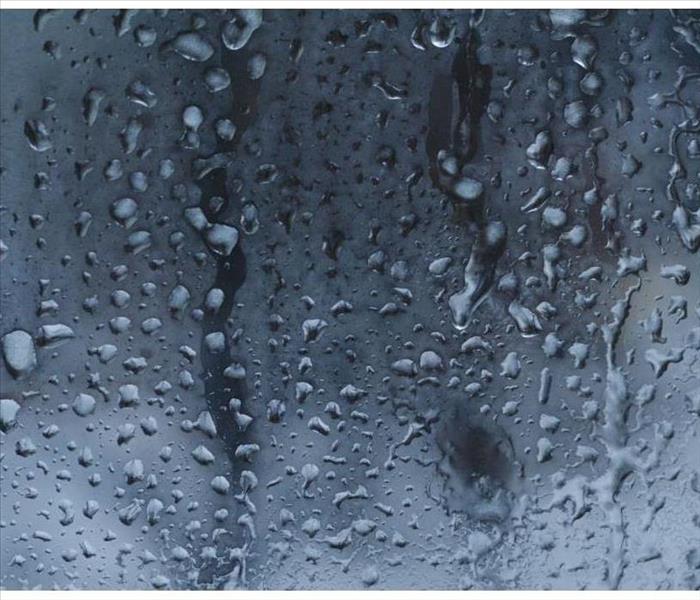 Rain is on the way!!
Rain is on the way!!
Before you know it, Spring will be here, and we will get rain. Rain can be a good thing as long as it’s not in your house. Here are some helpful tips to try to keep rain out of your home or building.
- Get your yard ready for the rain by running a metal rake over the tops of shrubs and flowers beds to loosen the soil. This will allow the dirt to better absorb the excess moisture. This should only take a few minutes, but you might prevent rain water from pooling or causing a small flood.
- Close all of your vents and windows. If you forget to do so, you could end up with costly damage. Remember to check rooms that are easily forgotten, such as basements, attics and any rooms you don’t go into on a regular basis.
- Clean your gutters. The leaves aren’t falling yet, but other debris can clog up your gutters. Clean gutters will ensure that excess rain water has proper runoff from your roof.
- Know your roof. Don’t be blindsided by roof damage in the middle of a rain storm. Make sure to get annual inspections and know when your roof is in need of repair.
If water still finds its way into your home or business, don’t worry. We will perform a free inspection and damage assessment, and talk about your options We are always available at 307-235-6558.
Fire Assessments in Casper WY
2/6/2019 (Permalink)
 Content Cleaning
Content Cleaning
When we get contacted to respond to a fire damage, our first step is to do an assessment. We look to see what is affected, how severely, and determine our initial course of action in the restoration process. If a fire has affected the structure severely enough that substantial construction will be necessary, we will typically start the job by packing out the contents from the property. Sometimes, this will be necessary in a few rooms, or a level of the house. On other jobs, it may be necessary to remove all contents from the property to make way for demolition and reconstruction.
Once the contents are packed out, we bring them back to our shop to be cleaned and deodorized. As part of the cleaning process, the contents may be treated with ozone or thermal fog to reduce smoke odor. Contents that were packed into boxes are unboxed, cleaned, deodorized, then re-packaged into clean boxes. Often, some of the contents cannot be fully restored, or restoration may exceed the cost of replacement. For these non-restorable items, we isolate them from the rest of the contents, and store them to be inventoried later.
After contents restoration is complete, the clean, deodorized household goods are stored in our temperature-controlled facility, and returned to the home once structural restoration has been completed.
Commercial Water Damage Casper WY
2/6/2019 (Permalink)
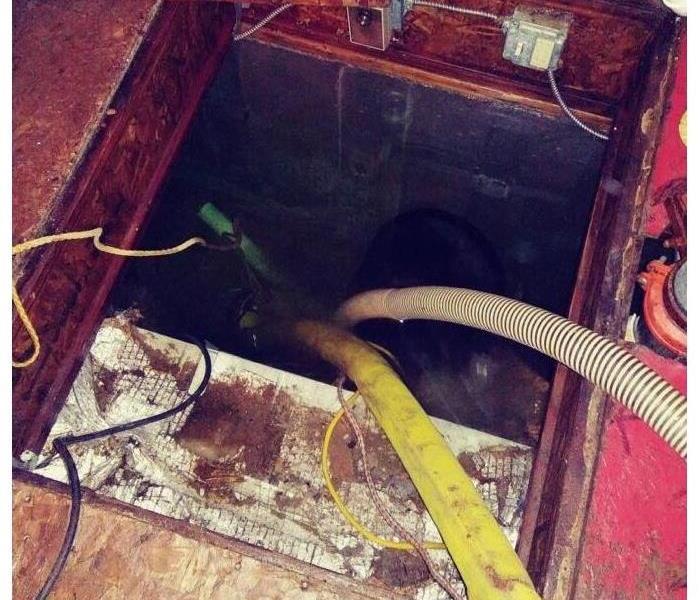 Pumping out 250.000 gallons of water.
Pumping out 250.000 gallons of water.
We received a commercial water loss in Casper on a Saturday afternoon. The source seemed to be a broken pipe in the utility room. Most of the flooring in the structure has been affected, and condensation has started affecting other materials in the area. In the crawl space there is about 250,000 gallons of water. We are doing the restoration in stages. The first night, we ran two submersible pumps for a few hours, and did water extraction on the carpeted floors. We placed air movers, portable desiccant dehumidifiers, and 2 low-grain refrigerant dehumidifiers. The following day, we continued to perform volume pumping in the crawlspace, and adjusted the drying equipment. On the third day, we continued the volume-pumping efforts, and made arrangements for larger commercial drying equipment to properly address the nature of this large water damage.
Carpet Maintenance
2/6/2019 (Permalink)
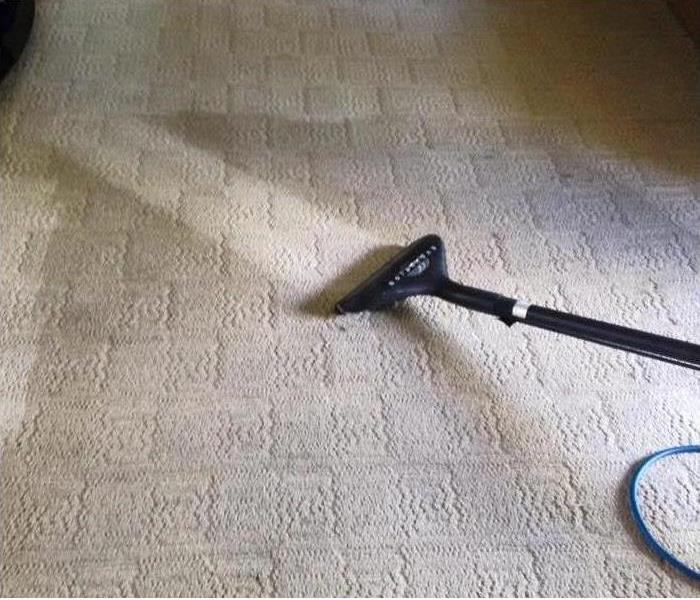 Carpet Cleaning in Casper WY
Carpet Cleaning in Casper WY
There are many things you can do to help preserve the life of your carpet. Some of these things are common knowledge, while others are lesser-known. Carpet is an expensive investment. The longer you can maintain it, the easier it will be on your wallet. Here are some easy tips to help you maximize the life of your carpets, and other household fabrics.
Frequent Vacuuming – One of the easiest ways to curb the amount of dirt and soil that accumulates on your carpeting is to vacuum it. The IICRC recommends vacuuming your carpets twice a week to keep up with the dry soil accumulation in your carpets. This may seem like a major chore in your Casper home, but it actually can help pick up hidden dirt and hair particles that would otherwise settle into your carpet fibers, and cause abrasive damage.
Household Dusting – Dust accumulates on a daily basis. Dusting daily will help trap dirt that would otherwise land on your flooring surfaces, including your carpeting. You can also combat this issue by making sure that you have a new air filter installed in your furnace. This will help to trap unwanted dust that could make its way to your carpet fibers.
Air Duct Cleaning – Air passes through your home’s HVAC system and into the air ducts. Dust, bacteria and allergens are often trapped in this space and eventually make their way through your home’s air vents and onto the carpeting. Having your air ducts professionally cleaned helps reduce dust and improves air quality.
Spot Cleaning – Anytime there is a mess from food, household products or pets, it is best to address the spot promptly. You can spot-clean with SERVPRO of Casper spotting kits. This allows you to safely target and lift spots. These products are safe to use on carpeting and many other surfaces inside your home.
Professional Deep Cleaning – Having the carpet cleaning pros from SERVPRO of Casper visit your home at least twice a year can help you keep your carpet and flooring looking its best. The powerful steam wand allows the cleaning formula to penetrate the carpet fibers. Deep down dirt, stubborn spots and odors are extracted and removed from your carpet. This not only helps to keep your carpets looking like new, but it also pulls fibers upward – reducing or eliminating dents and marks.
Area Rugs – You can help keep your carpets looking newer longer by investing in area rugs or walk-off mats. Rugs and mats can reduce soiling in areas where heavy traffic occurs. When rugs begin to show soiling or spots, SERVPRO of Casper has methods to safely and effectively clean them, and keep them looking their best.
Create a Clean-Up Station – Setting up an area where everyone removes dirty shoes and clothing before they enter the home or carpet area can help cut down on soiling. It will help reduce the amount of vacuuming and dusting you’ll have to do over time. Be sure to keep this area tidy on a regular basis.
Upholstery Deep Clean – Having your sofa, curtains and other upholstery cleaned professionally at least twice a year can help cut down on dirt. SERVPRO of Casper technicians have the knowledge and products to clean delicate upholstery, and leave them smelling fresh and odor-free.
Garbage Disposal Deodorization Tips
2/6/2019 (Permalink)
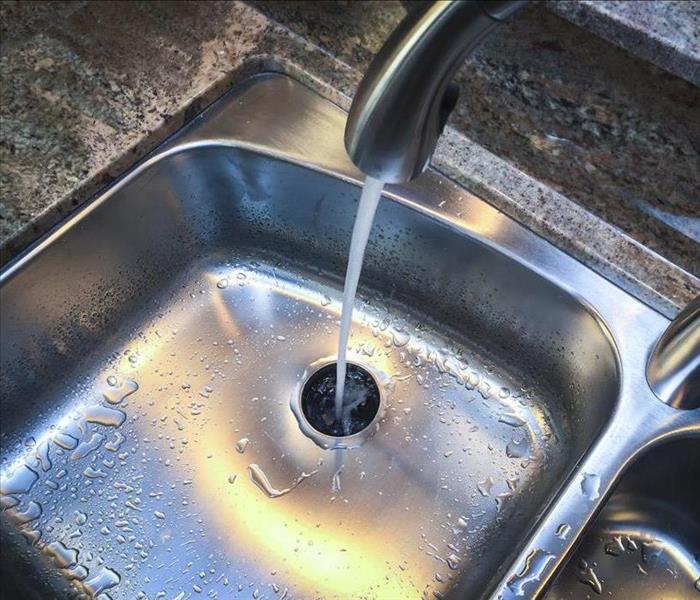 Garbage Disposal
Garbage Disposal
Have you ever stood in your kitchen and noticed a faint but terrible odor? You’ve taken out the trash, you’ve thrown out bad food in the fridge, and you can’t figure out where this mystery odor is coming from. There is a good chance that this odor is originating from your garbage disposal.
When you put food waste down the garbage disposal, food gets thrown on to the sides of the garbage disposal and on the underside of the rubber splash guard. Over time, bacteria can grow in this material, and the food residue starts to rot.
Here are some effective remedies that you can use to get rid of this odor.
USE ICE
- Take 2 cups of ice and 1 cup of salt and put it in the garbage disposal. Then run cold water, and turn on the garbage disposal for 5-10 seconds at a time until the ice has been crushed. If you want to add a boost, you can use frozen vinegar cubes.
USE BAKING SODA AND VINEGAR
- You can also use baking soda and vinegar to clean the disposal. Let the vinegar and baking soda foam for a few minutes, and then rinse it down the drain with running water. This will clean a lot of the “sludge” off of the interior sides of the disposal.
USE LEMON PEEL
- Take extremely small slices of lemon rind and grind them up to freshen the smell.
CLEAN THE UNDERSIDE OF THE SPLASH GUARD
- Don’t forget that the undersides of your splash guard need to be cleaned as well. You can lift up the undersides of the guard and clean it with an old toothbrush.
Types of mold in Wyoming
2/6/2019 (Permalink)
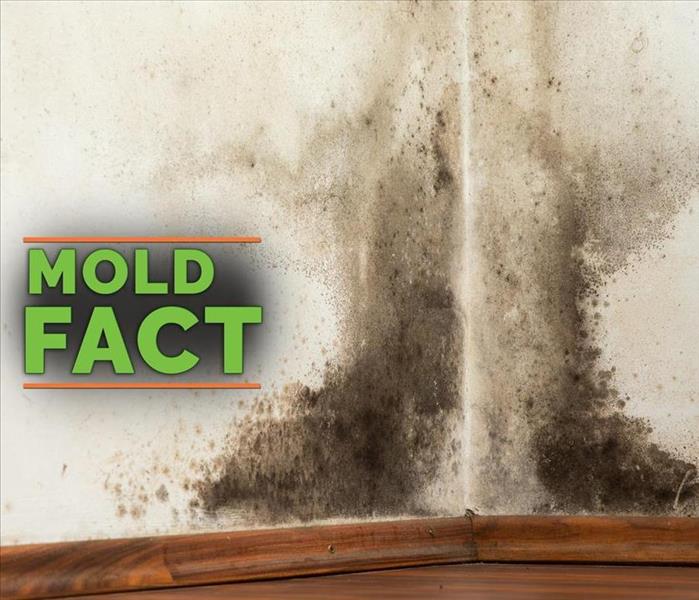 Moldy Wall
Moldy Wall
The various species of mold that can grow in a home or business can vary from region to region. Certain varieties of mold may be more common in the Southern parts of our country, but rare in Northern regions. In the Rocky Mountain region, the most common mold types found in homes are Cladosporium, Penicillium, and Aspergillus. Stachybotrys, often referred to in the media as “the black mold”, can occur in Wyoming, though it is not as common.
The only way to determine what species of mold is present in your home or commercial property is through testing by a qualified Indoor Environmental Professional (IEP). Through a series of air sampling and/or surface sampling, an IEP can determine what molds are present in your home, and the levels of concentration. They can also write a mold remediation protocol, detailing precisely what steps need to be performed in order to effectively correct the mold issue in a home or business.
The professionals at SERVPRO of Casper are certified and highly-trained in mold remediation and removal. We carefully follow written IEP protocols to remediate the problem in your property, and bring it back to a safe, normal state.
Carbon Monoxide
2/6/2019 (Permalink)
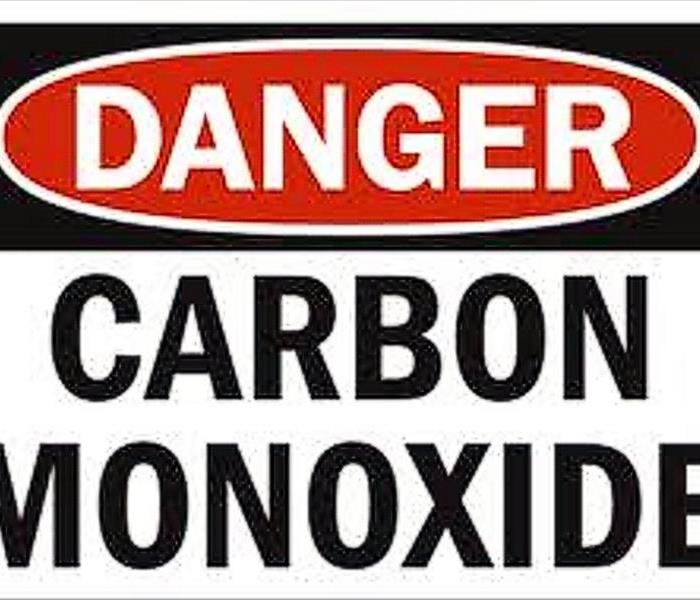 Know the signs of carbon monoxide poisoning.
Know the signs of carbon monoxide poisoning.
There is always a risk of carbon monoxide poisoning in your home or business. There are various appliances and systems that could accidentally introduce carbon monoxide into your building, and cause poisoning. Household appliances, gas fires, boilers, central heating systems, water heaters, cookers, open fires that use gas, oil, coal and wood can all pose a risk. Carbon monoxide is a colorless, odorless, tasteless gas that can be very dangerous at high levels. It can be particularly dangerous for people who are sleeping or intoxicated.
Signs and symptoms of carbon monoxide poisoning may include:
- Dull headache
- Weakness
- Dizziness
- Nausea or vomiting
- Shortness of breath
- Confusion
- Blurred vision
- Loss of consciousness
If you feel you have been exposed with carbon monoxide poisoning, get into fresh air immediately and seek medical help. If you go to the hospital, they may have you breathe pure oxygen through a mask. This helps oxygen reach your organs and tissues.
Hyperbaric oxygen therapy may be used in cases of severe carbon monoxide poisoning. Hyperbaric oxygen therapy is air pressure that is about two or three times higher than normal. Hyperbaric oxygen therapy may be used in cases of severe carbon monoxide poisoning.
Hospital staff will need critical information as soon as you arrive. On the way to the hospital, try to prepare to answer questions about:
- Possible sources of carbon monoxide exposure
- Signs or symptoms, and when they started
- Any mental impairment, including confusion and memory problems
- Any loss of consciousness
- Other medical conditions with which the affected person has been diagnosed, including pregnancy
- Smoking habits
Carbon Monoxide
2/6/2019 (Permalink)
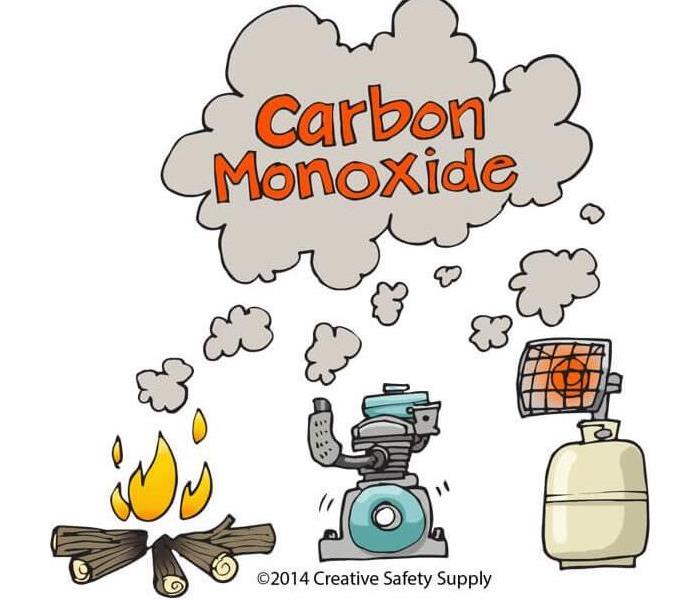 Know the signs of carbon monoxide poisoning.
Know the signs of carbon monoxide poisoning.
There is always a risk of carbon monoxide poisoning in your home or business. There are various appliances and systems that could accidentally introduce carbon monoxide into your building, and cause poisoning. Household appliances, gas fires, boilers, central heating systems, water heaters, cookers, open fires that use gas, oil, coal and wood can all pose a risk. Carbon monoxide is a colorless, odorless, tasteless gas that can be very dangerous at high levels. It can be particularly dangerous for people who are sleeping or intoxicated.
Signs and symptoms of carbon monoxide poisoning may include:
- Dull headache
- Weakness
- Dizziness
- Nausea or vomiting
- Shortness of breath
- Confusion
- Blurred vision
- Loss of consciousness
If you feel you have been exposed with carbon monoxide poisoning, get into fresh air immediately and seek medical help. If you go to the hospital, they may have you breathe pure oxygen through a mask. This helps oxygen reach your organs and tissues.
Hyperbaric oxygen therapy may be used in cases of severe carbon monoxide poisoning. Hyperbaric oxygen therapy is air pressure that is about two or three times higher than normal. Hyperbaric oxygen therapy may be used in cases of severe carbon monoxide poisoning.
Hospital staff will need critical information as soon as you arrive. On the way to the hospital, try to prepare to answer questions about:
- Possible sources of carbon monoxide exposure
- Signs or symptoms, and when they started
- Any mental impairment, including confusion and memory problems
- Any loss of consciousness
- Other medical conditions with which the affected person has been diagnosed, including pregnancy
- Smoking habits
Air Scrubbers on mold clean up
1/11/2019 (Permalink)
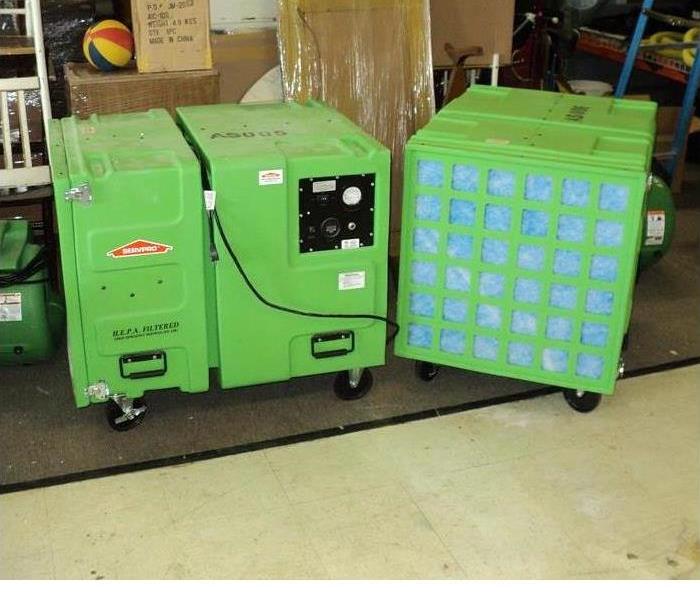 Air Scrubber
Air Scrubber
Air scrubbers, also known as air filtration devices, are used on various types of clean up projects. We use air scrubbers on mold remediation, sewage clean ups, drywall removal, and deodorization jobs. The purpose of the air scrubber is to help filter out the air of the fine particles that you can’t see. As air passes through the machine, it traps airborne particulate in the filters, releasing clean air back into the area. The critical component of an air scrubber is the high efficiency particulate air (HEPA) filter. The HEPA filter captures 99.97% of particles down to a size of 0.3 microns. (For reference, a micron is approximately 1/100th the width of a human hair.) The filtered air is very clean, and essentially free of mold spores and dust.
Water Damage Evaluation
1/7/2019 (Permalink)
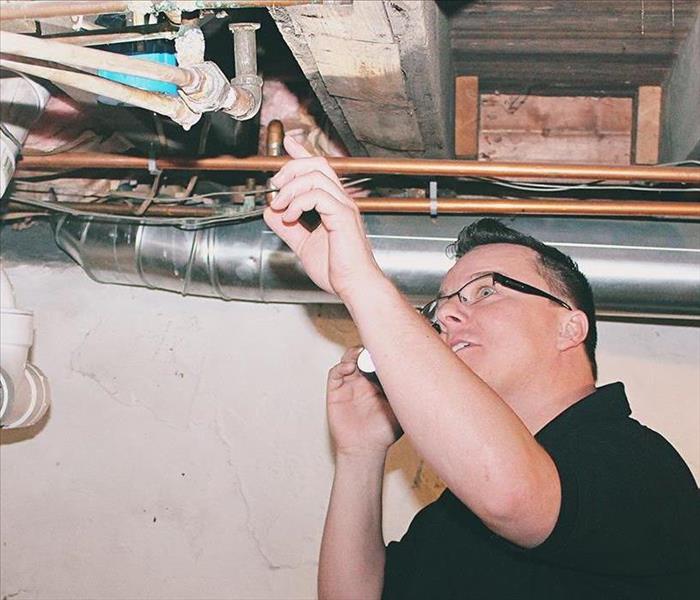 Water Damage inspection
Water Damage inspection
SERVPRO of Casper is trained and certified to clean and restore your home or business. There is a lot of steps we have to do to make sure your water is taken care of properly. The following are some of the steps we take to make sure you are taken care of properly.
- Identify the source
- Identify the type of water
- Perform emergency water extraction
- Measure temperature and humidity for drying analysis
- Survey the extent of damage and inspect the premises
- Move and block furniture
- Inspect carpet pad/carpet
- Apply necessary treatments
- Utilize drying equipment and monitor drying
- Dispose of non-restorable/contaminated buildings
If you have questions or would like help restoring your home or business after a water loss, call SERVPRO of Casper 307-235-6558
Renters Insurance
12/20/2018 (Permalink)
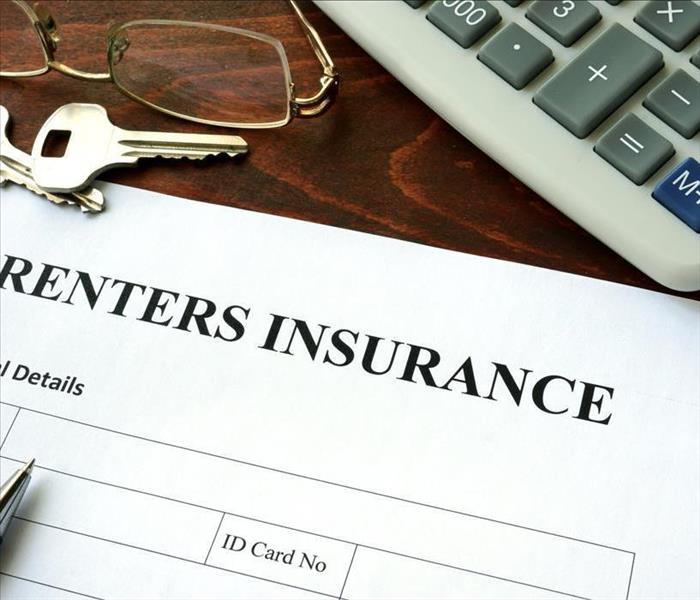 Renters Insurance
Renters Insurance
There are many renters out there that don’t understand renters insurance, or they don’t think that they need it. Here are 5 myths and facts about renter’s insurance. According to State Farm:
- MYTH: The landlord’s insurance covers your possessions. Don’t count on it. Most landlords’ insurance covers only the building and damages due to negligence. Coverage for some of the most common causes of property damage and loss, such as theft, vandalism, and fire, is entirely up to you. Without renter’s insurance, you may have to bear the financial burden of a loss on your own.
- MYTH: Renters insurance is expensive. In this case, the numbers speak for themselves. According to the IIABA, the average renter’s policy costs just $12 a month for up to $30,000 in personal property coverage. That’s solid coverage for less than the cost of a couple cups of coffee a week.
- Still concerned about price? Your insurer will work with you to find the combination of coverage and cost that suits your needs. You might even qualify for a discount by taking some simple home safety precautions or purchasing another policy, such as auto insurance, with the same insurer.
- MYTH: You don’t need insurance if your stuff isn’t expensive. Most renters’ belongings cost more than they think. In fact the average person has over $20,000 worth of belongings that are probably not covered by a landlord’s policy.
- Think that number is too high? Take a moment to add up the approximate cost of your computer, television, stereo, furniture, jewelry, and clothing. If a fire gutted your apartment tomorrow, would you have the cash to replace it all?
- MYTH: Renters insurance covers only your possessions. In fact, renters insurance covers much more than just your personal property. The average policy also includes up to $100,000 in liability coverage. That means in the event of a covered loss, your insurer will help cover the costs if you’re held responsible for injuring another person or damaging another person’s property, including our landlord’s. Moreover, this coverage applies whether the incident occurred within your residence or elsewhere.
- MYTH: Renter’s insurance is hard to get. The internet makes getting renter’s insurance easier than ever. You can research providers, compare quotes, and even find an agent online. Or, just as easily, you can place a quick call to an insurance representative. Answer a few questions and you’re likely to get a rate quote almost immediately.
Water damage demolition
12/20/2018 (Permalink)
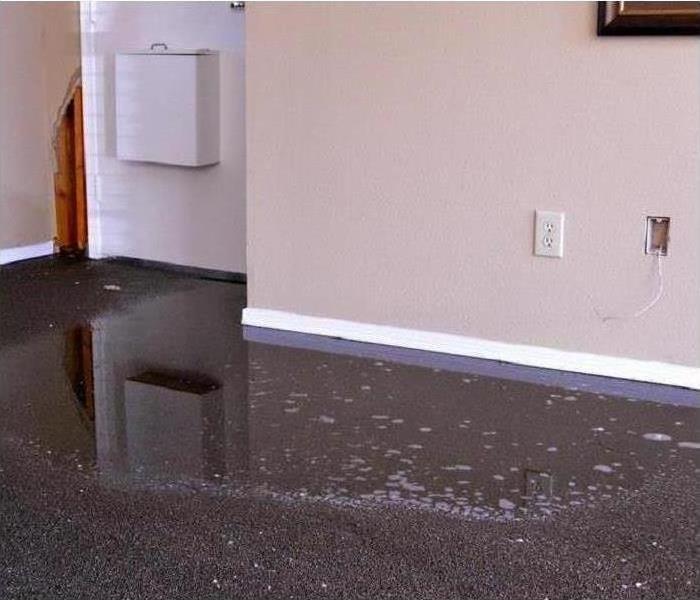 Wet carpeted in a home
Wet carpeted in a home
When a water damage happens, there are a lot of people who panic and start tearing out carpet and drywall. When a homeowner calls and asks if they should start tearing out wet materials, we typically tell them not to, because we may be able to save the materials.
Of the many factors that are in play on a water damage, one of the important ones is can we save and restore the wet materials? In most cases, materials can be saved. When we enter a water-damaged home or office, we start evaluating: what is the source of the water intrusion? Is the carpet holding together, or is it beginning to delaminate? Is the drywall falling apart? Are there wet ceilings that may collapse? Is it a safety risk?
If the carpet can be saved, we remove the pad from underneath, extract any standing water on the ground, and extract the carpet. We often “float” the carpet, by attaching the carpet to an air mover and blowing air under it. After the entire structure is dry, we replace the pad and re-stretch and reinstall the carpet.
If the carpet is not salvageable, we promptly remove the carpet and pad, and focus on drying the remaining wet materials.
If the drywall if shows significant weakness, especially the ceiling, we do need to remove it for safety reasons. Also, if there is a vapor barrier present behind the drywall, we may need to remove some of the drywall to effectively dry the framing and substructure.
When attempting to dry out wet drywall, there are many different methods that can be used. We detach baseboards and drill holes in the drywall below the baseboard line. This allows for easy airflow into the drywall, as well as the wall cavities. We also have an injection drying system, which allows us to directly inject dry air into the walls. This is a highly-effective method of addressing “hidden” water inside the walls and framing. It can also be used for hard-to-reach areas, such as the space under kitchen cabinets.
Before you start demolishing wet carpeting and walls in your home or commercial building, call the professionals at SERVPRO of Casper. Our restorative drying techniques can save a lot of your materials, and get you put back together more quickly!
Things you need to consider
12/18/2018 (Permalink)
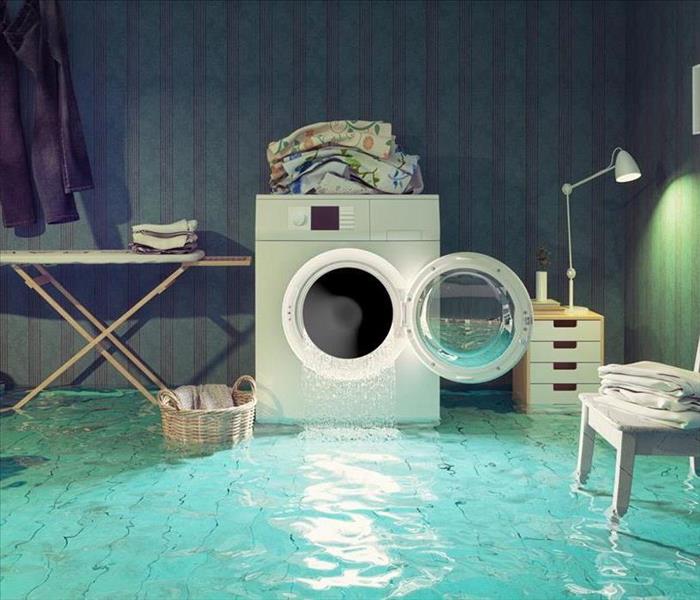 Flooded basement
Flooded basement
If you come home from a long day at work or a weekend away, and you find there are multiple inches of water in the basement, your first instinct is to shut off the water supply. Before you decide to wade through the water to shut it off, be mindful what the source may be, and the possibility of an electrical current running through it.
Things you need to consider before wading through the water:
- Is the water contaminated?
- Is there furniture or debris that could make you slip and fall?
- Are there electrical shock hazards?
- In the event of outside flooding, is there more than 6 inches of water? (If it is, the moving current can be fast enough to knock down a grown man.)
If you have any questions about your water damage, give SERVPRO of Casper a call. We can come out and do a FREE evaluation.
Checking for water Leaks
12/10/2018 (Permalink)
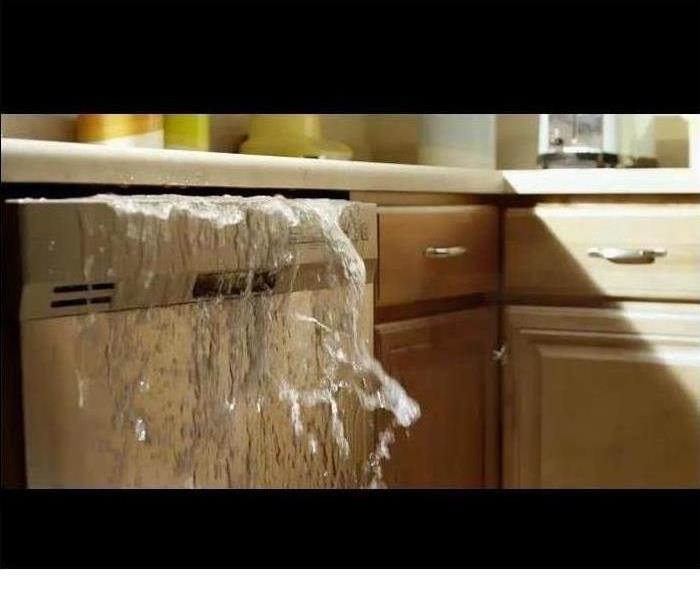 Water leaks
Water leaks
When you have a water damage, the water can work its way into all kinds of materials. It can seep into flooring, baseboards, and drywall. SERVPRO of Casper has the tools and training to check all the materials to identify what is wet and what is not.
Timely mitigation helps ensure that damage is contained and reduces the chance of microbial growth. Contacting us right away not only saves you from having contractors in your house for an extended amount of time, but it also saves you money. Here is a list of important checks in your home or office that often go overlooked:
- Check roof for deterioration
- Check gutters and downspouts
- Check basements and crawl spaces for moisture
- Check appliances in kitchens, break rooms, and cafeterias
- Check sinks and toilets in bathrooms
- Check HVAC for leaks and blockages.
If you have any questions or concerns about some wet material, feel free to give us a call at 307-235-6558.
5 Baking Safety Tips
12/7/2018 (Permalink)
 Holiday Cookies
Holiday Cookies
- D5 Baking Safety Tipson’t eat raw cookie dough. Don’t eat any kind of raw cookie dough. Even if it doesn’t have eggs in it, or it is prepackaged, there is still always a risk for food poisoning. Eating raw cookie dough is just not worth the risk.
- Wash your hands after handling eggs. When handling meat products of any kind, it’s important to prevent cross-contamination. One easy way to do this is to wash your hands with warm water and soap. Be sure to scrub them thoroughly for at least 20 seconds.
- Keep countertops clean. After rolling any cookie dough out on the counter, make sure that you clean and sanitize your counter top.
- Don’t let perishable ingredients sit on the counter for too long. Anything that comes from the fridge like eggs or milk needs to stay in the refrigerator for as long as possible.
- Before each use, perform an oven safety check.
- Make sure you do not smell gas leaking from a gas stove. If you do, open a window and leave the room.
- Make sure there is nothing in the oven. An oven should never be used for storage.
- Make sure that there are no food particles or grease residue on the stove top.
- Position your oven racks before pre-heating to prevent scalding.
Emergency Ready Profiles
11/21/2018 (Permalink)
 Emergency Ready Profile
Emergency Ready Profile
We have a program called ERP (Emergency Ready Profile). It’s a profile we put together in case of an emergency in your home or business. It’s good for employees, babysitters, or house sitters. The profile is designed to help people that have an emergency occur in their property. For example if you have water damage, and you need to shut off your water supply, the profile will show a picture of what the shut off looks like, and a description of where it’s at. It will also have contact information in case the home owner or building manager is not available.
WHY SERVPRO? We offer this FREE profile to anyone. All we need is just a little of your time, and we can make you better prepared for any type of emergency or disaster.
Frying the Thanksgiving Turkey
11/20/2018 (Permalink)
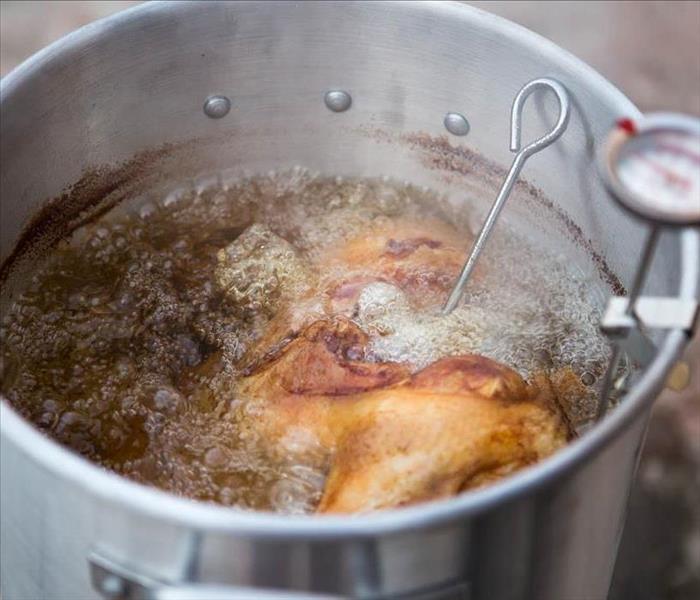 Frying the Thanksgiving Turkey
Frying the Thanksgiving Turkey
Thanksgiving is right around the corner, and the most popular traditional entrée is the turkey. There are two common types of cooking: roasting and deep-frying. According to FEMA, between 2014 and 2016 there were an estimated 2,400 residential building fires reported to fire departments in the U.S. on Thanksgiving Day. These caused an estimated 5 deaths, 25 injuries, and $19 million in property loss.
Deep-frying a turkey makes a delicious bird, but can be very dangerous. Here are a few tips on how to fry a turkey safely.
- Keep outdoor fryers off of decks, out of garages, and a safe distance away from trees and other structures.
- Make sure the turkey is fully-thawed and dry before cooking. Ice or water that mixes into the hot oil can cause flare-ups.
- Watch the weather. Never operate an outdoor fryer in the rain or snow.
- Place the fryer on a level surface, and avoid moving it once it is in use.
- Leave 2 feet between the tank and the burner when using a propane-powered fryer.
- Follow the manufacturer’s instructions to avoid overfilling. Oil can ignite when it makes contact with the burner.
- Choose a smaller turkey for frying. A bird that is 8 to 10 pounds is best. Avoid turkeys over 12 pounds.
- Never leave fryers unattended.
- Purchase a fryer with temperature controls and watch the oil temperature carefully. Cooking oil that is heated beyond its smoke point can catch fire. If you notice the oil is smoking, turn the fryer off.
- Turn off the burner before lowering the turkey into the oil. Once the turkey is submerged, turn the burner back on.
- Wear goggles to shield your eyes. Use oven mitts to protect your hands and arms, and keep an “ABC” or grease-rated fire extinguisher close by. Do not use water or a garden hose on a fryer oil fire.
- Skip the stuffing when frying turkey, and avoid water-based marinades.
- Keep children and pets away from the fryer at all times.
- Once finished, carefully remove the pot from the burner, place it on a level surface, and cover to let the oil cool overnight before disposing of it.
- Opt for an oil-less fryer. This uses infrared heat, rather than oil to cook the turkey
We hope these tips help so you have a happy and safe Thanksgiving.
Employee Certifications
11/12/2018 (Permalink)
 Employee Certifications
Employee Certifications
It’s important when hiring a company that you make sure that the company, and employees have the proper training to ensure that the job is done to industry standards. We are proud at the fact that we have our employees trained in any aspect of the job we come across. We have employees all the way from office to Owners trained.
Owners:
Jeff Sleep:
IICRC Certifications
Carpet Cleaning
Water Damage Restoration
Applied Structural Drying
Fire & Smoke Restoration
Journeyman Water Restorer
Carpet Repair & Reinstallation
Applied Microbial Remediation
Commercial Drying Specialist
Health & Safety Equivalent
Master Water Restorer
Upholstery & Fabric Cleaning
Journeyman Textile Cleaner
Odor Control
Journeyman Fire & Smoke Restorer
Master Fire & Smoke Restoration
Non IICRC Certifications
Subrogation Specialist
Trauma Scene Cleanup – Restoration Sciences Academy
Lead Based Paint Renovation, Repair and Painting
John Sleep:
IICRC Certifications
Carpet Cleaning
Water Damage Restoration
Applied Structural Drying
Fire & Smoke Restoration
Journeyman Water Restorer
Carpet Repair & Reinstallation
Applied Microbial Remediation
Commercial Drying Specialist
Health & Safety Equivalent
Master Water Restorer
Non IICRC Certifications
Subrogation Specialist
Trauma Scene Cleanup – Restoration Sciences Academy
Lead Based Paint Renovation, Repair and Painting
Technician Certifications:
Tyler A:
IICRC Certifications
Carpet Cleaning
Water Damage Restoration
Applied Structural Drying
Fire & Smoke Restoration
Journeyman Water Restorer
Carpet Repair & Reinstallation
Applied Microbial Remediation
Health & Safety Equivalent
Master Water Restorer
Upholstery & Fabric Cleaning
Journeyman Textile Cleaner
Odor Control
Journeyman Fire & Smoke Restorer
Master Fire & Smoke Restoration
Non IICRC Certifications
Employee Certification Training Program
- Crew training course
- Water Certification
- Fire Certification
- Carpet & Upholstery Certification
Lead Based Paint Renovation, Repair and Painting
Chad M:
IICRC Certifications
Water Restoration
Applied Structural Drying
Fire & Smoke Restoration
Upholstery & Fabric Cleaning
Carpet Repair & Reinstallation
Carpet Cleaning Technician
Non IICRC Certifications
Lead Based Paint Renovation, Repair and Painting
Employee Certification Training Program
- Crew training course
- Water Certification
- Fire Certification
- Carpet & Upholstery Certification
Guy N:
IICRC Certifications
Water Restoration
Fire & Smoke Restoration
Non IICRC Certifications
Employee Certification Training Program
- Crew training course
- Water Certification
- Fire Certification
- Carpet & Upholstery Certification
Chelsea W:
IICRC Certifications
Water Restoration
Non IICRC Certifications
Employee Certification Training Program
- Crew training course
- Water Certification
- Fire Certification
- Carpet & Upholstery Certification
Danyelle B:
Non IICRC Certifications
Employee Certification Training Program
- Crew training course
- Water Certification
- Fire Certification
- Carpet & Upholstery Certification
Amber V:
Non IICRC Certifications
Employee Certification Training Program
Office Staff:
Paula J:
Water Damage Restoration
Sara K:
Water Damage Restoration
Marketer:
Miamie S.
IICRC Certifications
Water Damage Restoration
Carpet Cleaning Technician
Fire & Smoke Restoration
Non IICRC Certifications
Employee Certification Training Program
- Crew training course
- Water Certification
- Fire Certification
- Carpet & Upholstery Certification
Tips for Frozen Pipes
11/5/2018 (Permalink)
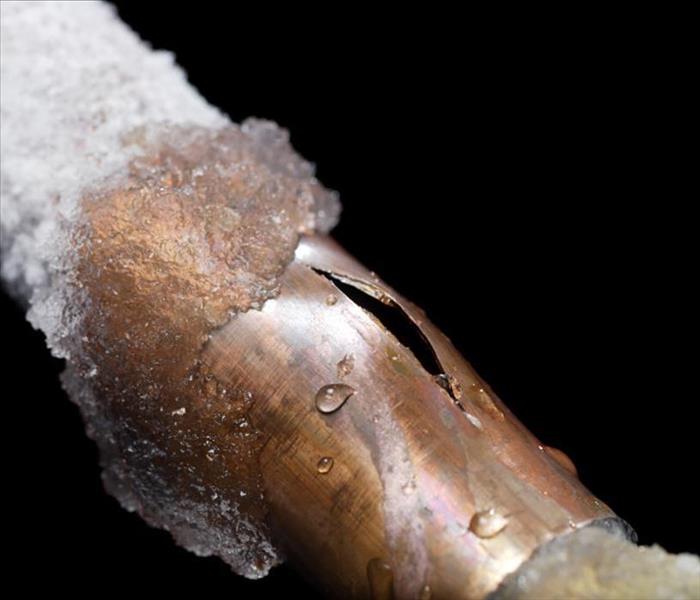 Frozen Pipe
Frozen Pipe
With winter comes freezing temperatures and frozen pipes. There are multiple reasons why and how pipes freeze in the winter.
Why Pipe Freezing is a Problem
When water freezes, it expands and puts a lot of pressure on any pipes or containers. With pipes, the pressure from the freezing water can cause them to break.
Pipes that freeze most frequently are:
- Pipes that are exposed to severe cold, like outdoor hose bibs, swimming pool lines, and water sprinkler lines.
- Water supply pipes in unheated interior areas like basements and crawl spaces, attics, garages or kitchen cabinets.
- Pipes that run against exterior walls that have little or no insulation.
How to Protect Pipes from Freezing
Before freezing temperatures, protect your pipes from freezing by following these recommendations:
- Drain water from swimming pool and water sprinkler supply lines following manufacturer’s or installer’s directions. Do not put antifreeze in these lines unless directed. Antifreeze is environmentally harmful, and is dangerous to humans, pets, wildlife and landscaping.
- Remove, drain, and store hoses used outdoors. Close inside valves supplying outdoor hose bibs. Open the outside hose bibs to allow water to drain. Keep the outside valve open so that any water remaining in the pipe can expand without causing the pipe to break.
- Add insulation to attics, basements, and crawl spaces. Insulation will maintain higher temperatures in these areas.
- Check around the home for other areas where water supply lines are located in unheated areas. Look in the garage, and under kitchen and bathroom cabinets. Both hot and cold water pipes in these areas should be insulated.
How to Prevent Frozen Pipes
- Keep garage doors closed if there are water supply lines in the garage.
- Open kitchen and bathroom cabinet doors to allow warmer air to circulate around the plumbing. Be sure to move any harmful cleaners and household chemicals up out of the reach of children.
- When the weather is very cold outside, let the cold water drip from the faucet served by exposed pipes. Running water through the pipe-even at a trickle-helps prevent pipes from freezing.
- Keep the thermostat set to the same temperature both during the day and the night. By temporarily suspending the use of lower nighttime temperatures, you may incur a higher heating bill but you can prevent a much more costly repair job if pipes freeze and burst.
- If you will be going away during cold weather, leave the heat on in your home, set to a temperature no lower than 55F.
If you still have a pipe break despite these precautions, remember that SERVPRO of Casper is here for you, 24 hours a day, 365 days a year.
Leaky Roof
9/28/2018 (Permalink)
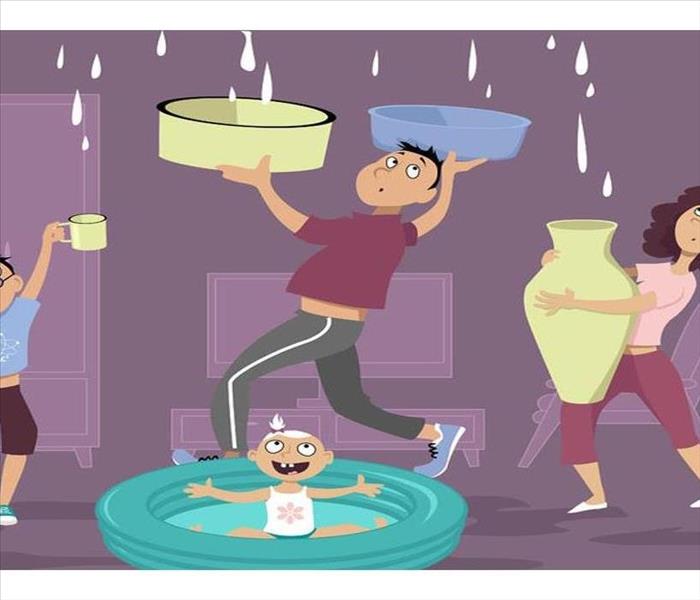 Leaky roof
Leaky roof
10 Signs That You Need Roof Repair
In the event of heavy raining, your Casper home could be at risk of suffering a water damage that could cost you more than just a new roof. Uncorrected water damage could provide the proper conditions for microbial growth in the home. In small amounts, microbial growth can be remediated with minimal destruction to the home. But if undiscovered for a period of time, it can cause homeowners to be put out of home for the duration of remediation and reconstruction.
Here are some signs if you have a leaky roof:
- There’s a water stain
A water stain may look like a large puddle on the ceiling; it’s often a brownish color. Smaller stains could be a sign of a much bigger leak. If you notice discoloration on your ceiling or walls, take a closer look for mold, moisture, and other telltale signs of a leak.
- Sometimes There’s a Drip
If you see drips, moisture on the walls, or moisture stains but don’t see them often, you may still have a leak in your roof. Even if the leak seems to go away, you still need to get it checked. You may have an ice dam caused by the freezing and thawing of melting snow and ice. The thawed water moves under the shingles and then freezes again, causing intermittent leaks. The rules with any leaks: if you see moisture, investigate, even if it seems to go away. Moisture problems can cause permanent damage.
- There Are Spots on Your Exterior Walls
Everyone once in a while, take a look under your roof line outdoors. If there are water spots under there, you may have trouble where the walls meet the roof. Water spots in this location can point to problems with your flashing.
- Your Walls Are Growing
If you have a mossy or moldy exterior wall, it could be that it’s in a less-than-sunny spot, but it could also point to a problem with your downspouts or gutters. Downspouts and gutters are an important part of your roofing system. When it’s leaking, you may see signs of erosion below the gutters and signs of moisture on the side of your building exterior. Adding gutter covers and gutters heating and repairing sagging gutter can reduce your problems with clogged or icy gutters.
- You See Missing Shingles or See Debris in Your Downspouts
Missing shingles, problems with seams your shingles and other structures such as chimneys could point to trouble. Even though you don’t see a leak inside your house, there could be a slow leak into the attic or crawl space. When you see damage occurring on your roof, ask for an inspection so you know more about the condition of the roof and if there are any leaks.
If you run into a leaky roof, call SERVPRO of Casper. We can come out and do a free inspection inside your home for hidden water damage.
Different Stages of loss
9/28/2018 (Permalink)
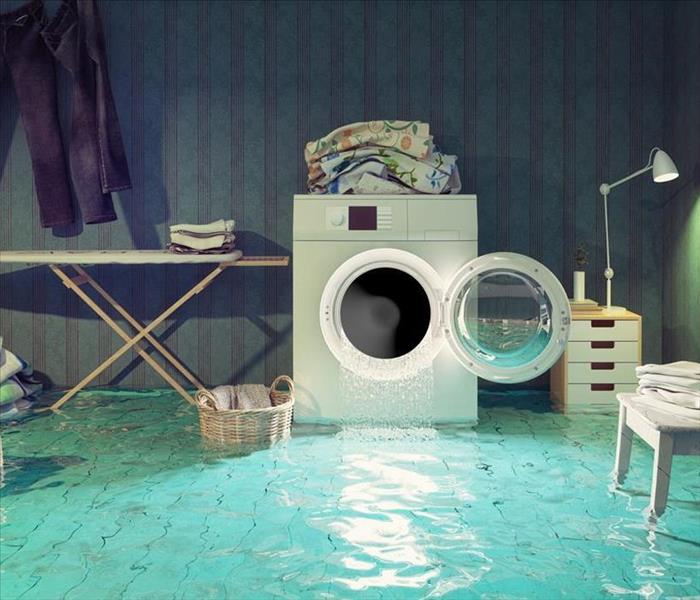 Water Damage Stages
Water Damage Stages
Here are the reasons you should mitigate your water damage sooner than later.
Water Damage Time Line
Within Minutes
- Water quickly spreads throughout your property, saturating everything in its path
- Water is absorbed into walls, floors, upholstery, and belongings
- Furniture finishes may bleed, causing permanent staining on carpet
- Photographs, books, and other paper goods start to swell and warp
Hours 1-24:
- Drywall begins to swell and break down
- Metal surfaces begin to tarnish
- Furniture begins to swell and crack
- Dyes and inks from cloth and paper goods spread and stain
- A musty odor appears
48 Hours to 1 Week
- Mold and mildew may grow and spread
- Doors, windows, and studs swell and warp
- Metal begins to rust and corrode
- Furniture warps and shows signs of mold
- Paint begins to blister
- Wood flooring swells and warps
- Serious biohazard contamination is possible
After 1 week
- Restoration time and cost increase dramatically; replacing contaminated materials and structural rebuilding may be extensive
- Structural safety, mold growth, and biohazard contaminants pose serious risk to occupants
SERVPRO of Casper specializes in the cleanup and restoration of residential and commercial property after a fire, smoke, or water damage event. We respond promptly, and dry your home quickly, minimizing the damage that your home sustains.
List of Services that SERVPRO of Casper offers
9/28/2018 (Permalink)
 A Cleaning To Do List!!
A Cleaning To Do List!!
Some people may wonder what all SERVPRO of Casper can do for you.
Here is a list of services we provide.
- Water Damage Restoration
- Storm Damage Restoration
- Commercial Restoration
- In-Place ( Top-Down) Drying Services
- Sewage Cleanup
- Bio Hazard Cleanup
- Carpet & Upholstery Cleaning
- Mold Remediation/Mitigation
- Fire/Smoke Restoration (Contents & Structure)
- Move-Out/Storage Services
- Duct/HVAC System Cleaning
- Deodorization
- Vandalism/Crime Scene Cleanup
- Temporary Heating Services
- Dryer Vent Cleaning
- Document Drying
- Dry-Cleaning of Drapery and Upholstery
- Dumpster/Debris Removal
- Furniture Restoration
- Moving Services
- One Time Clean
- Drapery Cleaning
- Area Rug Cleaning
- Blind Cleaning
- Power Scrubbing
- Strip and Waxing
- Scrub and Recoat
- Deodorization
- Ceiling Cleaning
- Hoarder Cleanup
- Pest Cleanup
If you’re in need of any of our services call us day or night. We are available 24/7, 365 day a year for emergencies.
Emergency READY Profile
9/27/2018 (Permalink)
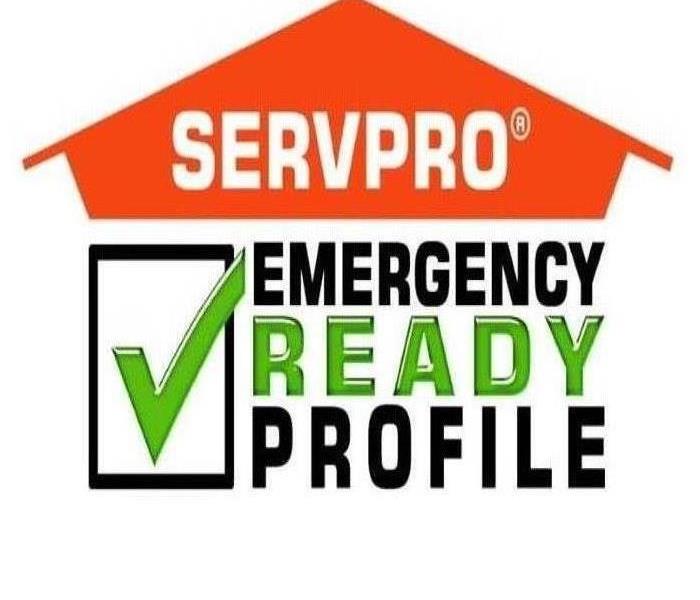 Emergency READY Profile
Emergency READY Profile
When you need your water, fire, or mold damage fixed quickly and correctly, call SERVPRO of Casper. We do mitigation and restoration services on both commercial and residential properties. We offer quality cleaning and quick response – that is the SERVPRO way.
SERVPRO of Casper can develop a free Emergency READY Profile for your business. This assessment of your commercial facility creates an immediate plan of action, in case disaster strikes. A compact portfolio contains all the information that you need for priority response. Important details such as key contacts, the location of shut-off valves and breakers, and priority areas in your building ensure that emergency services can begin quickly. With some prior planning, the professionals at SERVPRO of Casper can minimize the interruption to your business, and get you up and running again as soon as possible.
Steps for Mold Clean Up in Casper, WY
8/15/2018 (Permalink)
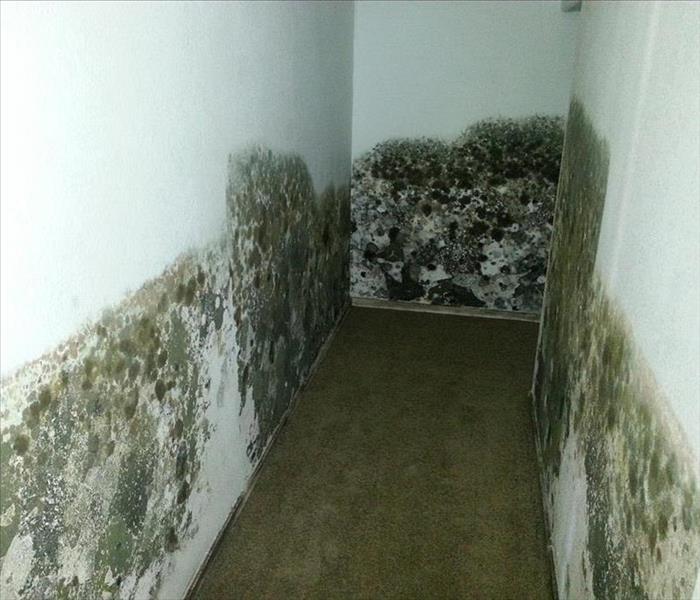 Moldy walls all the way down the hall.
Moldy walls all the way down the hall.
If you notice musty odors in your home, or discover damage that appears to be mold, you should definitely have a professional look at it. A visual inspection from SERVPRO of Casper can help identify what caused the damage, and what needs to be done to correct it.
Sometimes, we may recommend that you have an Industrial Hygienist perform testing. While home mold test kits are a popular, inexpensive purchase at local hardware stores, they are inadequate for proper mold assessment. An Industrial Hygienist is an expert in Indoor Air Quality, and is properly trained to collect samples and analyze them. Once the analysis is done, an Industrial Hygienist writes a mold remediation protocol, detailing the exact steps required to effectively remove the mold. Armed with this information, the professionals at SERVPRO of Casper can perform remediation services to bring your home or business back to a normal state.
Work Stress relief
8/15/2018 (Permalink)
 Just Breath!!!
Just Breath!!!
According to the American Psychological Association, work-related stress unfortunately doesn’t just go away when you go home. When stress persists, it can take a toll on your health, and personal life.
A stressful work environment can cause headaches, stomachaches, sleep disturbances, short temper and difficulty concentrating. In worse cases, it can cause health problems such as anxiety, insomnia, high blood pressure, and a weak immune system. It can lead to depression, obesity, and heart disease. Some take up smoking, drinking or even use drugs.
These are common sources of work stress:
- Low salaries
- Excessive workloads
- Few opportunities for growth or advancement
- Work that isn’t engaging or challenging
- Lack of social support
- Not having enough control over job-related decision
- Conflicting demands or unclear performance expectations
It is very important to control the stress and take the proper steps before it affects your life.
Track your stressors. Keep a journal for a week or two to identify which situations create the most stress and how you respond to them. Include the people and circumstance involved and the physical setting and how you reacted. Did you raise your voice? Get a snack from the vending machine? Go for a walk? By taking notes you find patterns among your stressors and your reactions to them.
Take time to recharge. We need time to replenish and return to our pre-stress level of functioning. This requires “switching off” from work by having periods of time when you not engaging in work related activities, or thinking about them. When possible, take time off and unwind, so you come back to work feeling reinvigorated and ready to perform your best. When you’re not able to take time off, get a quick boost by turning off your smartphone and focus your attention on non-work activities for a while.
Learn how to relax. Techniques such as meditation, deep breathing exercises, and mindfulness. Start by taking a few minutes each day to focus on a simple activity like breathing, walking, or enjoying a meal. Being able to focus on a simple activity without distraction will get stronger will practice. You will find that you can apply it many different aspects of your life.
Get some support. Accepting help from trusted friends and family members can improve your ability to manage stress. Your employer may also have stress management resources available through them.
If you’re human, you’re going to have stress. But there is a healthy limit and an unhealthy limit. Don’t let it get to where it’s unhealthy!
Wild Fire Zones
7/25/2018 (Permalink)
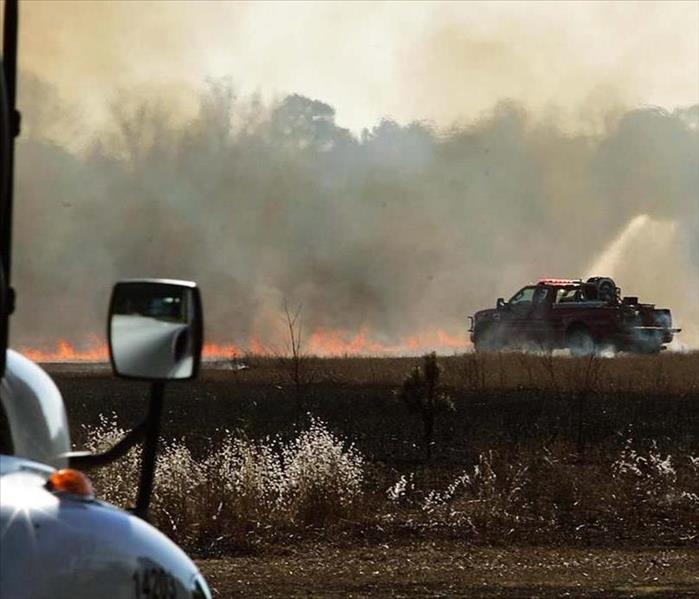 Field fire
Field fire
We have had a really wet spring this year, and that can mean two different things. On one hand, the trees, grass and shrubs are growing lush and green. But unfortunately in Casper, it does turn brown later in the season, and makes fuel for fire. There are many things that can start a wildland fire, anywhere from human irresponsibility to naturally-occurring events, such as lightning strikes. There are steps you can take to protect your home, whether you reside in the city, up in the mountains, or out on the Wyoming prairies. There are 3 types of defensive zones to help protect your home:
Zone 1
- Prune and maintain any plants to prevent excessive growth. Also, remove all dead branches, stems and leaves within and below the plant.
- Do not store firewood or other combustible materials anywhere in this zone. Keep firewood at least 30 feet away from structures, and uphill if possible.
- Remove any branches that overhang or touch the roof, and remove all fuelswithin 10 feet of the chimney.
- Remove all pine needles and other debris from the roof, deck and gutters.
- Rake pine needles and other organic debris at least 10 feet away from all decks and structures.
Zone 2
- Limit the number of dead trees (snags) to one or two per acre. Be sure snags cannot fall onto the house, power lines, roads or driveways.
- Small groups of two or three trees may be left in some areas of Zone 2, but leave a minimum of 30 feet between the crowns of these clumps and surrounding trees.
- Remove all ladder fuels from under remaining trees. Prune tree branches off the trunk to a height of 10 feet from the ground or 1/3 the height of the tree, whichever is less.
- Locate propane tanks and natural gas meters at least 30 feet from any structures, preferably on the same elevation as the house.
- The tank should not be located below your house because if it ignites, the fire would tend to burn uphill. Conversely, if the tank or meter is located above your house and it develops a leak, gas will flow downhill into your home.
- Do not visibly screen propane tanks or natural gas meters with shrubs, vegetation or flammable fencing. Instead, install 5 feet of nonflammable ground cover around the tank or meter.
Zone 3
- While tree pruning generally is not necessary, it may be a good idea from the standpoint of personal safety to prune trees along trails and firefighter access roads. Or, if you prefer the aesthetics of a well-manicured forest, you might prune the entire area. In any case, pruning helps reduce ladder fuels within tree stands, thus reducing the risk of crown fire.
- Remember to consider the hazards associated with ladder fuels. A forest with a higher canopy reduces the chance of a surface fire climbing into the tops of the trees, and might be a priority if this zone has steep slopes.
Safety Tips on How to Handle Mold
7/13/2018 (Permalink)
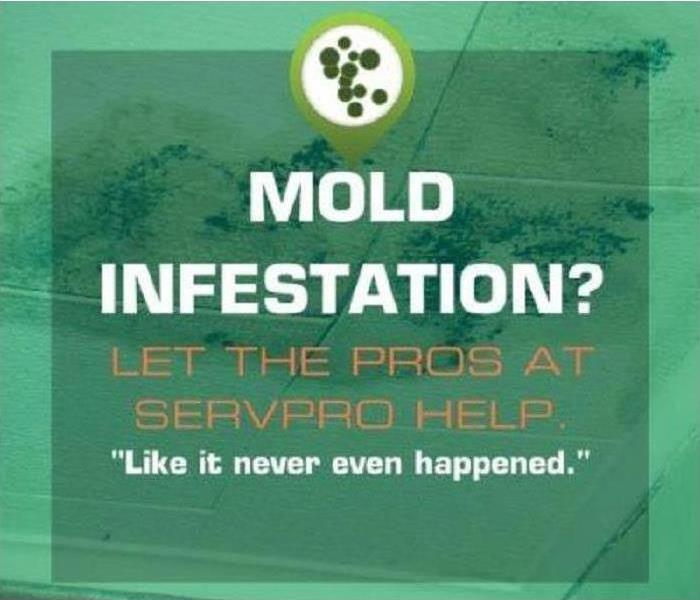 Safety Tips on How to Handle Mold
Safety Tips on How to Handle Mold
If you see visible mold or think you have mold in a room of your home, there are some measures you should take to keep it from spreading.
Things to do:
- Call a Certified Industrial Hygienist (CIH)
- Stay out of the affected room
- Turn off the HVAC system in that room
Things not to do:
- Don’t disturb the mold
- Don’t blow air in the area
- Don’t spray bleach or other cleaning products
SERVPRO of Casper specializes in mold remediation. We have technicians that are IICRC (Institute of Inspection of Cleaning and Restoration) certified specifically as AMRT (Applied Microbial Remediation Technicians).
If you have any concerns that you may have mold, call SERVPRO of Casper before buying the “do-it-yourself” mold testing kits from the hardware store. These kits typically involve a swab and a Petri dish. Because normal environments always contain a small amount of mold spores, using them will always end with a “positive” test result, even if there is no real problem in your home. A visual inspection by the professionals at SERVPRO, coupled with testing performed by a qualified CIH will give you accurate answers, and a plan to properly take care of any microbial problems you may have.
Moldy Crawl Spaces
7/10/2018 (Permalink)
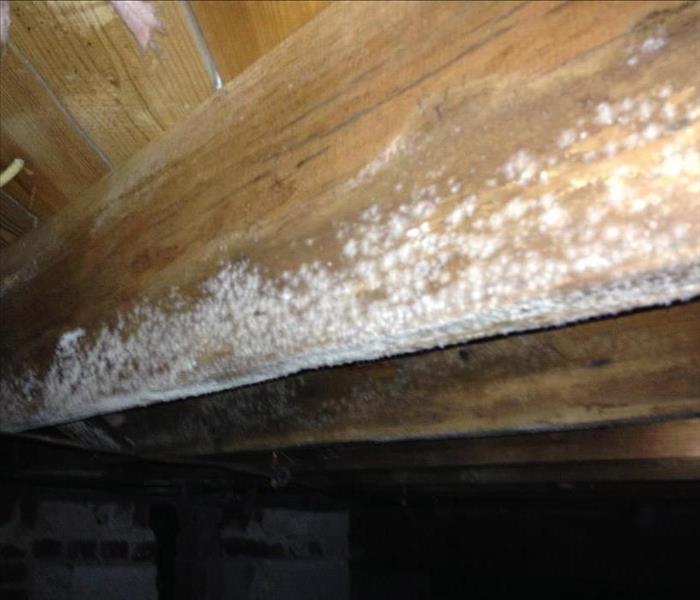 Mold in Crawl Space
Mold in Crawl Space
When was the last time you checked out your crawlspace?
If you haven’t inspected your crawlspace in a while you probably should, and check it regularly as well. At any time you could have water damage in your crawlspace and never know it. People often think that their crawlspace is just dirt, and the water will simply absorb into the ground. Often, this is true. But larger amounts of water, continuous leaks, or high bentonite content in the soil (common in Casper) could mean that it will not dry out on its own quickly. With saturated soil and standing water, high humidity can develop in the crawlspace. If that humidity condenses on the underside of the subfloor and flooring joists, secondary damage can occur. If these porous materials stay wet, mold can grow. With its lack of sunlight and air flow, a crawlspace is a perfect environment for microbial growth.
If you check your crawlspace and see any suspected microbial growth, give SERVPRO a call. We will come out and do a free inspection. We will review the steps that need to be taken to bring your crawlspace back to a safe state. Call SERVPRO of Casper today for your free assessment at 307-235-6558.
The different types of flooding.
7/9/2018 (Permalink)
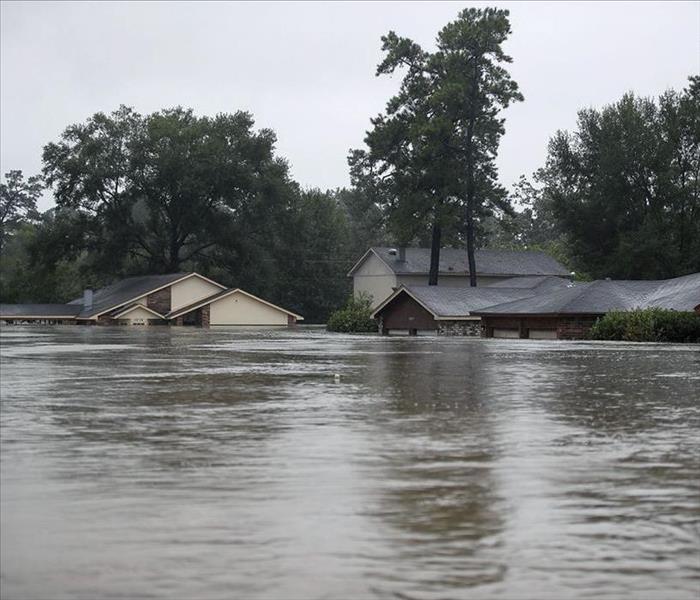 Flooded streets
Flooded streets
Did you know that there is 3 Types of Floods? If you didn’t there is, there is Coastal (Surge Flooding), Fluvial (River Flood), and Pluvial (Surface Flood). Each is unique on how much damage it can cause, and how soon the cleanup can be. Here are the ways the 3 are different from each other.
Coastal (Surge Flooding) -
A coastal flood lies on the coast of a sea, ocean, or other large body of open water. Extreme tidal conditions caused by severe weather such as hurricanes and other storms. These types of storms push water onshore which causes coastal flooding. In this type of flood, water overwhelms low-lying land and often causes devastating loss of life and property.
Coastal Flooding is categorized in three levels:
Minor: A small amount of beach erosion will occur but no major damage is expected.
Moderate: A fair amount of beach erosion will occur as well as damage to some homes and businesses.
Major: Serious threat to life and property. Large-scales beach erosion will occur, numerous roads will be flooded, and many structures will be damaged.
Fluvial (River Flooding) –
River, or riverine flooding, occurs when excessive rainfall over an extended period of time causes a river to exceed its capacity. Snow melt and Ice jams can also cause the river to spill over. The damage from the fiver flood can be widespread as the overflow affects smaller rivers downstream.
There are two main types of riverine flooding:
- Overbank flooding occurs when water rises overflows over the edges of a river or stream. This is the most common and can occur in any size channel. Anywhere from streams, to rivers.
- Flash flooding can be intense, high velocity torrent of water that occurs in an existing river channel with little to no notice. Flash floods are very dangerous, and destructive not only because of the force of the water, but also the hurling debris that is often swept up in the flow.
Pluvial (Surface Flood) -
Surface water flood is caused when heavy rainfall creates a flood event independent of an overflowing water body. You don’t have to be near a body of water to be out of a flood risk, it can even happen in urban areas.
After Fire Tips
6/26/2018 (Permalink)
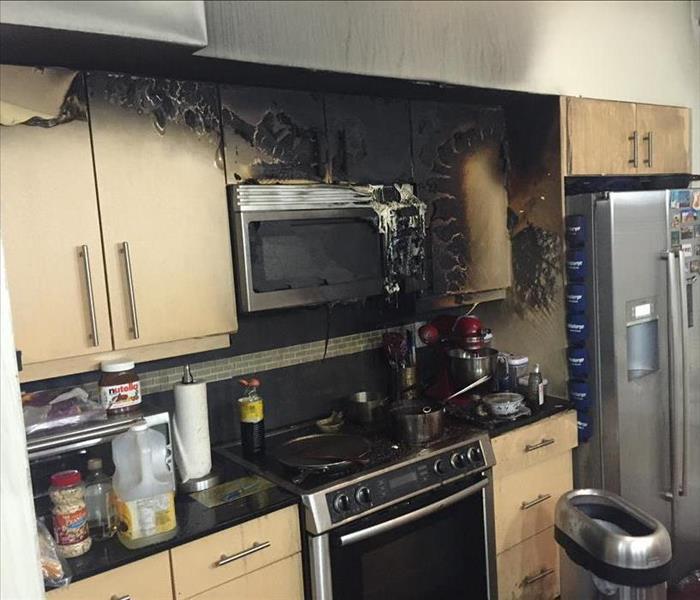 Fire/Smoke damage kitchen.
Fire/Smoke damage kitchen.
The aftermath of a fire can be chaotic and emotionally devastating. You may be concerned with the damage done to your property, and the business you’re likely to lose as a result of it. Although it can be difficult, it’s important to stop, take a deep breath, and prioritize what needs to be done. Follow these steps to help make sure your loss goes smoothly as possible.
- Contact Your Insurance Provider
It’s important to contact your insurance provider first, so that you can begin the process of filing a claim. Your provider will want to send a claims adjuster to assess the damage, and the sooner this can be scheduled, the sooner you will receive payment to pay for restoration services.
2. Secure Your Property
Fire can leave your building with large holes in the walls and ceilings, leaving the contents exposed to further damage. Your insurance will cover damages from the fire, but it won’t cover damage from rain and snow entering the building after the fire, or theft resulting from the building being easily accessible. - Document the Damage
Your insurance company will require evidence of your losses. Take photographs or videos of as much damage as you can without putting yourself in danger. It’s also good to compile a list of everything lost in the fire. If you have receipts or other documentation, start pulling these together.
4. Resist the Temptation To Clean Up
Although you may feel tempted to begin throwing things away or making repairs, don’t. It’s important that the claims adjuster has a chance to assess the original damage. It’s also better to let a fire restoration specialist assess your property before throwing it out. Items you believe to be destroyed by smoke damage may actually be salvageable through smoke cleaning.
If you experience a loss, give us a call. We will come out and discuss the process, on what we can and cannot do, and how to get started in the restoration process.
Mold Clean Up
6/8/2018 (Permalink)
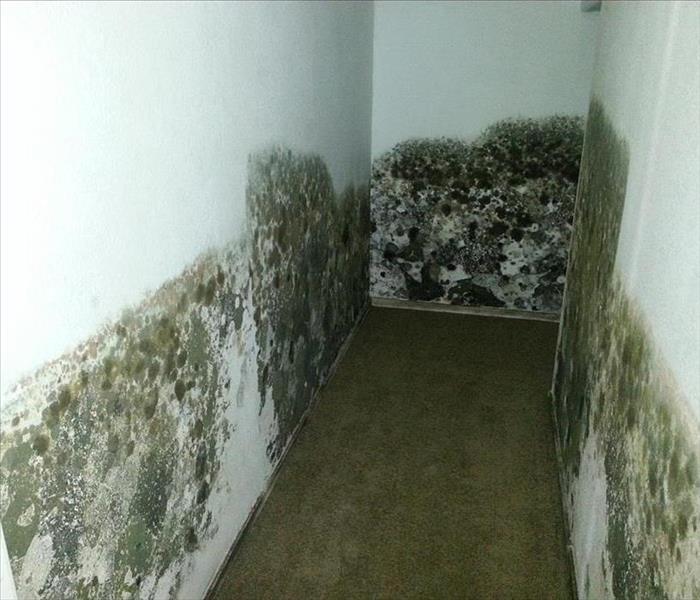 Moldy Drywall
Moldy Drywall
Mold damage on a water loss
A lot of different materials in your home can be affected by water damage, and some of these materials can grow mold if not taken care of right away. Here are a few examples:
Drywall:
The paper backing on drywall is organic, and is susceptible to mold growth. Humidity and moisture in a structure can aggravate the growth of mold. Drywall that is contaminated by mold has to be cut out and removed properly, to keep any spores and hyphal fragments from spreading.
Wood Framing:
Because wood is a purely organic material, mold can quickly form and colonize on it. This is especially true of framing that is covered by drywall. The lack of light and airflow inside a wet wall cavity creates optimal conditions for mold growth. Once moldy drywall is removed, some mold growth on the wood framing can be expected. It is important that the mold is properly removed from the framing, and that the framing is properly dried, before new drywall is installed.
Carpet:
Modern carpets are made almost exclusively of synthetic materials. While synthetic materials are not a viable food source for mold, the carpet face, backing, and pad normally have dust trapped in or under them. This dust (dead skin cells, pet dander, etc.) can support mold growth. Carpet and pad can hold a lot of water, so it’s important to begin water removal quickly. If there is mold on the carpet, just like on drywall, properly removing carpet and pad and treating the subfloor will help prevent further spreading of spores. After structural drying is complete, new carpet and pad can be installed.
If you encounter any mold in your home, call SERVPRO of Casper at 307-235-6558 today. We can send a certified technician to inspect the damage, and guide you through the steps to remediate it properly.
Commercial Services
5/21/2018 (Permalink)
 Commercial Building
Commercial Building
When it comes to commercial cleaning and restoration services, SERVPRO is a leader in the industry. We are available 24/7 365 day. SERVPRO of Casper responds quickly to your business’s fire, water, and mold damage emergencies.
Here are some commercial services we provide:
- Commercial Restoration Services
- Commercial Water Damage Restoration
- Commercial Fire Damage Restoration
- Commercial Mold Remediation
- Commercial Storm and Major Events
We also offer Commercial Cleaning Services. We have the specialized equipment, various products, and skilled cleaning methods to make your business look its very best.
- Commercial Cleaning Services
- Air Ducts and HVAC
- Bio-hazard and Sewage
- Post-Construction Cleanup
- Carpet, upholstery, area rugs, and drapes
- Ceilings, Walls and Hard Floors
- Odor Removal and Deodorization
- Vandalism
When the need arises for professional cleaning or emergency restoration services, SERVPRO of Casper is here for you to make it “Like it never even happened.”
Food Mold Growth
5/4/2018 (Permalink)
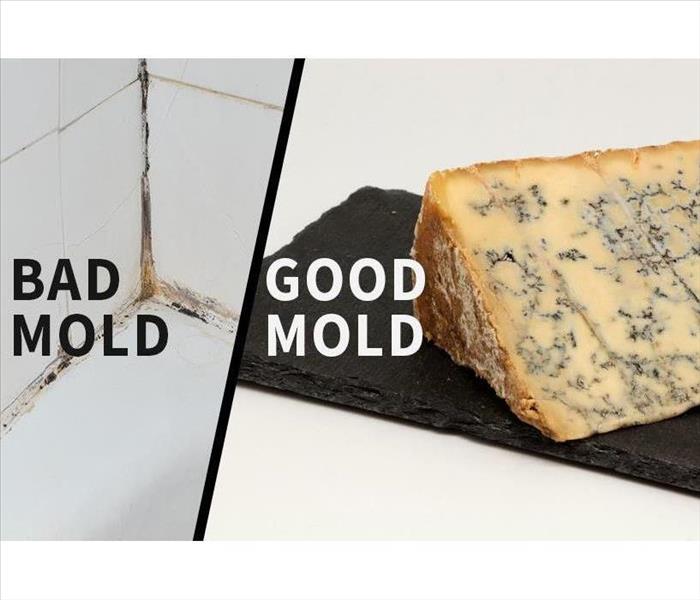 Moldy Food
Moldy Food
How can you minimize mold growth? Cleanliness is vital in controlling mold. Mold spores from affected food can build up in your refrigerator, dishcloths, and other cleaning utensils.
- Clean the inside of the refrigerator every few months with 1 tablespoon of baking soda dissolved in a quart of water. Rinse with clear water and dry. Scrub visible mold on rubber casings using 3 teaspoon of bleach in a quart of water.
- Keep dishcloths, towels, sponges and mops clean and fresh, a musty smell means they’re spreading mold around. Discard items you can’t clean or launder.
- Keep the humidity level in the house below 40%.
How can you protect food from mold?
- When serving food, keep it covered to prevent exposure to mold spores in the air. Use plastic wrap to cover foods you want to stay moist – fresh, or cut fruits and veggies, and greens and mixed salads.
- Empty opened cans of perishable foods into clean storage containers and refrigerate them promptly.
- Don’t leave any perishables out of the refrigerator more than 2 hours.
- Use leftovers within 3-4 days so mold doesn’t have a chance to grow.
How should you handle food with mold on it? Buying small amounts and using food quickly can help prevent mold growth. But when you see moldy food:
- Don’t sniff the moldy item. This can cause respiratory trouble.
- If food is covered with mold, discard it. Put it into a small paper bag or wrap it in plastic and dispose in a covered rash can that children and animals can’t get into.
- Clean the refrigerator or pantry at the spot where the food was stored
- Check nearby items the moldy food might have touched. Mold spreads quickly in fruits and vegetables.
Commercial Duct Cleaning
4/23/2018 (Permalink)
 Commercial Duct Cleaning in Casper, WY
Commercial Duct Cleaning in Casper, WY
Owners or maintenance mangers don’t really think about duct cleaning when it comes to their yearly deep clean of their building. But it is just as important as cleaning floors, baseboards, and windows.
Poor indoor air quality, inefficient air filtration, and duct leaks can all result in dust entering the duct system. This dust can accumulate and start to break off and re-enter in the air. This is why workspaces become dusty faster.
Pest infestations are another reason to have your ducts cleaned. It’s not uncommon for mice, squirrels, bees, and other pests to find their way into the duct system. They leave behind nesting material, hair, and dead insects. Particles of these are then blown out into your workspace.
When you get ready to do your deep cleaning for the year, call in the professionals at SERVPRO of Casper to inspect and clean your ducts.
Safety grilling tips
4/16/2018 (Permalink)
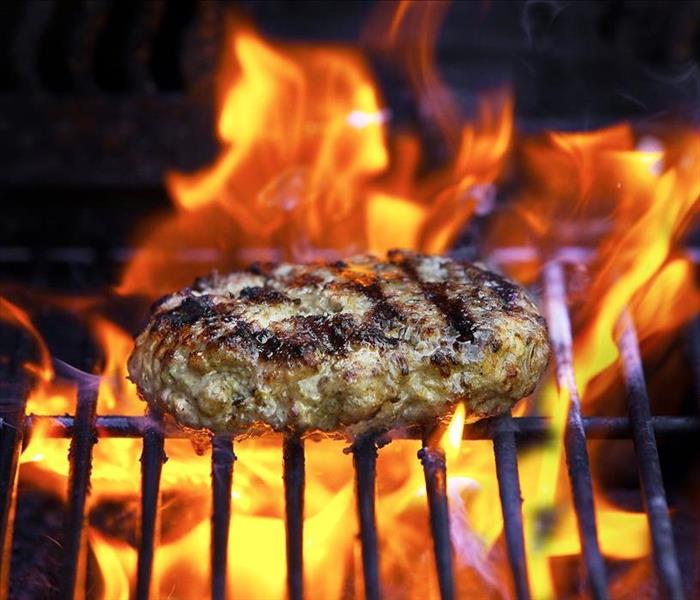 Grilling Season is here!!!!
Grilling Season is here!!!!
The weather is getting nicer, and the urge to grill is getting stronger. To make sure you have a safe grilling season, we will provide a list of safety precautions, such as how to check you gas lines before you start grilling and where to place your grill. Grilling is supposed to be fun and relaxing. Don't let one grilling mistake ruin your summer!
General grilling tips:
- Propane and charcoal BBQ grills should only be used outdoors.
- The grill should be placed well away from the home, deck railings and out from under eaves and overhanging branches.
- Keep children and pets away from the grill area.
- Keep your grill clean by removing grease or fat buildup from the grills and in trays below the grill.
- Never leave your grill unattended.
Before you use your grill:
Check the major connection points between the gas (propane) tank hose and the regulator and cylinder, and where the hose connects to the burners. Tighten if loose.
- Check the gas (propane) tank hose for potential gas leaks. To do that:
- Apply a light soap and water solution to the hose using a brush or spray bottle.
- Turn the propane tank on. If there is a gas leak, the propane will release bubbles around the hose (big enough to see).
- If there are no bubbles, your grill is safe to use.
- If there are bubbles, turn off the tank and check connections If the leaks continue, then have your grill serviced by a professional before using it again.
- If the leak doesn’t stop, call the fire department immediately.
When the grill is on:
- As you are cooking, if you smell gas, turn off the gas tank and burners.
- If the leak stops immediately, get the grill serviced by a professional before using it again.
- If the smell continues, move away from the grill and call the fire department immediately. Do not move the grill.
Charcoal grills
- There are several ways to get the charcoal ready to use. Charcoal chimney starters allow you to start the charcoal using newspaper as a fuel.
- If you use a starter fluid, use only charcoal starter fluid. Never add charcoal fluid or any other flammable liquids to the fire once it starts burning.
- Keep charcoal fluid out of the reach of children and away from heat sources.
- There are also electric charcoal starters, which do not use an open flame. Be sure to use an extension cord rated for outdoor use.
- When you are finished grilling, let the coals completely cool before disposing in a metal container.
By following these steps this will help you have a safe and happy grilling season.
Clouds
4/16/2018 (Permalink)
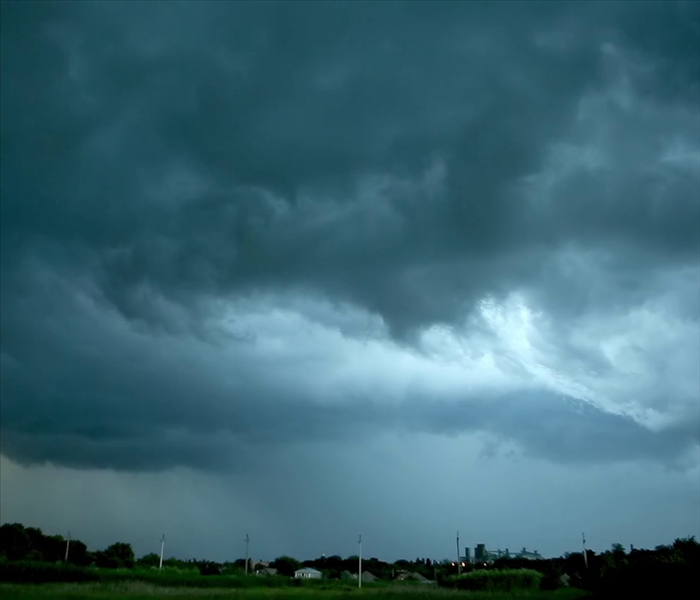 There is all kinds of clouds.
There is all kinds of clouds.
Did you know there are different kinds of clouds that can deliver rain and snow, as well as thunderheads that can produce lightning and heavy precipitation?
Rain/Snow
Stratus clouds are low to mid-level clouds that develop into horizontal, flat formations, and stratus clouds can appear dark and dense or white and puffy. Storm fronts are often preceded or followed by stratus cloud formations carrying precipitation as rain or snow. Because temperatures are warmer closer to Earth and cooler higher up in the atmosphere, low-hanging stratus clouds generally bring rain while higher stratus clouds are associated with snow.
Thunderheads
Cumulus clouds are dense and puffy vertical cloud formations that extend as high as 15,000 meters (50,000 feet) into the atmosphere. Although cumulus clouds are common on sunny, fair-weather days, they earn the moniker of thunderheads because of their tendency to produce thunderstorms. A cumulus cloud becomes a cumulonimbus cloud capable of severe thunderstorms when sufficient heat, updraft and moisture combine in the cloud to produce lightning, thunder and heavy rains.
The next time you see cloud formations in the sky, see if you can figure out what kind it is.
Reasons to Call SERVPRO of Casper for your water damage
4/13/2018 (Permalink)
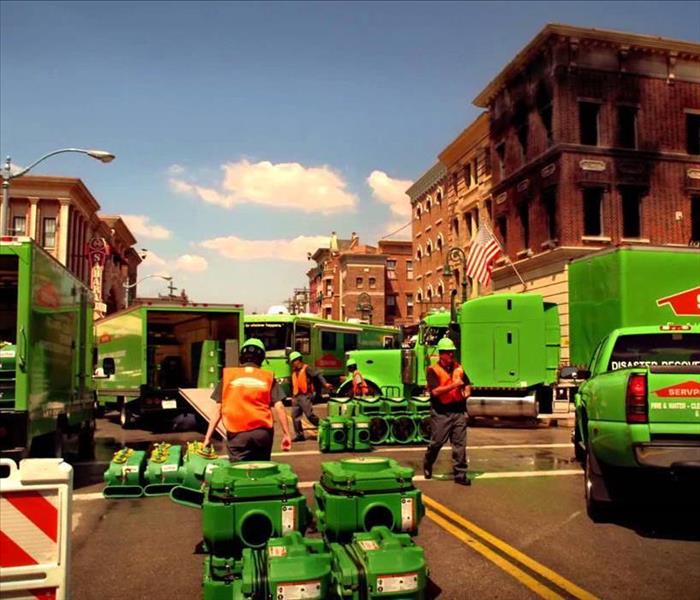 SERVPRO Ready 24/7 365 days a year
SERVPRO Ready 24/7 365 days a year
Why call SERVPRO of Casper for your water damage?
When it comes to restoring your home properly, having well-trained experts on the job is critical.Our team members receive the best training in the industry. We send our employees to IICRC (Institute of inspection Cleaning and Restoration Certification) classes to get them certified as water restoration technicians (WRT). We also go above that and send some of our select technicians to more advanced drying classes, such as Applied Structural Drying (ASD) and Commercial Drying Specialist (CDS). Because the IICRC is the certifying body that establishes and maintains the standard for water damage restoration, it is important that certified technicians are on-site to address your water damage. They can ensure that all standards are met, and that your home is dried safely and effectively.
We have the most up-to-date equipment available in the restoration industry. From moisture meters and thermal imaging to find all of the hidden moisture, to high-efficiency air movers and dehumidifiers to dry it out quickly. We have an arsenal of specialty drying equipment as well, so we can tackle difficult drying projects such as hardwood floors and tile. And in order to ensure the air quality in your home when microbes may be present, we have large-capacity HEPA air filtration devices to scrub the air.
When we arrive at your home, we thoroughly inspect the damage, and discuss our strategy for drying out your property. We explain the steps that we will perform to remove the water, as well as our plan for deploying equipment and starting the drying process. Once we are done with the emergency services portion of the job, we will visit the property daily to monitor the progress of the drying. We check the moisture content of the materials, and the temperature and humidity conditions to ensure optimal drying. As areas gradually become dry, we remove the equipment that is no longer needed, and take all drying equipment out when the process is complete.
By having the right people, tools, and training, the team at SERVPRO of Casper can properly assess the damage in your home, get the water out quickly, and thoroughly dry your property and belongings. Trust our experts to make your water damage “Like it never even happened.”
Commercial Safety Tips
3/28/2018 (Permalink)
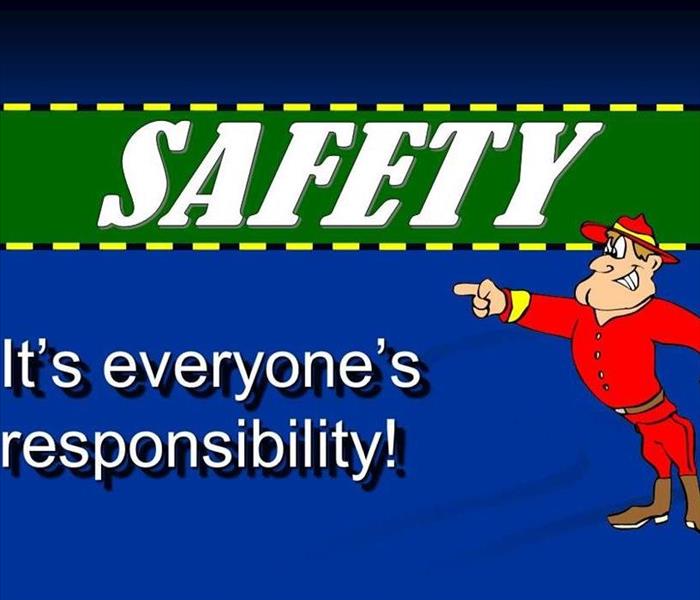 Safety is everyone's responsibility
Safety is everyone's responsibility
Whether you own a business or you’re an employee, safety is everyone’s responsibly. It is important to know where the exits are, where the fire extinguishers are, and how to use them. There are a lot of simple safety measures that can save someone from getting hurt, or worse. Here are a few easy steps to help reduce the risk of accidents:
- Don’t allow trash and litter to accumulate unnecessarily
- Keep the office and dock areas neat and clean
- Know where fire alarm pull stations and extinguishers are located
- Make sure you know the different types of fire extinguishers and how to use them. Check extinguishers periodically to see if they are charged and well-marked.
- Store hazardous materials in designated areas
- Keep exits free of obstruction
- Make sure there are good connections and effective grounds in the wiring
- Smoke only where permitted
- Keep equipment clean and use it properly
- Handle flammable liquids with caution
- Know the proper exits and procedures in case of an emergency
- If you store hazardous materials properly, the chances of fire, spills, and accidents are greatly reduced. A leaking drum of lacquer thinner can be a fire hazard unless the right precautions are taken. Make sure you know the loading and storage chart so you don’t load non-compatible materials on the same trailer or in the same area of the terminal.
- Every terminal should have an emergency plan. In case of fire or other emergencies, procedures should outline who is to call the fire department and how the building is to be evacuated.
- When a fire or emergency evacuation does occur, don’t panic. Keep calm and follow instructions
- Following rules is not just the responsibility of the safety supervisor or the terminal manger, its everyone’s responsibility.
By following these tips, you can help ensure that everyone goes home safe and sound at the end of each work shift.
Never to prepared for a storm
3/13/2018 (Permalink)
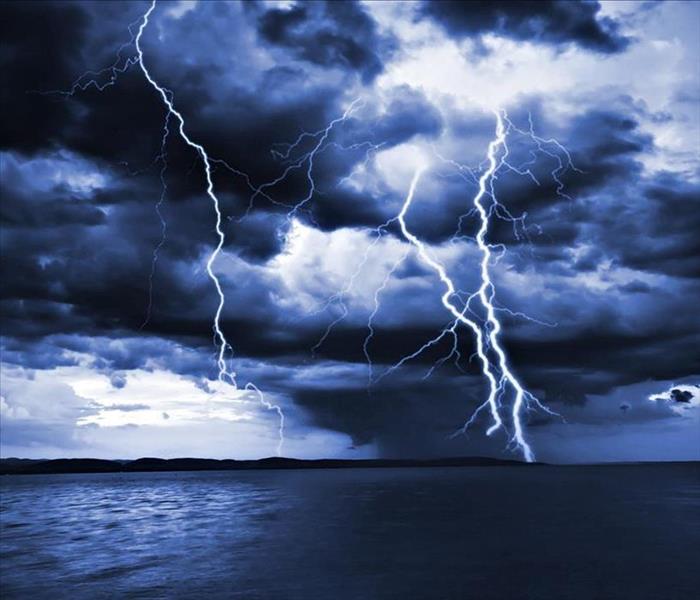 Thunder storm preparedness.
Thunder storm preparedness.
Spring is right around the corner, so it’s a great time to start planning for spring and summer storms. There are many different kinds of storms that can occur during these times of year. Depending on what region of the country you live in, you could potentially be affected by multiple types of storm events. Some areas are more prone to tornadoes or thunderstorms, while coastal areas can be susceptible to hurricanes. You should always be prepared for what could happen to your property, both inside and outside your home. The American Red Cross provides extensive information explaining the different steps you should take to be prepared for a storm.
Here are some tips on what you can do to be prepared:
- Learn about your local community’s emergency warning system for severe
- Discuss thunderstorm safety and lightning safety with all members of your household.
- Pick a safe place in your home for household members to gather during a thunderstorm. This should be away from windows, skylights and glass doors that could be broken by strong winds or hail.
- Make a list of items to bring inside in the event of a severe thunderstorm.
- Make trees and shrubbery more wind resistant by keeping them trimmed and removing damaged branches.
- Protect your animals by ensuring that any outside buildings that house them are protected in the same way as your home.
- Consult your local fire department if you are considering installing lightning rods.
- Get trained in first aid, and learn how to respond to emergencies.
- Put together an emergency preparedness kit.
PPE
1/31/2018 (Permalink)
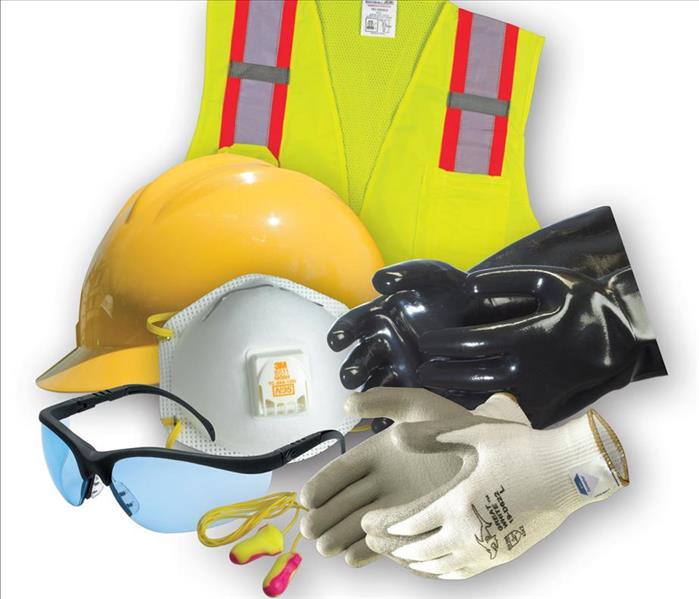 Images of the different types of Personal Protective Equipment.
Images of the different types of Personal Protective Equipment.
Personal Protective Equipment (PPE)
When dealing with mold remediation, it is critical to wear the appropriate PPE (Personal Protective Equipment). Protection of the respiratory system, eyes, and skin is important during mold removal tasks. Depending on the type of job or the specific kind of job site (such as industrial shops), it may be necessary to wear additional protective equipment. These environments can have inherent hazards that require additional protection, such as safety-toed boots, metatarsal protection, and hard hats.
Some of the different types of PPE are:
- Hard hat for overhead impact or electrical hazards
- Eye protection with side shields, or protective goggles
- Gloves chosen for job hazards expected (e.g., heavy – duty leather work gloves for handling debris with sharp edges and/or chemical protective gloves appropriate for chemicals potentially contacted)
- ANSI-approved protective footwear
- Respiratory protection as necessary—NIOSH N95 face pieces may be used for nuisance dusts (e.g., dried mud, dirt and silt). NIOSH P100 respirators are typically used on mold projects to protect against airborne contaminants. Filters with an activated charcoal layer may be used for nuisance odors.
Its best to let the professionals take care of your mold clean up. The professionals at SERVPRO of Casper have the knowledge and training to remediate mold damage safely and effectively.
Smoke Detectors
1/23/2018 (Permalink)
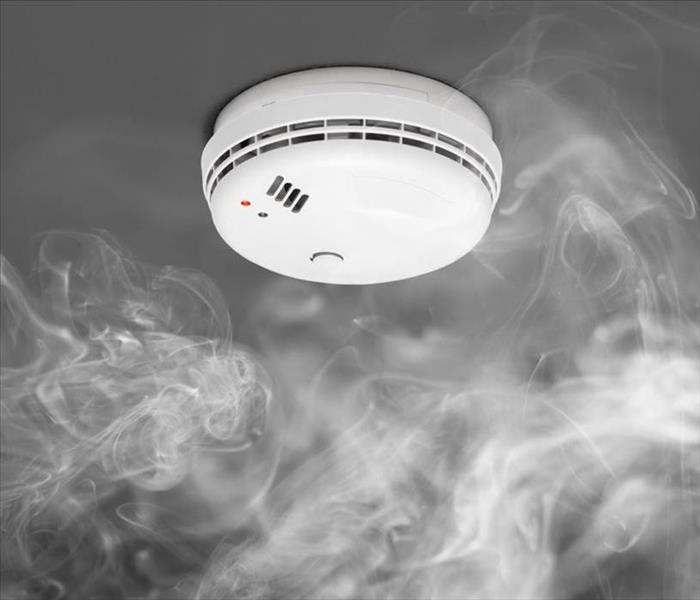 Smoke detectors will help save lives.
Smoke detectors will help save lives.
Whether you’re at home, a hotel, or on a cruise ship, smoke detectors are important to you and your loved ones. They give residents peace of mind, and it helps get people out safely in the event of a fire or smoke emergency.
If they aren’t properly maintained, they can become a nuisance, beeping when the batteries are low. The constant beeping can drive you and others crazy. And they become unreliable in this low-power state.
Here are some quick tips to help keep your smoke detectors in good working order, and your family protected:
- At least one smoke detector should be installed on every level of your home, but it’s best to have one in each bedroom.
- Change the batteries once a year. Changing your batteries in the spring when you do your spring cleaning or on New Year’s Day is easy to remember.
- If you replaced the batteries (and you're sure the batteries are fresh) and your alarm is receiving power but it still won't stop chirping, the detector probably needs to be reset. Disconnect it from the ceiling, remove the battery, and press and hold the test button for 15-20 seconds. The unit should beep several times, and stop. Put the battery back in and reconnect the detector to your ceiling or wall.
- Test your smoke detectors once a month.
- If the alarm doesn't sound when you press the test button, try pressing and holding for 10-20 seconds. If it still doesn't work, the battery could be loose, or your AC or power may not be on (check that the red or green light is continuously lit).
- Make note of your smoke detector install and/or expiration date.
- Alarms don't last forever: the average lifespan of a smoke detector is 10 years. If you aren't sure when it was installed, replace it immediately.
If you end up with smoke damage in your home, SERVPRO of Casper is always here to help.
Preparing for winter storms
1/17/2018 (Permalink)
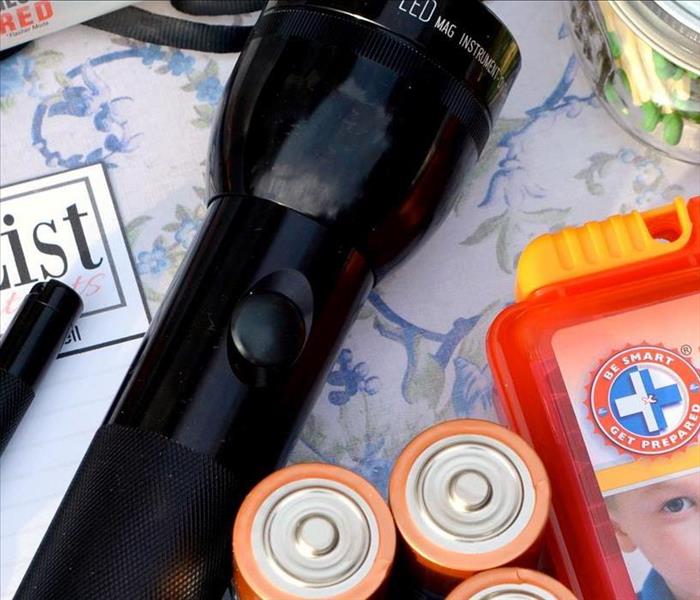 Disaster supply kit
Disaster supply kit
In certain parts of the United States, you have to be prepared for the conditions that come with winter. Conditions can change rapidly, and become hazardous with little to no warning. You should always be prepared whether you’re at home or driving on the roads. A lot of people don’t realize that when you’re at home, there are still risks associated with cold, snowy conditions. If your electricity goes out during a storm, you may run the risk of freezing.
A major winter storm can last for several days, and in some cases, it can have high winds with it. Strong winds and high humidity can create a lower wind chill factor, increasing the risk of frostbite to exposed skin. Winter storms can make driving and walking hazardous. Always listen to the radio and tv for the latest forecast. You should also visit the Wyoming Department of Transportation’s travel information site, at http://www.wyoroad.info , before doing any traveling.
Here are some tips on how to be prepared for a winter storm:
Before a winter storm:
- Have a disaster plan.
- Prepare a disaster supplies kit for your home and car. Include a first aid kit, canned food with opener, bottled water, battery-operated radio, extra batteries, flashlight, protective clothing, and blankets, and matches.
- Be aware of changing weather.
During a winter storm:
- Stay indoors and dress warmly.
- Eat regularly. Food provides the body with energy for producing its own heat.
- Drink water. Also, drink warm broth and juices.
- If you must go outside, wear layered clothing, mittens and a hat.
- Watch for signs of hypothermia and frostbite.
- Keep dry. Change wet clothing to prevent the loss of body heat.
- If you must drive, carry a cell phone with a fully-charged battery.
- Let someone know where you’re going, just in case your car gets stuck.
- If you’re car gets stuck, stay with it and wait for help unless help is visible within 100 yards. Use maps and car mats to stay warm.
After a winter storm
- Avoid driving until conditions have improved.
- Avoid overexertion. Heart attacks from shoveling snow are the leading cause of deaths during the winter.
- Check on neighbors to make sure they are okay.
Your friends at SERVPRO of Casper hope you have a safe and warm winter!!!
Water Categories
12/22/2017 (Permalink)
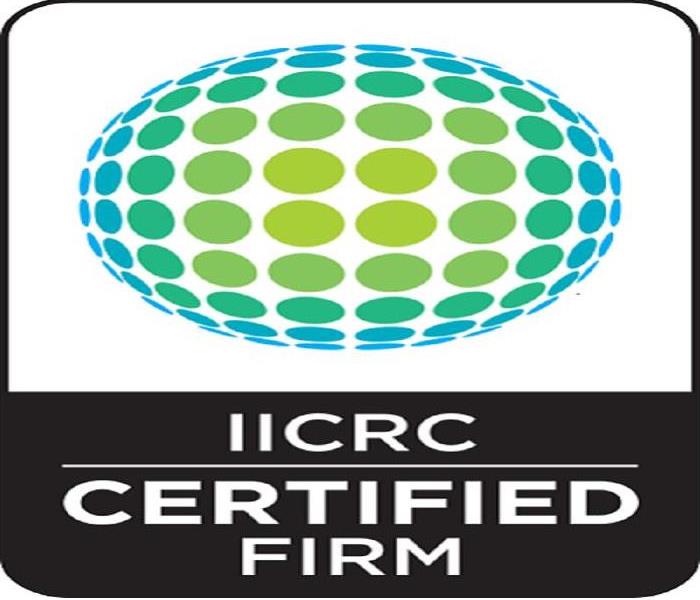 IICRC
IICRC
When hiring a restoration company, you want to make sure that they can take care of your damage properly. It’s always a good idea to make sure the lead technician is IICRC-certified in the type of restoration you are having done (water damage, fire and smoke damage, etc.) It is especially important for water damages. Water damage mitigation that is improperly performed can cause health problems for your family in the future.
It is critical that the company working in your home or office is insured for this type of work, and they perform thorough background checks on their employees. SERVPRO of Casper meets all of these qualifications. With over 30 years of serving the people of Casper, and Natrona and Converse counties, we have developed a strong reputation of honesty and precise, high-quality workmanship.
The industry standard for water damage restoration is ANSI/IICRC Standard S500. There are a lot of technical matters in this standard that must be carefully adhered to. IICRC-certified technicians have been trained on this standard, and can bring your home or office back to a dry, safe, healthy state.
One example of a technical detail in the ANSI/IICRC Standard S500 is determining the category of water in the property. This helps establish the level of contamination in the water, and guides the decisions on what materials can be dried, versus what must be removed and disposed of.
Category 1 – This is a liquid from a clean and sanitary source, like faucets, toilet tanks, drinking fountains and broken pipes. This water has minimal contamination, but must be addressed quickly. If it is not cleaned up in a timely manner, category 1 water can degrade into category 2.
Category 2 – This is often referred to as gray water, and is described as having a level of contaminants that may causes illness or discomfort if ingested. Some sources could be dishwasher, washing machine drainage, sink drains, and toilet overflow that is NOT from beyond the trap, with some urine but no feces. Again, rapid removal and drying is important. Category 2 water that is allowed to dwell for a period of time can degrade into category 3 water.
Category 3 – This category of water is considered to be grossly unsanitary. Often referred to as black water, some sources could include sewer back up, flooding from rivers or streams, toilet overflow from beyond the trap, and stagnant liquid that has started bacterial growth.
SERVPRO of Casper Technicians are IICRC-trained and certified, so they can determine what kind of loss you have and how to properly take care of it so you don’t have any further problems.
Area Rug Cleaning
12/22/2017 (Permalink)
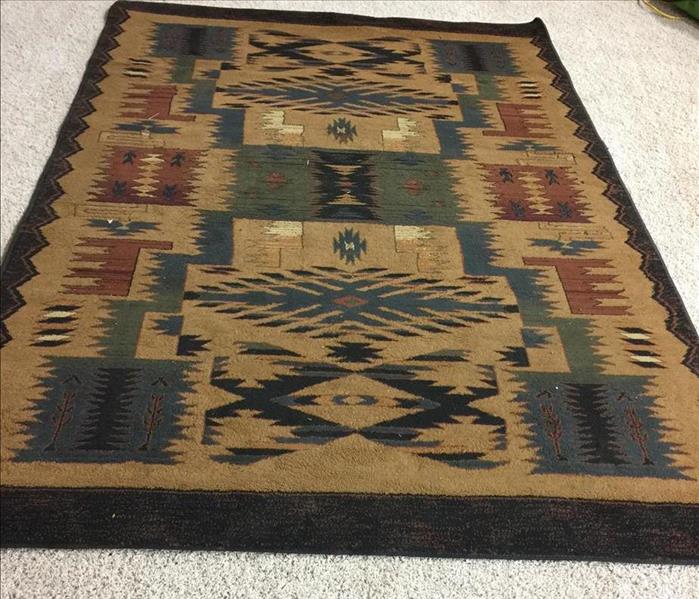 Commercial or Residential Area Rug Cleaning
Commercial or Residential Area Rug Cleaning
Area Rug Cleaning
Home and business owners typically think about the cleanliness of the carpets in their home or office. But area rugs and commercial walk-off mats are often overlooked. Ironically, the rugs and mats usually get more foot traffic than the carpets, and can develop a build-up of deeply-compacted soil. It is important to get them cleaned regularly, to prolong their life. This is especially true of commercial walk-off mats. They are designed to capture outdoor soils from your footwear, so it is not tracked into the building. Cleaning these mats removes the buildup of soiling, so they can be more efficient in keeping the dirt out of your business.
Soil protectant is a great add-on service after rug and mat cleaning. It will make them more resistant to permanent staining when an accidental spill or spot happens. Soil protectant can also prevent ordinary soils from strongly binding to the rug or mat fibers, making them more responsive to cleaning. It’s a great way to protect your investment!
Whether it’s a sturdy commercial mat, or a delicate oriental rug, the professionals at SERVPRO of Casper have the tools and training to keep them looking their best. Call us at 307-235-6558 for a free evaluation and estimate.
Frozen Pipes Part 1
12/21/2017 (Permalink)
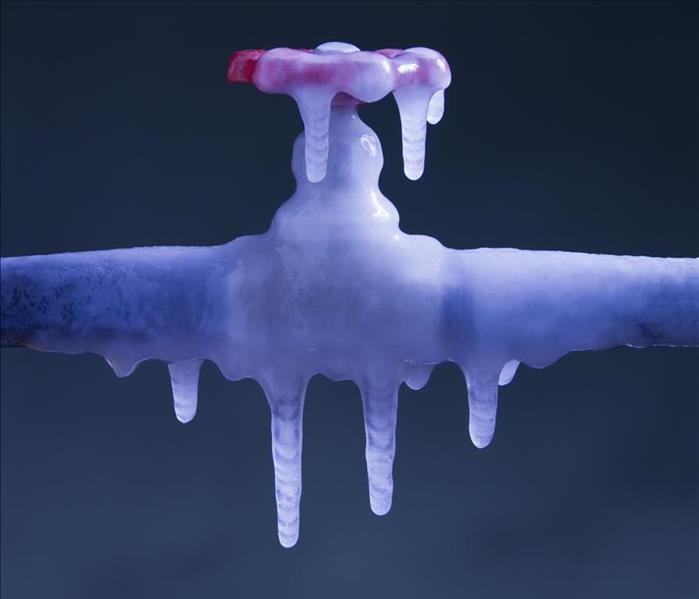 Freezing Temperatures in Casper Wyoming
Freezing Temperatures in Casper Wyoming
Frozen Pipes
Sometimes, customers don’t understand why their pipes break after there was frozen water in them. The reason is that water expands when its frozen, exerting a lot of pressure on the pipe that is holding it. With the water expanding in the pipe, it causes it to split and break.
The pipes that are more likely to freeze are:
- Pipes that are exposed to severe cold, such as outdoor hose bibs, swimming pool supply line, and sprinkler lines.
- Water supply pipes in unheated interior area like basement and crawl spaces, attics, garages, or kitchen cabinet.
- Pipes that run against exterior walls that have little or no insulation.
How to Protect Pipes from Freezing
Here are some suggestions on how to protect your pipes from breaking, before the freezing temperatures arrive.
- Drain water from swimming pool and sprinkler supply lines. Follow the manufacturer’s or installer’s directions. Do not put antifreeze in these lines unless directed. Antifreeze is environmentally harmful and is dangerous to humans, pets, wildlife, and landscaping.
- Remove, drain and store hoses used outdoors. Close inside valves supplying outdoor hose bibs. Open the outside hose bibs to allow water to drain. Keep the outside valve open so that any water remaining in the pipe can expand without causing the pipe to break.
- Add insulation to attics, basements and crawl spaces. Insulation will maintain higher temperatures in these areas.
- Check areas where water supply lines are located in unheated areas. Look in the garage, under kitchen and bathroom cabinets. Both hot and cold water pipes in these areas should be insulated.
- Consider installing specific products made to insulate water pipes, such as heat tape, pipe sleeve, and heat cable. Newspaper can provide some insulation and protection.
- Consider relocating exposed pipes to provide increased protection from freezing.
Frozen Pipes Part 2
12/21/2017 (Permalink)
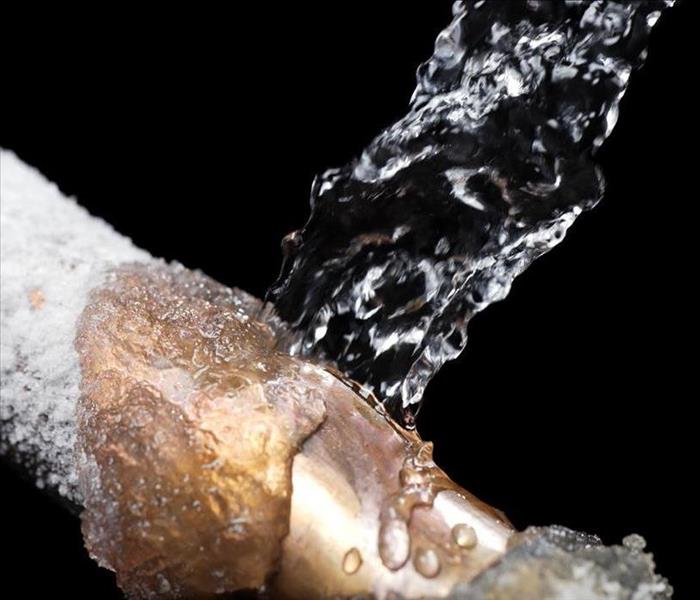 Frozen pipes in Casper Wyoming
Frozen pipes in Casper Wyoming
How to prevent Frozen Pipes
- Keep garage doors closed if there are water supply lines in the garage
- Open cabinet doors to kitchen and bathroom, and if there is a sink in the laundry room, to allow warm air to circulate around the plumbing. Remember, by opening the cabinet doors, you are exposing all the harmful chemicals stored in these areas. Be sure to move them away from kids and pets.
- When the weather is at freezing temperatures, let cold water drizzle from the faucet served by exposed pipes. Doing this helps prevent pipes from freezing.
- Keep the thermostat set to the same temperature (70 degrees) during the day and night. Your heating bill may be higher, but you can prevent a much more costly repair job if pipes freeze and burst.
- If you will be going away during cold weather, leave the heat on in your home, set to a temperature no lower than 55 degrees.
How to Thaw Frozen Pipes
- If you turn on a faucet and only a trickle comes out, suspect a frozen pipe. Likely places for frozen pipes include against exterior walls or where your water service enters your home through the foundation.
- Keep the faucet open. As you treat the frozen pipe and the frozen area begins to melt, water will begin to flow through the frozen area. Running water through the pipe will help melt ice in the pipe.
- Apply heat to the section of pipe using an electric heating pad wrapped around the pipe, an electric hair dryer, a portable space heater (keep away from flammable materials), or by wrapping pipes with towels soaked in hot water. Do not use a blowtorch, kerosene or propane heater, charcoal stove, or other open flame devices.
- Apply heat until full water pressure is restored. If you are unable to locate the frozen area, if the frozen area is not accessible, or if you cannot thaw the pipe, call a licensed plumber.
- If you have a frozen pipe it’s a good idea to check the others. Weather that is cold enough to freeze a single pipe will often freeze multiple pipes in the structure.
Holiday Decoration Safety Tips In Casper, WY
12/12/2017 (Permalink)
 Holiday Decorations
Holiday Decorations
With the holiday season, we all get excited about the cooking, baking, and setting up Christmas decorations. But unfortunately, with all the excitement we become complacent, and we don’t think of safety first.
According to the US Consumer Product Safety Commission there were 15,000 injuries related to holiday decorations in 2012. Mishaps send about 250 people to the emergency room daily, with falls, cuts and back strains topping the list of injuries. To ensure you have a safe, healthy, and happy holiday season with your friends and family, here are 12 tips to keep in mind as you deck out your home:
- Keep live trees away from heated sources – Keep your tree from heated sources such as fireplaces and heaters. It’s a good idea to keep a fire extinguisher near your tree. Live trees are highly flammable because of the needles and sap.
- Hydrate your tree - When picking your tree you want to pick the greenest one. It’s one way to keep your tree from drying out so quickly. Make sure you check it every other day to make sure the water does not run out. A dried out tree is more flammable then a hydrated one.
- Artificial tree - When purchasing an artificial tree you want to make sure that it’s labeled “fire resistant.” Artificial trees that are fire resistant have a low chance of catching on fire.
- Burning wrapping paper in the fireplace - Paper can catch fire very quickly and cause a flash fire.
- Work as a team - When stringing lights and decorations higher than you can reach, make sure you use a proper ladder and someone supporting the base.
- Double check your lights - Check and replace any lights that may have frayed wires, broken sockets, and loose connections. Make sure you don’t put indoor-rated lights outside; you want to check the label to see if they are designed to be hung outdoors. You want to make sure that you don’t string too many lights together so you don’t over strain the cords and cause a fire.
- Power down at the end of the night – Turn off all your lights before going to bed. It’s also a good idea to do that before you leave your home. In case of an electrical short, you can avoid significant damage when caught in time.
- Prevent electrical cord damage – Don’t mount electrical cords in areas that are at a high risk of crimping or damaging the cord. When hanging them, make sure you use hooks or insulated staples instead of nails or tacks.
- Secure candles – When buying candles, it is best to buy them in a glass container with a lid. Make sure candles are placed on a sturdy platform to help prevent tipping. Always snuff out the candles before leaving your home or going to bed.
- Use unbreakable ornaments – If you have fragile ornaments, place them out of reach of pets and kids.
- Fake food – It’s best to avoid artificial candy or food around pets and children.
- Poisonous plants – Poinsettias are poisonous when eaten, so it’s a good idea to keep them out of reach of kids and pets.
Happy Holidays from all of us at SERVPRO of Casper!
Smoke Damage
12/12/2017 (Permalink)
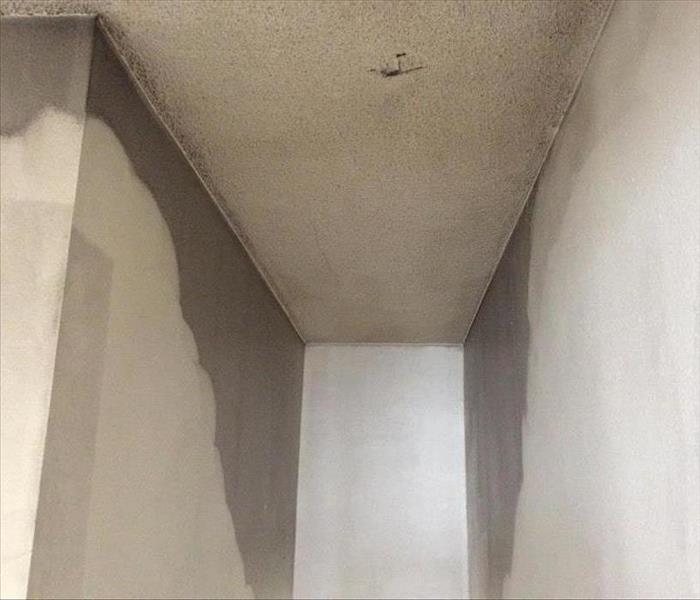 Smoke Damage in Casper, WY
Smoke Damage in Casper, WY
Smoke has many interesting characteristics, such as where it travels and how easily it is able to penetrate materials. It’s fascinating to learn the different types of smoke and what materials cause it, and the different kinds of cleaning methods necessary for each type. SERVPRO has many different tools, cleaning products, and deodorization methods that are specifically designed to target each type of smoke. Our technicians know which type of product to use, and how to address the little particles of smoke that hide in cracks, corners, and crevices.
SERVPRO of Casper’s trained technicians are experienced in identifying what type of smoke is present, what cleaning method is best for the situation, and what needs to be cleaned. Through the years we have had calls from many customers that have attempted to do the cleaning themselves, They found that smoke cleanup is very challenging, and best left to the professionals for effective restoration. Customers don’t realize all the little stuff that needs cleaned and the areas that are easily missed. They don’t have access to professional smoke removal products, and the deodorization tools to make sure the problem is fully and properly corrected.
The different types of smoke:
Wet Smoke: (Plastics and Rubber materials)
Low heat, smoldering, pungent odor, sticky, smeary. Wet smoke has become more common, as we have ever-increasing amounts of plastic items in our homes. These residues are best cleaned up using “wet” methods, such as liquid cleaners. Pre-deodorizing this type of smoke damage with thermal fogging can aid greatly in the cleaning.
Dry Smoke: (Paper and Wood materials)
Fast burning, high temperatures, fine, dry particles. “Dry” cleanup methods, such as dry-clean sponges, are typically used to remove most of this smoke. Sometimes, additional wet cleaning needs to be done if the smoke is heavily-concentrated.
Protein Fire Residue: (Protein Foods Meats and Beans)
Discolors paints, and varnishes, extreme pungent odor. This is the most difficult type of smoke to effectively deodorize. Wet-cleaning with grease-cutting additives is necessary. Multiple methods of deodorization, including activated oxygen (ozone) are also necessary.
Fuel Oil Soot: (Furnace Puff Backs)
Fuel-oil furnaces are rare in Wyoming, so puff-backs do not occur often. Cleanup of this type of smoke requires special products to break down the oily residue. In most cases, we can restore the contents and structure quickly.
Other Types: Tear Gas, Fingerprint Powder, Fire Extinguisher Dust)
Each particular loss requires special care. SERVPRO technicians understand how to identify these specialty residues, and remediate them on a case-by-case basis.
If you should have smoke damage in your home or business, call SERVPRO of Casper today. We will assess the damage, and develop a plan to restore your property quickly and effectively.
Carpet Cleaning Maintenance
8/7/2017 (Permalink)
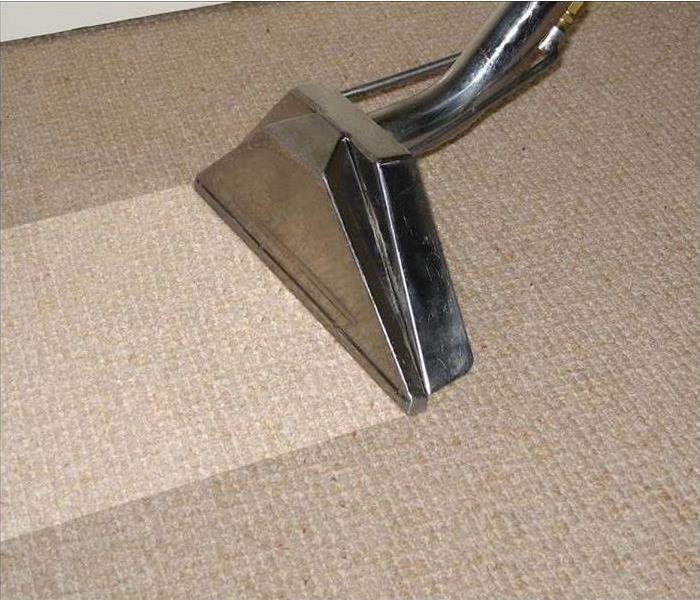 Carpet Cleaning
Carpet Cleaning
When most people hear the name “SERVPRO”, they think of our fire and water cleaning and restoration services. But did you know that we have been cleaning carpets and upholstery in the Casper area for over 30 years? These services are just as important to the upkeep of a home, and don’t require an emergency to give us a call!
There are many benefits to maintaining carpets:
- Increases the life span of your carpet.
- It is typically necessary to keep your carpet warranty valid.
- Enhances the appearance of any room.
- Removes dust mites that may have found a home.
- Removes spots and stains.
- Makes carpeting look and feel clean and fresh.
Properly cleaning your carpets regularly is good for your health:
- Protects indoor air quality. Carpets trap airborne pollutants. By cleaning the carpet, you are removing the pollutants, protecting the carpet and the indoor air quality.
- Prevents buildup of allergens and bacteria. Soiling of carpets can build up several unhealthy contaminants.
- Improves worker morale in commercial settings. Workers feel better about their work environment when their area is clean.
At SERVPRO of Casper, we can handle light to heavy soiled conditions on your carpet. It is recommended that residential cleaning gets done at least once every 12 months, or possibly more depending on the traffic. Commercial buildings should have their carpets cleaned every six to twelve months, also depending on the traffic. Carpets should be cleaned before they become too heavily soiled. If you wait too long, the carpets may not restore to an acceptable condition. After your carpet cleaning is done, we recommend soil protectant be applied. Soil protectant keeps soils from tightly binding to carpet fibers, so the next cleaning is more effective. It also makes the carpet more resistant to staining, so spills can be easily cleaned up. Our spotting kits also help with these spills. They contain four different products that can handle unexpected spots and spills between your regular carpet cleanings.
With our decades of experience in carpet cleaning, we can help keep your home or business looking its very best. We have all the up-to-date equipment and cleaning products to take care of your carpet cleaning needs. Whether you need just a few rooms cleaned, or an entire house or office, the professionials at SERVPRO of Casper have you covered. Call us for a free estimate at 307-235-6558.
Fire Safety for Kids
8/7/2017 (Permalink)
 You can never be to careful when it comes to fire safety.
You can never be to careful when it comes to fire safety.
When it comes to potential emergencies, the first thought many people have is “It will never happen to me”. But the reality is that we never really know if an incident will happen to us, or how severe it will be. Whether it’s a medical emergency, a water damage, or even a fire, you should always be prepared for anything, and practice active prevention. You don’t want to wait until after something happens, wishing that you could have done things differently. Every year, fires are caused by children playing with matches or lighters. Some of these fires happen in grassy fields, while others happen inside homes. All of these fires are preventable. We will share some information on escape plans, and some fire safety tips.
When creating an escape plan in your home, you should go over it with your children so they know how to get out the house. Kids typically don’t think about how they would escape from their home in a fire, so this is an important discussion to have with them.
- Have a plan in place for children that cannot get out on their own, such as infants and toddlers. Talk about which family member is going to wake up the children and help them get out.
- Always identify two different ways out of every room. You should know multiple ways to exit in every room in case one exit is blocked, or it is too dangerous to use.
- Choose a destination outside the house to meet, a safe distance away. This could be across the street, or at a neighbors’ home.
In addition to fire prevention with children, there is the concern of burn prevention. In many instances of fires started by children, serious burn injuries can occur. Here are some tips to help keep your kids safe from fire and burns.
- Children should be at least 3 feet away from anything hot. Stoves, space heaters, and curling irons are all good examples where additional caution is necessary.
- Keep any kind of smoking materials away and placed up high, such as lighters and matches.
- Never play with matches or lighters when your children are around. If they see adults doing this, they will think that it is okay, and possibly even fun.
Accidents can happen at any time. But with some mindful planning, many of these can be completely avoided. If something should still happen, just know that SERVPRO of Casper is here to help anytime. Call us, day or night, at 307-235-6558.
Drapes and Blind Cleaning
7/26/2017 (Permalink)
 Cleaning Drapes and Blinds are important too.
Cleaning Drapes and Blinds are important too.
Drapery and Blind Cleaning
Most people are familiar with our fire and water cleanup services. Some are also aware that we provide additional services such as mold cleanup, upholstery cleaning, and carpet cleaning. But did you know that we clean window blinds and drapery? Sometimes, when Spring cleaning is being done, the window coverings in a home get overlooked. It’s actually pretty important to make sure those items do get cleaned every 2 years. Customers will ask “When should my drapes be cleaned?”
- It is best if drapes are cleaned every 2 years.
- Depending on the heating system, smokers in the home, and other factors, drapes may not show soil for two to six years. They should be cleaned before they are visibly soiled.
- Oily atmospheric soil will gradually cause the fabric to deteriorate.
- You could triple the life of your life draperies through professional cleaning, which is inexpensive compared to replacement costs.
When you are searching for a company, be very selective on your choice of professional dry cleaners. Make sure your drapes are dry cleaned ONLY! Some drycleaners have machines that are designed for clothes, while others have equipment are designed for drapes only. The best thing about hiring a company like SERVRPRO of Casper is that we can dry clean your drapes on-site while they are hanging up. You don’t have to take your drapes down to send them to the cleaners. And your home won’t feel like a “fishbowl” without any coverings on the windows!
In order to clean blinds, we take them down, bring them back to our shop and process them through our ultrasonic machine. Ultrasonic cleaning is a process that uses a tank of water, high-frequency sound waves, and specialized detergents. The sound waves agitate every hard-to-reach surface on the blinds to loosen soils, and the detergent suspends the soils off of the blinds. Cleaning can take anywhere from three to six minutes, depending on the level of soiling. Once the blinds are cleaned, we return them to the house and hang them back up.
Drapes and blinds collect a lot of nasty stuff over time. It is better to get them regularly serviced than let them collect too much soil. If they become excessively dirty, it becomes harder for the technicians to clean and it may not be possible to fully restore them.
We always offer free estimates. Call your local franchise, SERVPRO of Casper, today! 307-235-6558
Hot Weather Safety Tips
7/18/2017 (Permalink)
 You never want to assume when it comes to pet safety.
You never want to assume when it comes to pet safety.
Pet Hot Weather Safety Tips
Pet owners are spending more time outside with their pets in the summer. But the hot weather can be very dangerous for your furry friend. To prevent your pet from overheating, here are some simple precautions.
- Pets can get dehydrated quickly; make sure they have plenty of fresh, clean water whether it’s hot or humid outside. Make sure there are shady areas for your pets so they can get out of the sun. Don’t over-exercise them, and keep them inside when it’s extremely hot.
- Make sure you know the symptoms of overheating in your pet:
Excessive panting
Difficulty breathing
Increased heart and respiratory rate
Drooling
Mild weakness
Stupor or collapse
Extreme symptoms:
Seizures
Bloody diarrhea
Vomiting
Elevated body temperature of over 104 degrees
Animals with flat faces, like Pugs and Persian cats, are at a higher risk of having a heat stroke. It’s because they can’t pant as effectively. Pets that have flat faces, elderly, overweight, or has heart or lung disease, should be kept in areas that are air-conditioned as much as possible.
NEVER leave your pets alone in a parked vehicle during the summer.
When temperatures are high don’t let your dog linger on hot asphalt. The heat from the asphalt can increase the body temperature; it could also burn the pads on the paws. It’s best to keep walks at a minimum during these times.
Fire and Grilling Safety
7/11/2017 (Permalink)
 Grilling can be a lot of fun if done safely.
Grilling can be a lot of fun if done safely.
Fire and Grilling Safety Tips
Summer is here! We get the opportunity to do a lot of fun outdoor activities that we can’t do in the Winter. Among these activities, a common favorite is grilling. But there is a lot of personal responsibility when it comes to grilling. You need to make sure you are taking all the right safety precautions so you and your family can have good food and fun times, without any accidents.
Here are some Grilling safety tips:
- Propane and Charcoal BBQ grills should only be used outdoors.
- The grill should be placed well away from the home, deck railings and out from under eaves and overhanging branches.
- Keep children and pets away from the grill area.
- Keep your grill clean by removing grease or fat buildup from the grills and in trays below the grill.
- Never leave your grill unattended.
Before you use your grill:
- Check the major connection points between the gas (propane) tank hose and the regulator and cylinder, and where the hose connects to the burners. Tighten if loose.
- Check the gas (propane) tank hose for potential (gas) leaks.
- Apply a light soap and water solution to the hose using a brush or spray bottle.
- Turn the propane tank on. If there is a gas leak, the propane will release bubbles around the hose (big enough to see)
- If there are no bubbles, your grill is safe to use.
- If there are bubbles, turn off the tank and check connections, then have your grill serviced by a professional before using it again.
- If the leak doesn’t stop, call the fire department immediately.
When the grill is on:
- As you are cooking, if you smell gas, turn off the gas tank and burners
- If the leak stops immediately, get the grill serviced by a professional before using it again
- If the smell continues, move away from the grill and call the fire department immediately. Do not move the grill.
Charcoal grills:
- There are several ways to get charcoal ready to use. Charcoal chimney starters allow you to start the charcoal using newspaper as a fuel.
- If you use a starter fluid, use only charcoal starter fluid. Never add charcoal fluid or any other flammable liquids to the fire once it is burning.
- Keep charcoal fluid out of the reach of children and away from heat sources.
- There are also electric charcoal starters, which do not use fire. Be sure to use an extension cord rated for outdoor use.
- When you are finished grilling, let the coals completely cool before disposing in a metal container.
If something should go wrong, just know that SERVPRO of Casper is here to help anytime. 307-235-6558
Mold Clean Up
7/11/2017 (Permalink)
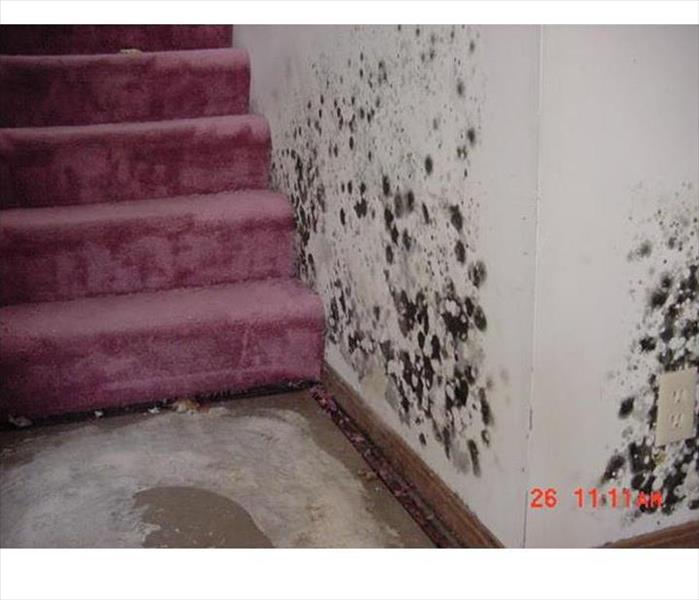 SERVPRO of Casper specialize in mold clean up.
SERVPRO of Casper specialize in mold clean up.
There is a common misconception that when a homeowner finds black mold in their home, that they “have the black mold”. They believe that it is mold from the Stachybotrys genus (as made infamous in various news reports), but that’s not always the case. There are over 250,000 different species of mold that have been identified by scientists, and the color of the mold is not a reliable indicator of its species.
Regardless of the specific type of mold that is present, the handling and cleanup procedures remain the same. There are 7 easy steps to safe, successful mold removal:
Step 1 – Call a professional company that has been trained and has Applied Microbial Remediation certification through the IICRC.
Step 2 – Inspection and Mold Damage Assessment – a thorough inspection to determine the extent of mold presence. In some situations, it may be necessary to have testing performed by a Certified Industrial Hygienist. They are the professionals that are qualified to perform scientific mold testing. An Industrial Hygienist will write a remediation protocol after testing. It is essentially a “playbook” with their recommended steps to properly address the mold problem.
Step 3 – Mold Containment – A containment with negative air pressure is set up in the contaminated area. This prevents the mold spores from spreading to other areas in the building.
Step 4 – Air Filtration – HEPA filters are used as part of the negative air pressure system. These filters capture the mold spores out of the air.
Step 5 – Removing Mold and Mold-Infested Materials – Certain contaminated materials, such as drywall, are bagged and disposed of. Mold is removed from wood framing and other surfaces through a variety of methods, including HEPA vacuuming, sanding, and cleaning.
Step 6- Cleaning Contents and Belongings – Your personal belongings are evaluated, and handled item-by-item. Some items may not be restorable, and will need to be disposed of. Others can be cleaned using antimicrobial products, HEPA vacuuming, or possibly laundering.
Step 7 Restoration – Once the mold has been removed and cleaned up, the property can be put back together. We have multiple contractors in the Casper area that specialize in restorative construction.
If you think you have mold in your home or office, feel free to give SERVPRO of Casper a call at 307-235-6558. We have highly-trained staff that is certified through the IICRC, and ready to help you. We can make the mold problem in your home or commercial building “Like it never even happened.”
Emergency Services
5/3/2017 (Permalink)
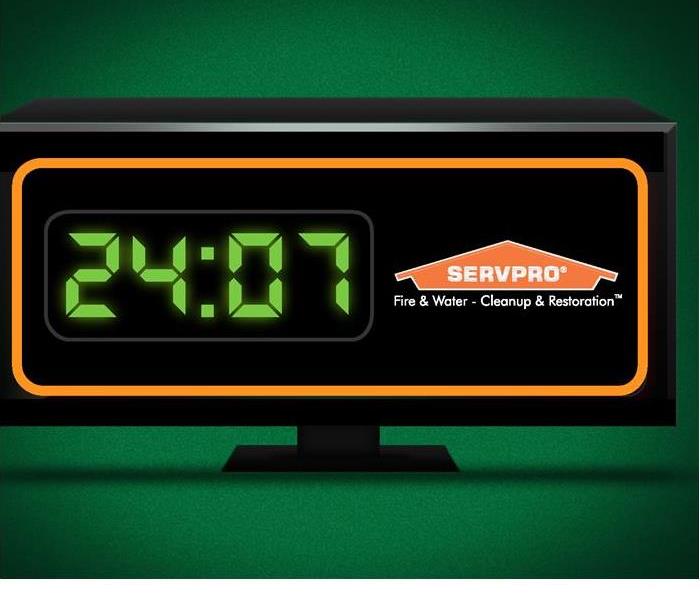 SERVPRO of Casper 24/7 Emergency Services
SERVPRO of Casper 24/7 Emergency Services
SERVPRO of Casper provides 24-hour emergency service. We have the training, equipment, and expertise to handle your water and fire emergencies. SERVPRO of Casper is dedicated to being faster to any-sized disaster in Casper, Douglas, and our surrounding towns. We can respond immediately to your emergency, and have the knowledge and resources to handle your restoration or cleaning needs.
Benefits we provide:
- 24-Hour Emergency Service
- Faster to Any-Sized Disaster
- Highly Trained Restoration Technicians
- A Trusted Leader in the Restoration Industry
- Locally Owned and Operated for Over 30 Years
- Advanced Restoration and Cleaning Equipment
- Over 30 Years of Service to Central Wyoming
If you have any questions, or need assistance, SERVPRO of Casper is here for you 24 hours a day, 365 days a year. 307-235-6558
Home Carpet and Upholstery Spotting Kit
5/1/2017 (Permalink)
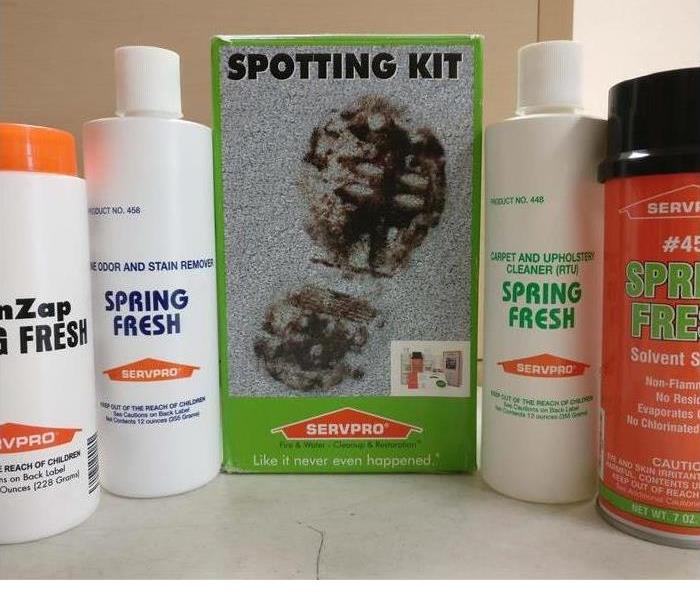 SERVPRO Spotting Kits
SERVPRO Spotting Kits
Professional carpet and upholstery cleaning is important to the life and appearance of your home and furnishings. But what about those little spills and mishaps that occur when you least expect them? SERVPRO of Casper sells a spotting kit to keep your carpets and upholstery looking their best between cleanings. The products in the kit are the four spotting agents that our professional technicians most frequently use. The kit has 3 refillable bottles and an aerosol can. We provide FREE LIFETIME refills on the three bottles, making this kit an excellent value.
Did you know that some commercial spotting products can actually SET a spot, making it difficult or impossible to remove? Some of these products contain a "stain blocker", designed to provide future soil protection after cleanup. But if you are not able to remove the entire spot, the remainder can be permanently sealed into the carpet by the stain blocker. With SERVPRO's spotting kit, this is not a problem. You are using the same products that the professionals use. If you are not able to remove the entire spot yourself, you can rest assured that you have not caused further harm to your carpet. Just give SERVPRO a call, and we can work on the rest of the problem spot.
The key to successful spot removal is time. The longer a spot sits, the more likely it will result in a permanent stain. Having our spotting kit on the shelf in your home lets you address the spot quickly, so you can protect the investment you have made in your carpets and furniture. This kit also saves you money, by allowing you to deal with removing simple spots, instead of calling out the professionals for these smaller problems.
In the kit you will get:
- StainZap - Is used for the effective removal of water-based stains such as coffee, tea, wine, fruit juice, sauces, grass and blood.
- Solvent Spotter - This blend is developed for removal of oil, grease, tar, gum, wax and paint from fabric.
- Urine Odor & Stain Remover - A mixture of safe, enzyme-producing bacteria is used to eliminate odors such as urine, feces, vomit, spilled foods, mildew, perspiration, skunks, grass stains, and other organic waste.
- Carpet & Upholstery Cleaner (RTU) - A blend of detergents, solvents, and cleaning agents for maximum cleaning of all fabrics. It works well on wool, cotton, nylon, and other synthetics.
- SERVPRO Furnishings Care Book - This care book explains everything you need to know to get rid of the worst stains and keep your carpet looking good. If you need additonal help, we are just a phone call away to answer your questions!
SERVPRO Spotting Slide Rule - An easy-to-use slide rule that gives you step-by-step intructions for a multitude of spot removal situations.
If you need a refill, or want to purchase a kit, feel free to stop by SERVPRO of Casper's office.
IICRC Classifications
1/30/2017 (Permalink)
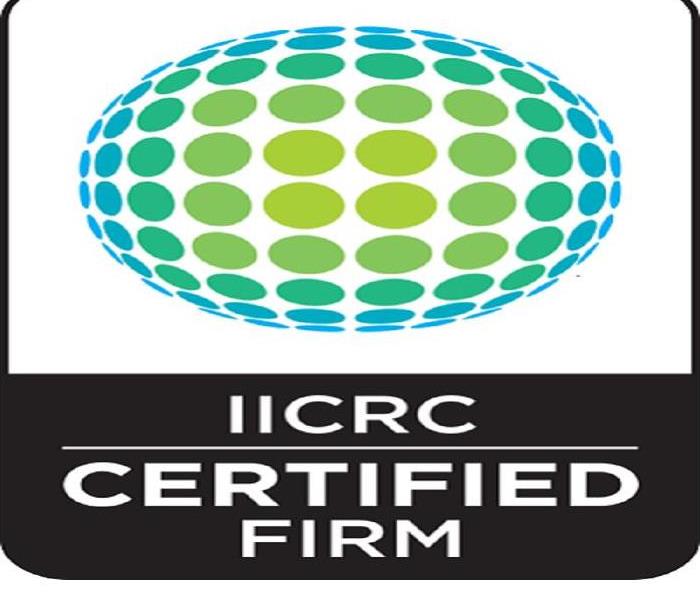 IICRC Certified Firm
IICRC Certified Firm
All water damages are unique in their own way. Many factors can vary, from where it originated to what it has affected. Water seems to have a mind of its own, and its migration patterns through your home or office can be unpredictable. Water loves to follow cracks in the foundation and tack strip. It even likes to hide in paint bubbles. So it's our job as a IICRC Technicians to find where the water is hiding, and figure out what class the loss is.
If you have ever end up having a water damage in your home or business in Casper, Wyoming, or the surrounding towns, SERVPRO of Casper is here for you. SERVPRO of Casper technicians are trained and certified to make sure the job is done right. We have all the latest tools, and technology to locate any water that maybe hidden in your walls or floor. When we arrive at a loss, we go over the extent of the damage, and a step by step process on what we will be doing. We use IICRC (Institute of Inspection Cleaning and Restoration Certification) Classification to determine the significant of the loss.
Here are the different types of IICRC Classifications and what it would mean for you.
Class One: Limited Intrusion
This is the smallest type of water damage you can get. Which is the smallest amount of water in your house. There will be minimal damage to walls, and contents. Depending on the location and the affected materials, just a few air movers and a dehumidifier will be used to dry out your structure.
Class Two: Water Damage with Some Spread
This is when the water has gone and soaked into the walls materials, such as baseboards, drywall, insulation, and concrete. It will have spread through out the room or multiple rooms. The water will have soaked into the floors materials such as carpet, pad, and either wood, or concrete sub-floor. With this kind of loss air movers and dehumidifier will be used to dry out your structure.
Class Three: Large Spread with Heavy Saturation
This is when the all materials such as ceilings, walls, insulation, caret and sub-floors are all saturated. The walls will be we at least 2 feet high. With this kind of loss we would use air movers, a dehumidifier.
Class Four:
This class is for specialty drying. It's for materials that take specialty equipment. Materials such as hardwood floor, brick, stone, and plaster walls. In some cases the drying may take a little bit longer. With this kind of loss we would use air movers, dehumidifier, possibly a floor mat system.
When your home or business has been affected by a water damage. Calling in the professionals at SERVPRO of Casper to respond quickly and assess the loss is an important part of the restoration process. All SERVPRO of Casper crew chiefs are IICRC Certified. Water damages don't care what's going on in your life, or what time of day it is, so we are here for you 24/7, 365 days a year.
307-235-6558.
Winter Safety Traveling Tips
12/13/2016 (Permalink)
 Safety is everyone's job.
Safety is everyone's job.
Winter Traveling Tips:
No matter what job if its from cleaning your carpets or need your water damage mitigated, we will travel to you whether you live in Casper or in another town. With traveling from town to town or even staying local there is always risks especially in the winter. So we here at SERVPRO of Casper train, talk, and check in with our employees, to make sure they have everything they need to be safe on their travels. And so when they are traveling in their own vehicles they know what to do in case of an emergency.
Winter Driving Tips:
- Don't drive while you are fatigued
- Never run your vehicle in an enclosed area, such as a garage
- Be sure your tires are inflated to the right pressure
- Do not use your cruise control
- Use your seat belt every time you get into your car
- Be sure to make sure someone knows where you're going before you leave.
- Be sure your vehicle has a full tank of gas
- Make sure you allow yourself exta time to reach your destination
Stock Your Vehicle:
- Snow shovel, broom, and ice scraper
- Abrasive material such as sand or kitty litter
- Jumper cables, flashlight, and warning devices such as flares, and markers
- Blankets, extra set of clothes and coats
- Cell phone with charger, water, food, and any necessary medicine.
In Case Of An Emergency:
- Stay with you car
- Put bright markers on your antenna or window, keep the interior dome light turned on
- Run your car for short periods of time; just enough to stay warm
You can never be too careful when it comes to traveling in the winter. By following these tips, if an emergency should happen, you will know how to handle it safely.
We here at SERVPRO of Casper want to wish everyone safe travels for the holidays.
Carpet Cleaning in Casper, WY - Why SERVPRO?
6/7/2016 (Permalink)
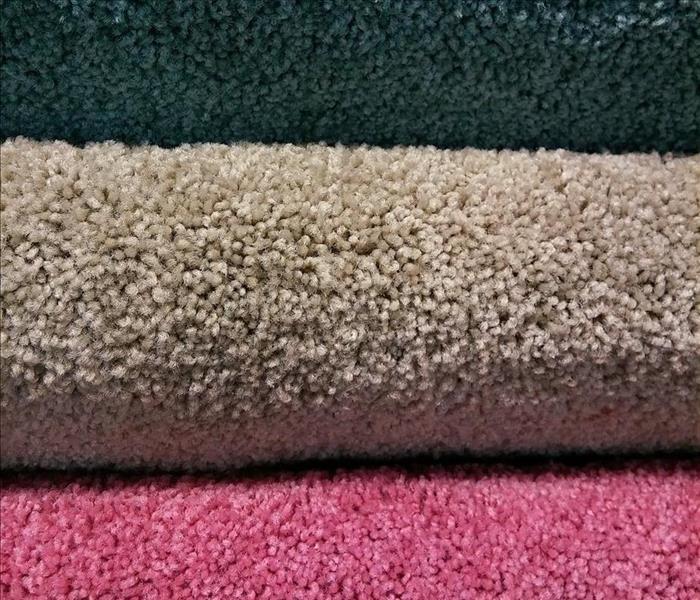 SERVPRO of Casper - the best carpet cleaning option to protect your investment.
SERVPRO of Casper - the best carpet cleaning option to protect your investment.
If you live in Casper, Glenrock, or Douglas, you have multiple carpet cleaning companies available for your needs. But which company is the right one for you?
There are a number of questions to ask when hiring a cleaning professional:
- “How long have you been in business?” The answer can speak volumes about a company’s reputation and experience. SERVPRO of Casper has been serving Casper, Glenrock, and Douglas since 1985.
- “Do you vacuum before deep cleaning the carpet?” The answer should be yes. Vacuuming before deep cleaning is critical and makes a difference in the end result. The professionals at SERVPRO of Casper always pre-vacuum on every carpet cleaning.
- “How is your pricing structured?” Pricing should be based on the area cleaned, not by the number of rooms. Room sizes vary, so be careful of any company that quotes price by the room. SERVPRO of Casper prices your job by the square foot, and factors in the level of soiling, and what furniture you wish to have us move. This is discussed at the time of your free estimate.
- “How much will it cost?” SERVPRO of Casper provides free estimates for every carpet cleaning. No obligation or hard-selling. No surprises, and no gimmicks. Just a solid, fair price. And we don’t just do the estimates in Casper. SERVPRO also provides free estimates to our customers in the Glenrock and Douglas areas, too!
- “Are your technicians certified through the Institute of Inspection, Cleaning and Restoration (IICRC)?” You can rest assured that the SERVPRO technician cleaning your carpet has the latest training, and is equipped with excellent carpet cleaning equipment and supplies.
- “Do you move the furniture or should I have it moved before you arrive? If you move the furniture, do you charge extra?” The professionals at SERVPRO of Casper know that you want a fair price for a quality carpet cleaning. Our estimator will discuss your furniture moving needs, and the pricing for the different options, at the time of your free estimate.
Call the carpet cleaning experts for the Casper, Glenrock, and Douglas areas today!
SERVPRO of Casper – 307-235-6558
Casper, Wyoming Smoke and Soot Cleanup
6/7/2016 (Permalink)
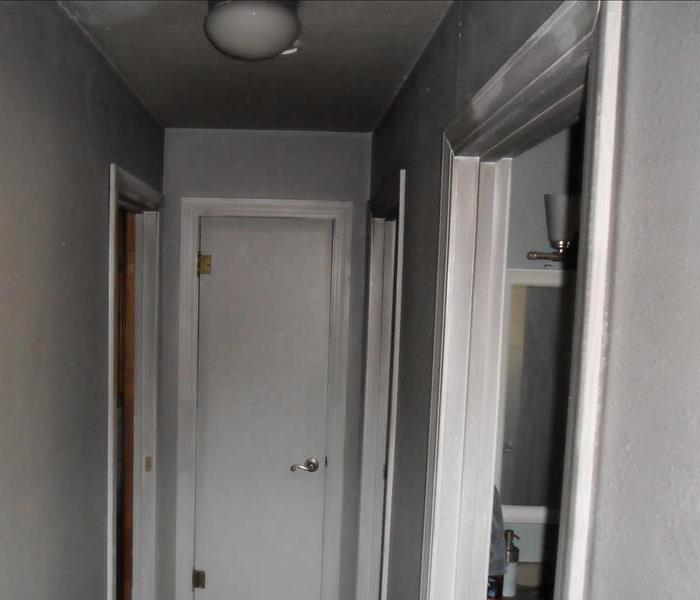 Smoke and Soot Damage Can Cause a Pervasive Odor in Your Casper Home.
Smoke and Soot Damage Can Cause a Pervasive Odor in Your Casper Home.
Smoke and soot is very invasive and can penetrate various cavities within your home, causing hidden damage and odor. Our smoke damage expertise and experience allows us to inspect and accurately assess the extent of the damage to develop a comprehensive plan of action.
Smoke and soot facts:
· Hot smoke migrates to cooler areas and upper levels of a structure.
· Smoke flows around plumbing systems, seeping through the holes used by pipes to go from floor to floor.
· The type of smoke may greatly affect the restoration process.
Different Types of Smoke
There are two different types of smoke–wet and dry. As a result, there are different types of soot residue after a fire. Before restoration begins, SERVPRO of Casper will test the soot to determine which type of smoke damage occurred. The cleaning procedures will then be based on the information identified during pretesting. Here is some additional information:
Wet Smoke – Plastic and Rubber
· Low heat, smoldering, pungent odor, sticky, smeary. Smoke webs are more difficult to clean.
Dry Smoke – Paper and Wood
· Fast burning, high temperatures, heat rises therefore smoke rises.
Protein Fire Residue – Produced by evaporation of material rather than from a fire
· Virtually invisible, discolors paints and varnishes, extreme pungent odor.
Our Fire Damage Restoration Services
Since each smoke and fire damage situation is a little different, each one requires a unique solution tailored for the specific conditions. We have the equipment, expertise, and experience to restore your fire and smoke damage. We will also treat your family with empathy and respect and your property with care.
Have Questions about Fire, Smoke, or Soot Damage?
Call Us Today – 307-235-6558
Casper, Wyoming 24 Hour Emergency Water Damage Service
6/7/2016 (Permalink)
 SERVPRO of Casper provides 24 hour fire and water damage restoration service in Casper, Glenrock, and Douglas.
SERVPRO of Casper provides 24 hour fire and water damage restoration service in Casper, Glenrock, and Douglas.
SERVPRO of Casper is available 24 hours a day for water emergencies, large or small. When you are dealing with a flooded basement, home, or office, immediate action is crucial. A delay of just a few hours can greatly increase the severity of the water damage.
We Answer the Phone Ready to Help
Call Today – 307-235-6558
We understand that when you call us, you may be feeling confused, stressed, and vulnerable. You need an expert to guide you through this crisis. SERVPRO of Casper has the specific water damage training and experience to help you through this tough time. We specialize in water damage restoration—in fact, it's the cornerstone of our business.
What to Expect
When you call, we will ask several questions regarding your water damage emergency. These questions will help us determine what equipment and resources to bring, including how many trained SERVPRO Professionals may be needed.
Our SERVPRO Representative will ask several questions:
· Your name and contact information
· Your insurance information (if applicable)
· The street address of the water-damaged home or business
· When did the flooding or water damage occur?
· What caused the water damage (if known)?
· Is there electricity available (on-site)?
About SERVPRO of Casper
SERVPRO of Casper specializes in the cleanup and restoration of residential and commercial property after a fire, smoke or water damage event. Our staff is highly trained in property damage restoration. From initial and ongoing training at SERVPRO’s corporate training facility to regular IICRC-industry certification, rest assured our staff is equipped with the knowledge to restore your property.
Carpet Cleaning in Casper, WY
6/7/2016 (Permalink)
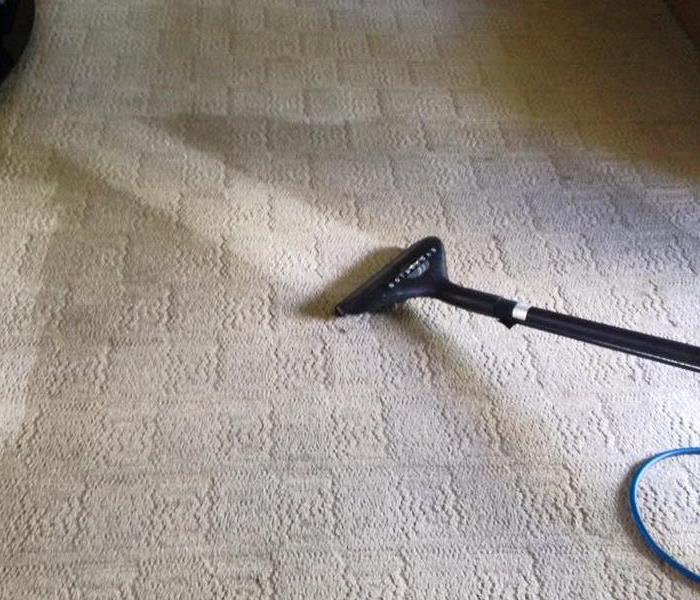 Carpet cleaning in progress, in a home in Casper, Wyoming.
Carpet cleaning in progress, in a home in Casper, Wyoming.
Even the highest-quality carpet and upholstery can show soiling over time. Protect your investment by calling us to clean and maintain your carpet and upholstery. The SERVPRO System offers a number of cleaning options to match any type of upholstery or carpet. We provide our carpet cleaning services throughout Natrona and Converse County, to include Casper, Glenrock, and Douglas.
Need Carpet or Upholstery Cleaning?
Call Today – 307-235-6558
We also offer a range of specialized cleaning methods:
Bonnet Cleaning: A less aggressive method for short piled carpets.Hot Water Extraction: A deeper cleaning method for all carpet types.Deluxe Precondition and Rinse: Helps restore deeply soiled areas.Showcase Premier Cleaning: The most thorough cleaning method in the industry.Dry Cleaning: When color-fastness is an issue. SERVPRO® of Casper – We help to make it "Like it never even happened.®"
We have been cleaning carpets and upholstery in the Casper area since 1985. With that much experience, you can trust that your carpets and fine upholstered furniture are in the best of hands.
If you live in Casper, Douglas, Glenrock, or any of the other communities in the Natrona and Converse County areas, and you are considering carpet cleaning, give us a call! Our estimates are always free, with no obligations or unwanted surprises.
Casper Experts in Carpet Cleaning, Water Damage Restoration, Fire Damage Restoration, Water and Fire Cleanup and Restoration.
Why Choose SERVPRO?
6/7/2016 (Permalink)
 The team at SERVPRO of Casper. Ready when you need us.
The team at SERVPRO of Casper. Ready when you need us.
Why Choose Us?
Faster To Any Size DisasterFlooding and water emergencies don’t wait for regular business hours and neither do we. SERVPRO of Casper provides emergency cleaning and restoration services 24 hours a day, 7 days a week—including all holidays. You can expect an immediate response time for your flooded basement, day or night. Rapid response to Casper, Glenrock, Douglas – Anywhere in Natrona and Converse counties! And in some cases, we can travel to farther areas in Wyoming.
Highly Trained TechniciansOur staff is highly trained in property damage restoration. From initial and ongoing training at SERVPRO’s Corporate Training Facility to regular IICRC industry certifications, rest assured our staff is equipped with the knowledge to restore your property.
Advanced TechnologyThe past few decades has seen a rapid advancement in the technology and techniques used in the restoration industry. These advancements allow SERVPRO of Casper Professionals to restore a property back to pre-loss condition quickly, reliably, and more effectively.
Call Us 24/7 – 307-235-6558 SERVPRO® of Casper




 24/7 Emergency Service
24/7 Emergency Service



























































































































































